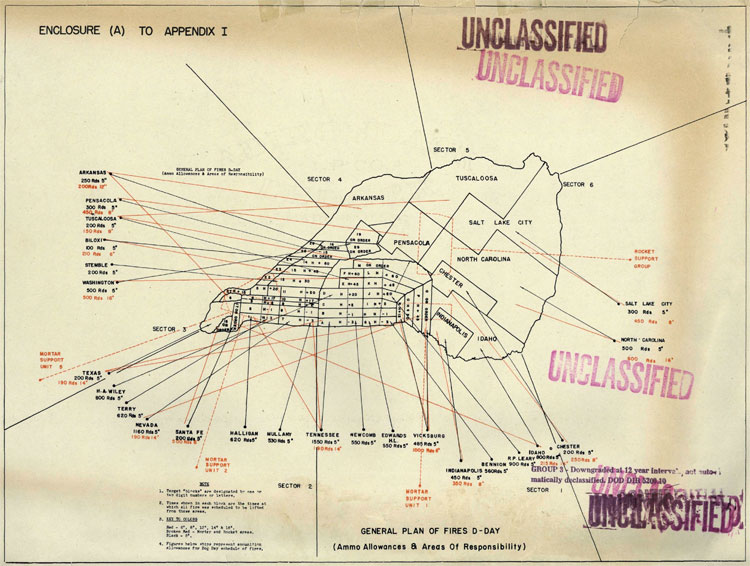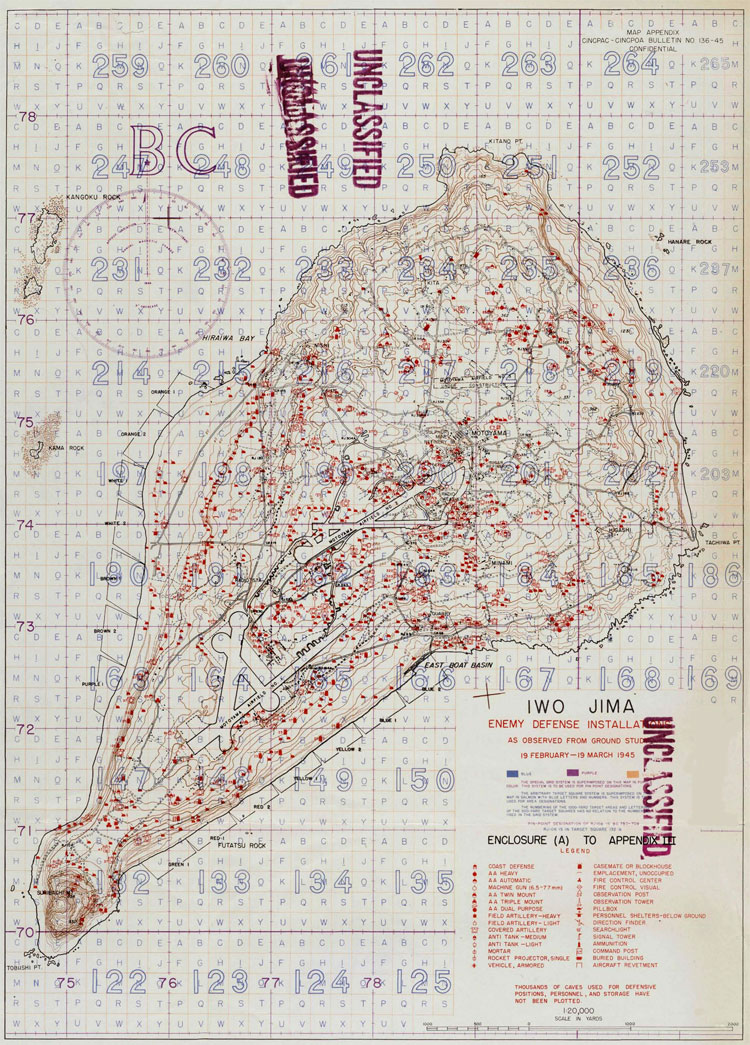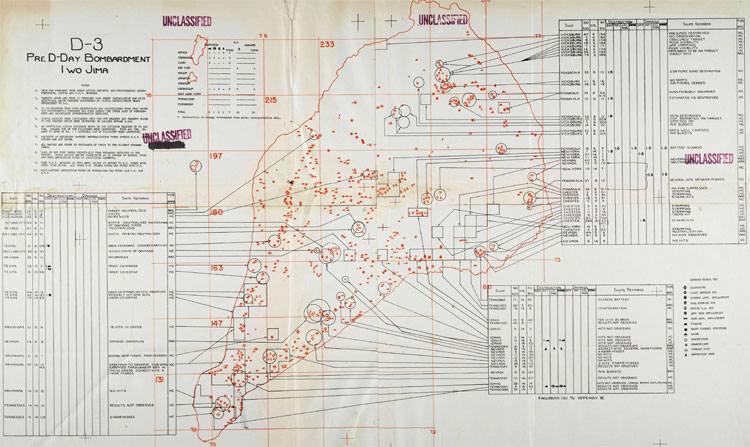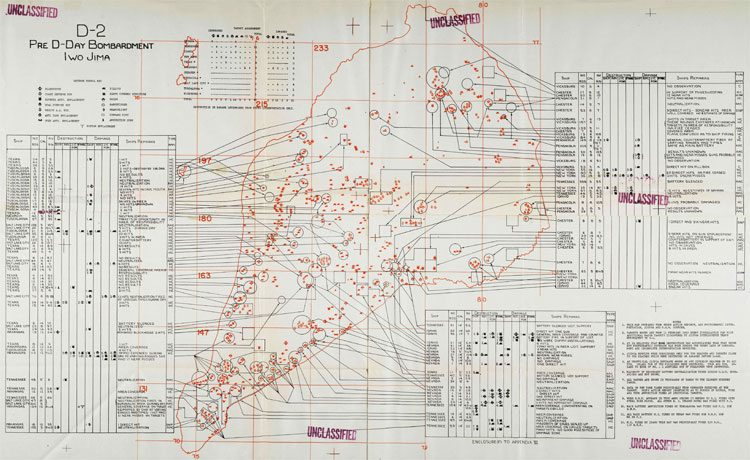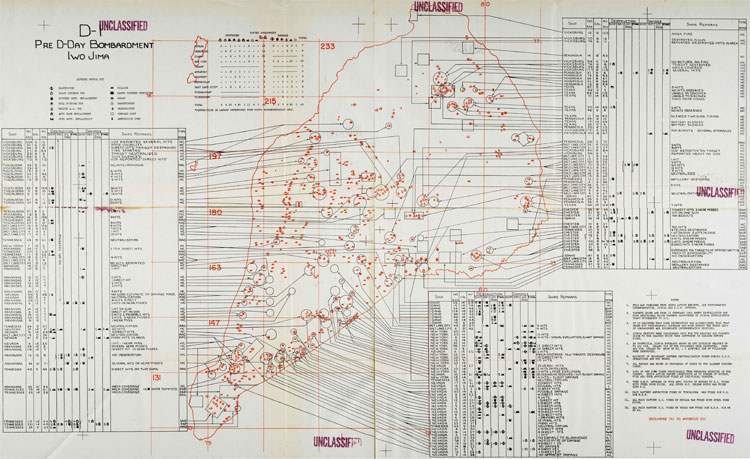Slave to the Game
Online Gaming Community
ALL WORLD WARS
IWO JIMA NAVAL GUNFIRE SUPPORT

I. PLANNING
A. GENERAL
1. In planing Naval Gunfire support for the attack on Ivo Jima, emphasis was laid on combining and applying the techniques developed in earlier bombardment of small atolls with those developed during the bombardment of the MARIANAS, where terrain features dictated many special measures in control of fire. Particular attentign was given to improving air spot facilities and to arranging that an experienced gunnery staff be present during preliminary bombardments that an experienced gunnery staff be present during preliminary bombardments aboard an AGC to interpret and apply current target intelligence to the targets upon which fire was to be delivered. Advantage was not taken, however, of one lessor learned in the MARIANAS, namely, that by allowing for a bombardment of considerable length prior to DOG Day, considerable reduction can be effected in casualties among landing troops.
2. The result of emphasis on air spot and target intelligence was a marked increase in the efficiency of the bombardment. Although the total length of the bombardment was not as great as requested by the landing Force, the greater efficiency of each day's firing was such as to minimize the loss entailed in the reduction of time.
B. SHORE FIRES CONTROL PARTIES
1. 1st and 3rd JASCOs remained attached to the 4th and 3rd Marine Divisions respectively; 5th JASC0 was attached to 5th Marine Division.
2. Shore Fire Control Sections of these three JASCOs were expanded before the operation to include Regimental Naval Gunfire Liaison Officers, Assistant Division Naval Gunfire Officers, and their respective teams, in accordance with recently authorized increases in the Table of Organization. Experienced officers were supplied from Headquarters, Fleet Marine Force, Pacific, to fill these requirements.
3. As a result of experiences in the MARIANAS, two Naval Gunfire Liaison Officers and two Naval Gunfire Spotters were attached to each of the 4th and 5th Marine Divisions to act as on-the-spot replacements. Ho replacements were supplied to the 3rd Marine Division, but one Liaison Officer reported to that organization immediately prior to the operation on orders of the Bureau of Personnel and participated as an available replacement.
C. AIR SPOTTERS
1. Four Air Observers from 3rd, 4th, and 5th Marine Divisions were assigned to fire support ships to spot Naval Gunfire. Final assignments attached one such observer to each of ARKANSAS, TEXAS, HEW YORK, NEVADA, IDAHO, TENNESSEE, SALT LAKE CITY, PENSACOLA, CHESTER, TUSCALOOSA, SANTA FE, and BILOXI.
2. VOC 1, a fighter-spotter squadron, was also made available aboard WAKE ISLAND to supply air spot for designated fire support ships.
D. PRELIMINARY BOMBARDMENT
.1, The initial plan for preliminary bombardment as set forth in the Concept provided for one Cruiser Division to bombard the objective beginning on DOG MINUS EIGHT Day, to be joined on DOG MINUS THREE Day by seven OBBs and six CAs or CLs. Based on a preliminary study of the number of targets at the objective, V Amphibious Corps recommended, on 24 October, that ten days of bombardment by a Cruiser Division, plus three OBBs be arranged. The Commander, Amphibious Forces, U. S. PACIFIC Fleet, stated, in reply to this recommendation, that "limitations on the availability of ships, difficulties of ammiinition replacement, and loss of surprise interpose, serious obstacles to meeting your recommendation." He further stated that the objective would be bombarded by one Cruiser Division on 15 December, and at irregular intervals thereafter, and that three days of bombardment by the designated ships would provide for delivery of more major calibre fire than had been requested by V Amphibious Corps.
2. On 8 November, after a more careful study of the target area had been made, V Amphibious Corps submitted a recommendation for a total of nine days of preliminary bombardment. On 26 November, the Commander, Amphibious Forces, U.S.Pacific Fleet, replied to this recommendation with a study indicating the necessity of slightly more than three days of bombardment, and a statement that the troops would be provided with the best possible preliminary bombardment consistent with limitations of ammunition supply for subsequent troop requirements.
3. On 24 November, V Amphibious Corps request ... day of preliminary bombardment be provided.... The Commander Amphibious Forces, U. S. PACIFIC fleet, forwarded this request, requesting approval provided that there was no objection on the part of the Commander, FIFTH Fleet, based on the general strategic situation; and further, provided that the fast carrier strike could be delivered on DOG MINUS THREE Day. This recommendation was disapproved by the Commander, FIFTH Fleet, for reasons indicated below. '
a. That initial surface bombardment must be simultaneous with the initial carrier attack on the TOKYO Area, and that, if continuation of the carrier strikes beyond two days were neither desirable nor necessary the enemy could then recover early enough to initiate threatening air attacks at the objectives by DOG Day.
b. That shore based air attack to be provided could be considered .at least as effective as the recommended additional day of surface ship bombardment.
c. That there would be no opportunity for replacement of naval
ammunition, and that there was therefore a limit to the amount, of ammunition
that could be made available for preliminary bombardment, allowing sufficient
ammunition for DOG Day.
4. On 2 January, after a careful study of the preliminary bombardment plan which had been prepared, V Amphibious Corps stated thai it believed the preliminary gunfire to be inadequate for destruction of targets immediately inland from, and flanking, the landing beaches; and recommended that either an increase in time be allotted for preliminary bombardment, or a greater concentration of effort be placed on, s&nd adjacent to, the main landing beaches, with a corresponding reduction in the amount of fire placed on the other areas of the island. This recommendation was approved by the Commanding General, Expeditionary Troops, FIFTH Fleet. It was in turn forwarded by the Commander, Amphibious Forces, U.S. PACIFIC Fleet, recommending disapproval for the reasons previously set forth by the Commander, FIFTH Fleet. Further comment indicated that the concentration of fire in tho vicinity of the main landing beach uras not considered sound, sinqe other areas would then receive too light a coverage of fire; and that, in any case, the Commander, Amphibious Group 0¥Et. would have the necessary authority to make changes in the plan as necessary.
5. Further changes made necessary the substitution of NEW YORK, TEXAS, ARKANSAS, TENNESSEE, IDAHO, and NEVADA, plus" WASHINGTON and NORTH CAROLINA on DOG MINUS ONE Day only, for ships originally allotted but later unavailable.
6. A special bombardment by INDIANA. plus Cruiser Division FIVE was
executed prior to DOG Day, with unknown results. The allotment of WASHINGTON
and NORTH CAROLINA for bombardment on DOG MINUS ONE Day was cancelled.
II. TRAINING
A. GENERAL
In training personnel, both ashore and afloat, for the assault on Iwo Jima, special emphasis was given to lessons learned during operations against the MARIANAS Group. Corrective communication training was given, based on detailed analysis of radio logs from those operations while improved control of star shell firing, closer command integration, between the various echelons and improved methods of distributing the locations of front line positions to all hands, were emphasized; as well as fnoro extensive use of air spot. Radar Beacon Operators wore added to Division and Regimental Haval Gunfire Teams ashore, and both ship and shore personnel were trained in their use. New changes in the firing mechanisms aboard rocket and mortar snips were described to all Shore Fire Control Personnel.
B. SHORE FIRE CONTROL PARTIES
1. Shore Fire Control Sections of the 1st and 3rd JASCOs both received intensive retraining at PEARL HARBOR in preparation for this operation. Exercises were conducted in new techniques, and classroom instruction was given to bring all hands up to date on the latest developments, including the results of reports and critiques on recent operations in this area, Naval Gunfire Liaison Officers were given additional gunnery training at the Pacific Fleet Gunnery School, as practicable. Shore Bombardment Exercises were conducted at 1 KAHOOLAWE Island with available ships of the PACIFIC Fleet. All training : activities were closely supervised by the Division Uaval Gunfire Officers concerned,
2. The Shore Firo Control Section of the 5th JASCO, all new oxcept for Assistant Division and Regimental Haval Gunfire Officers, received advanced. training similar to that described in Paragraph 1 above, rathar than retraining. Every effort was made to give this new organization as full advantage, as possible of recent operations and to emphasize group activities considered especially valuable to a new organisation.
3. The Shore Fire Control Section of each JASCO executed a final rehearsal at KAHOOLAWE Island for a twenty-four hour period in which a tactical situation ashore was assumed. This included overhead fire, starshell illumination, harassing fires, call fires. and the KING Hour preparations. The exercise proved an excellent finale to the training not only of the Shore Fire Control Parties but also of the firing ships participating, who gained a realistic picture of what twenty-four hours of continuous fire support duty involves,
C. AIR SPOTTERS
1, Air Observers from the 3rd, 4-th, and 5th Marine Division received intensive training at PEARL HARBOR, including bombardment exercises at KAHOOLAW Island, in preparation for their assortments to fire support ships. Training of V Amphibious Corps Observers was planned, but the schedule could not be completed in the time available so that they were not assigned for the operation.
2. The fighter-observer squadron to be employed, VOC 1, was given intensive training, including Bombardment Excercises at KAHOOLAWE Island. Lectures were also given aboard USS WAKE ISLAND), and all current information was supplied to the unit.
3. Replacement pilots for heavy ships of the fleet received training in communication procedure and share bombardment while attached to SoSu L Replacement Pool. Others, attached to ships engaged in Communication and Shore Bombardment Exercises, received training through their participating in these exercises.
4. Underwater Demolition Teams were included, on request, in Shore Bombardment Exercises at KAHQ&LAWS Island. Representatives of the Javal Gunfire Section, Headquarters, Fieet Marine Force, Pacific, participated in the exercises. After this initial indoctrination, the teams were able to conduct their own practices without further supervision.
D. FIRE SUPPORT SHIPS
1. The training program operated in the past by the Commander, Cruisers and Destroyers, PACIFlC Fleet, in conjunction with Fleet Marine Force, Pacific was continued and expanded in the period leading up to the attack on IW0 Jima. All but a very few of the ships employed at IWO Jima had qualified in the Shore Bombardment Course at KAHOOLAW3 Island.
2. Communication Drills of several types, including Radar Beacon Drills, were conducted with ships made available by the Commander, Cruisers and Destroyers, PACIFIC Fleet. All ships qualified in communication procedure before executing actual bombardment practices,
E. REHEARSALS
1. Final rehearsals for the Landing Force were held in the HAWAIIAN Area from 13 January, I9I+5, to IS January, 19^5, inciusive* . Simulated bombardments by all available fire support units were conducted during the first three days. Actual bombardments wore conducted on the following days; while Shore Fire Control Parties landed on KAHOOLAWE Island on the 17th to conduct call fires, reembarking on the 18th.
2. Since only a limited number of fire support ships had been present at the Landing Force rehearsal, the bulk of the group having been at ULITHI Atoll, further rehearsal exercises were held off the the West Coast of TINIAN on 12 and 13 February 1945, primarily for their beliefit. Simulated fires were executed by fire support ships and communication nets were operated. ,Actual transmissions, however, wore kept to a minimum in order to-maintain the greatest possible degree of security.
3. In order to give all fire support ships complete details of all Plans and proferred techniques, especially those ships recently added to the fire support group as replacements, tho Naval Gunfire Officer, Landing Force, gave ships' personnel special briefing at PEARL HABBOR, ULITHI, and SAIPAN.
III. CONDUCT OF OPERATIONS
A. PREPARATORY FIRES
1. Fires were delivered in accordance with Commander, Amphibious Forces, U. S. PACIFIC Fleet, Operation Plan A25-44, as modified by various corrections, additions, and deletions. For a study of the results of the preliminary bombardment, see Appendix III, ANALYSIS . OF PRELIMINARY BOMBARDMENT, and V Amphibious Corps Action Report, IWO Jima.
2. The Naval Gunfire Officer, Landing Force, was afloat off IWO Jima in ESTSS, AGC 12, flagship of the Commander, Amphibious Group ONE,
throughout the preliminary bombardment. He was consequently able to assist and
advise the Group Gunnery Officer in target evaluation and direction of the
bombardment until the morning of DOG Day, when the Commander, Amphibious
Forces, U. S. PACIFIC Fleet, took over direction of the bombardment. She
Naval Gunfire Officer, Expeditionary Troops, was in ELDORADO, AGC 11, flagship
of the Commander, Amphibious Forces, U. S. PACIFIC Fleet, where he assisted
and advised the Force Gunnery Officer in the direction of the DOG Day
bombardment.
3. Bombardment preliminary to, and in conjunction with, landings was begun on DOG MINUS. THREE Day, and continued until sunset of DOG Day. Prior to DOG Day, careful painstaking destruction of existent installations was emphasized, with heaviest priority given to CD and AA installations, as well as to other types of emplacements which might present serious threat to friendly units closing the target area with the approach of DOG Day. On DOG Day itself, emphasis was shifted to area neutralization and beach preparation, including a rolling barrage in coordination with the arrival of troops on the beach and continued neutralization of critical areas farther inland throughout the day.
4, On DOG Dsy the outstanding feature of the prearranged firing,
from the standpoint of the landing schedule, was the rolling barrage in advance
of, and on the flanks of, the landing, the advisability of which had become
apparent during operations against the M4RIANAS. Five inch batteries were
employed to deliver the barrage at a minumum distance of 400 yards from the
landing troops. This fire was to lift inland and on the flanks in accordance
with the best available estimate of troop advance. Provision for adjusting
to any possible variation in the actual rate of advance was made in the
directive that blocks of fire would be refired if the advance were.slower than
anticipated, or omitted if it were faster, on the basis of requests for such
adjustment from the Division JIaval Guiafir© Officer, acting on reports from
the Division Air Observers. Actually, the advance in most areas was slower
than anticipated, and a number of blocks were consequently refired. (See
Appendix I, CHRONOLOGIC SBCOBD OF EVERTS, DOG Day.) From HOW MIHUS 140 to
HOW MINUS 55, high priority continued to be given to remaining CD and AA
positions to cover the close approach of surface and aircraft. An air strike
was then executed between HOW MINUS 55 and HOW MINUS 35, while ships maneuvered
into their final positions. Firing from HOW MINUS 35 to the passage of LVTs
through the line of fire support ships centered on the beach, including air
bursts, to inflict maximum casualties among enemy troops in the open. After
LVTs passed through the fire support ships, about HOW MINUS 25, shift was
made to impact burst in assigned areas. At HOW MINUS 15 all fire was again
directed to the beach area for a distance of 200 yards inland, using 1200
foot second powder to assure boat and troop clearance. Then, beginning at
HOW MINUS 3, fire was lifted inland as scheduled and as modified by later
troop requests. ,
5. Planes of VOC 1 and heavy ships spotted fire throughout the
preparation phase. Special support craft delivered a portion of the
preparation fires. These activities aro discussed in other sections of this
report.
B. CALL FIRES AND NIGHT ILLUMINATION
1. DOG Day
a. On past operations the maintenance of continuous and
accurate fire support during the shift from prearranged to shore controlled
fires had presented a difficult problem, An effort was made on this oporation, with reasonably successful results, to overcome this difficulty by
boating Haval Gunfire Liaison Officers in free LVTs with TCS radios, which were
to be set up on the appropriate Spotting Frequencies. Both Spotter and Liaison
Officer were equipped with SCR 300s so that the Spotter, after landing, could
communicate with the Liaison Officer boated in the LVT by SCR 300 until such
time as he could set up his TBX to communicate directly with the firing ship.
When he-had so set up, the Liaison Officer proceeded to the beach to join
the battalion. In this way communication with the ship was feasible a§ the troops proceeded toward the beach, and an emergency spotting station wag available should the Spotter be unable to operate immediately upon hitting the beach. She greater flexibility provided by this plan enabled Shore Sire Control Parties to operate more nearly continuously, adjusting as necessary to the various problems associated with the landing of each assault battalion.
b. As the Shore Fire Control Parties landed, enemy fire did not seriously hinder their operations. They found themselves on a steep beach of volcanic cinder, however, which soon began to receive heavy mortar and artillery fire from enemy positions on the surrounding high ground. Under these conditions the movement of cumbersome radio equipment became difficult, casualties to both materiel and personnel handicapped operation, and it became difficult to maintain communication once the radios were sot up, so that sorae confusion developed batweon Shore Fire Control Parties and support ships.
c. Meanwhile, afloat, the Commander, Amphibious Forces,
U, S, PACIFIC fleet, in ELDORADO, AGC 11, had taken over control of shore
bombardment from the Commander, Amphibious Group ONE, in ESTSS, AGC 12,
on the morning of DOG Day. Assisted by the Faval Gunfire Officer,
Expeditionary Troops, the Force Gunnery Officer assigned ships as necessary both to relieve and to augment those originally assigned to support
of assault battalions, Ee also directed ships to take uader. Fire deep
and general support targets as, reported by troop units, air observers,
and surface ships. Jhese activities proceeded without any more confusion
than is unavoidable at the scene of a large scale landing operation. One
officer was assigned to take station with CASCU in order to coordinate
gunfire with air support.
d. Firing was extremely rapid during DOG Day with the result that it was necessary to relieve ships frequently, often on short notice. By nightfall, however, communication conditions improved, traffic was much reduced, and assignments of support ships stabilized.
e. No limit was placed on starshell expenditures during
the night of DOG Day, so that troop units could take full advantage of
available illumination, Unquestionably some starshells wpre spent non-essentially during the night; but again, the urgency of the general
situation completely justified such expenditures.
f. For a detailed record of the events of DOG Day see Appendix I, CHRONOLOGIC RECORD OF EVENTS, DOG DAY.
2. SUBSEQUENT TO DOG DAY
a. Troop requirements in terms of ship aasignments underwent considerable simplification after the heavy demands, of DOG Day. The screen Commander and the Force Gunnery Officer effectod relief of ships as necessary with very little confusion. Ships did not always relieve one another properly, frequently neglecting to pass along vital information to the relieving ship before departure from the area, but ready, intelligent, and cooperative fire support was the very nearly universal rule.
b. Limitations on expenditures of ammunition quickly became neoessary when the heavy expenditures of DOG Day were followed by weather so adverse as seriously to hamper the loading of ammunition aboard fire support ships. Maximum expenditure figures for a twenty-four hour period were set, including both HE and starshell ammunition. These figures were altered as. practicable in view of changing conditions of supply and demand, always with the proviso that increases would be made in case of emergencies, such as enemy counterattacks. By this moans excessive expenditures were minimized while units of the Landing Force.wero not put in the position of being without vitally needed support at a time of urgent need.
c. Targets fired upon at the direction of Shore Tiro Control
Parties consisted of the various installations and positions which immediately
impeded the advance of friendly troops. Neutralization, destruction, and
harassing missions wore fired on targets varying from areas such as vehicle
parks and bivouac areas to pinpoint adjustment on pillboxes and small cnemy
gun positions. Both direct and indirect fire were employed. In some instances
direct fire was preceded by adjustment of searching salvos by the Shore Fire
Control Party to assist the ship in identifying the target. In other cases
officers from the beach went aboard the ship to identify enemy installations
from seaward. Both methods proved effective, and, because of the exposed nature
of the island and excellent hydrographic conditions surrounding it, direct fire
was used more extensively and with greater success than on previous operations.
C. DEEP SUPPORT MISSIONS
1. Preparation for KING Hour Attacks
Each night landing Force passed to the Attack Force Commander the
consolidated requirements for preparation fires, together with such other in
formation as the time of KING Hour, any Shore Fire Control Parties with which
communication needed to be maintained for safety of friendly troops, and the
amount, kind, and caliber ammunition desired on each target. Ships were then
assigned targets in'zones for which they were to be responsible later in the
day, and given all pertinent information. In this way preparations were made
for the jump-offs each day on the basis of troop requests until the heavy ships
departed from the area.
2. Night Harassing Fires
Requirements for these fires were also passed to the Attack Force Commander by landing Force, and ships, including LCI(M)s, assigned accordingly. After Mount SURIBACHI was secured, two heavy ships were normally retained, one to cover the EAST and one the WEST side of the island, LCI(M) then covered the NORTHERN portion, with counter battery cover from one of the heavy ships also, supplying harassing fires. Times of fire and locations of target aroas were carefully planned tojlvoxd danger to friendly troops, and no such casualties were reported from nigght missions.
3. Deep and General Support
a. During the day a number of cruisers and battleships were
normally available to supply deep and general support with air spot. Past experience had indicated that safety sonos of 1000 to 1500 yards from friendly
troops, were necessary in delivery of these fires and such limits were observed
except when specific directions to the contrary were recteived from Landing Force.
On one occasion Landing Force urgently requested the main battery of a battle
ship to fire within 400 yards of friendly troops. The request was not without
mischance but missions of this sort were exceptional and never fired except on
troop request. Targets on which deep and general support fires were delivered
were supplied by Landing Fbrce; target lists of the G—2 Section, Expeditionary
Troops; information received from Division Air Observers through CASCU; and
information received from the various ships. Areas responsibility, were
assigned to the ships along with the location of all known targets in the
respective areas. Where special fires were desired by one division or regiment,
direct communication was established between the ship and tne controling unit
ashore, and fires exscuted as desired.
b. Count e;rbattery fire became increasingly necessary toward the end of the operation with the result that all ships in the area, resumed special attention to these missions. Direction of counterbattery activities was placed in the hands off Fire Support Area Commanders who directed all available and assigned fire support ships. An enemy CD gun installation in area 219 A proved particularly stubborn and is believed to have been the one which obtained hits on TERRY, DD 513, and possibly on COLHOUN, DD 801, as well as the one which had hit PENSACOLA, CA 24, before the landing. This installation was finally put out of operation by NEVADA, BB 36.
D. ORGANIZATIOH OF CONTROLLING AGENCIES
1. Control of the preparation fires prior to DOG Day was exercised by CTF 52 (Commander, Amphibious Group ONE) in ESTES, AGC 12. Also in ESTES was the Naval Gunfire Officer, Landing Force (V Amphibious Corps). Ships took station and executodj fires as planned except when otherwise directed. (See Section III A of this report, PHEPARATION FIRES).
2. DOG DAY to JDOG PLUS EIGHTEEH
a. On D0;G Day, Commander, Amphibious Forces, U. S.. PACIFIC Fleet, took over control in ELDORADO, AGC 11, becoming. CTF 52 as well as CTF 51. Also in ELDORADO wad the Naval Gunfire Officer, Expeditionary Troops (Fleet Marine Force, Pacific), who assisted in the task of directing fire support activities. Naval Gunfire Control Net, Overflow Net, Gunboat Control Net, and VHF Airspot Assignment Wet were manned continuously while intermittent monitoring of Spotting Nets was carried on to assist as necessary in - establishing communication between Shore Fire Control Parties and support ships and to obtain necessary additional information. Ships completed the preparation fires and went on to working with Shore Fire Control Parties as assigned in the Attack Order and as additionally directed by CTF 52. Deep and general support fires continued throughout the day as targets wore reported by surface, air, and troop units.
b. Confusion was experienced on DOG Day and the days immediately following because of contradictory and extravagant requests from various troop units. Representatives of CTF 52 and AGC, Expeditionary Troops, were in no position to evaluate requests, or to resolve contradictions. Excessive requests in several cases had to be granted since the only assumption possible was that they were matters of urgency. Contradictory transmissions had to be checked with the originators, with consequent loss of time and additional traffic on .crowded radio nets. These difficulties continued until Landing Force Headquarters landed and took over control on the beach, consolidating all troop requests before passing them to OTF 52. Once again, as in the MARIANAS, the importances of such consolidated control ashore at the earliest possible time was entirely apparent.
c. In brder to maintain close coordination with Artillery and
Air Support activities, the Gunnery Officer, OTF 52, detailed an experienced officer to take station on DOG Day in CASCU, which eas immediately adjacent to Expeditionary Troops staff section, including the Artillery Officer, to prevent duplication of effort, obtain information coming in from the Division Air Observers and expedite requests for Plan VICTOR and Plan Negat or other
plans necessary to avoid hitting friendly planes with Naval Gunfire. After DOG Day, such liaison was effected by phone or squawkbox, relieving this officer
for duty in the gunnery office. Actually very few adjustments were necessary
to prevent hitting friendly aircraft because ships, were firing at ranges short
enough that maximum ordinates of their trajectories did not interfere with the
operation of aircraft.
d. Direction of special support craft was, on DOG PLUS ONE Day, turned over to CTG 51.21 (Commander, Amphibious, Group TWO). Requests for the assignment of such craft to missions in deep support and to work with Shore Fire Control Parties, were passed directly .to CTG 51.21 from the Landing Force, so that assignments could be made independently of those of heavier support ships.
e. Requests for fire from DDs, CEs, CAs, and BBs were processed as in the MARIANAS, by the echelons ashore to Division and, later, Corps, where they were consolidated as necessary to meet the available supply of ships and ammunition. The complete consolidated requests, including Shore Fire Control Parties, frequencies, and necessity for air spot, was passed to CTF 5? during the night for operations the next day. Normally ships wore on shore bombardment duty for about twenty-four (24) hours, with reliefs effected during daylight hours as ships could be relieved from other duties.
f. The necessity for violating the original division of responsibility among the Fire Support Area Commanders in order to increase the
elasticity of ship assignment on deep support missions was soon apparent. In
order that each day's assignment could be set up on the basis of available ships
and troop requirements for various types of fire in various parts of the island,
CTF 52 assigned ships directly rather than through the fire Support Area Commanders. This arrangement functioned smoothly, however, with no loss of available fire support.
g. For organization of controlling troop agencies ashore, see V Amphibious Corps, Action Report, IWO Jima.
3. After DOG PLUS EIGHTEEN
On DOG PLUS NINETEEN, CTG 51.21 (Commander, Amphibious Group TWO) took over control of shore bombardment from CTF 52, who departed from the target area. The same general plans of ship assignment were employed except that as requirements diminished, ships wore assigned to regiments and divisions rather than to battalions,
E. AIR SPOT
1. Two sources of air spot were available and both were fully employed: the pilots and observation aircraft attached to heavy fire support ships, and the pilots and fighter observation planes of VOC 1 aboard WAKE ISLAND, CVE 65.
2. Planes from Heavy Ships
a. The planes of cruisers and battleships spotted both for
the ships to which they were attached and for other fire support ships in the
area. Pilots were cooperative and resourceful in meeting communication problems
and other difficulties encountered in such work. Their knowledge of Shore Fire
Control procedures in contradiction to procedures employed in sea engagements, and their ability to identify shore installations and troop movements,
showed distinct improvement since the MARIANAS Operation. This is believed to
be the direct result of the training'radministered to replacement pilots by
Scout Observation Service Unit (SoSu 1) in cooperation with the Commander,
Cruisers-Destroyers, U. S. PACIFIC Fleet, and Fleet Marine Force. All pilots
had not had an opportunity to participate in this program, however, so that the benefit of this excellent and specific training was not always available.
b. Division artillery air observers from each of the 3rd, 4th, and 5th Marine Divisions were also aboard the heavy ships to go aloft with the pilot-observers to direct fire. These observers were initially aboard ARKANSAS, TEXAS, NEW YORK, NEVADA, IDAHO, TENNESSEE, SALT LAKE CITY, PENSACOLA, CHESTER, TUSCALOOSA, SANTA FE and BILOXI. Although later casualties and reassignments altered this distribution. Theses officers were of tremendous assistance in identifying targets and coordinating fire, with troop activities on the ground. Their training at PEARL HARBOR in the direction and employment of Naval Gunfire in shore bombardment is considered to have increased their value to the Landing Force immeasurably.
c. A further limitation was placed on the operation of those planes by heavily adverse weather conditions which affected operations on DOG-PLUS ONE Bay and the days, following. Heavy seas and high winds rendered recovery of planes highly uncertain and, at times, impossible. Under these conditions the planes of VOC 1 were indispensable. When, the weather moderated, however, both plane types again operated each day until their departure from the area.
3. VOC 1
a. The pilots and planes of Composite Spotting Squadron ONE (VOC 1) spotted fire continuously during daylight throughout the operation except for one day during which WAKE ISLAND retired to refuel. VOC 1 flew 892 spotting sorties, flying 2,375.5 hours from DOG MINUS THREE Day to DOG PLUS TWENTY Day, inclusive. Its contribution to the success of Naval Gunfire support, while not subject to statistic summary, is clearly demonstrated by the universal praise of its work by representatives of the supported troops.
b. Assignments of spotting planes were made by CTF 52 as the flights reported into the VHF Net, on the basis of requests received earlier by Landing Force, plus the requirements of ships engaged in deep and general support which did not have at their disposal operative observation planes. Assignments functioned reasonably smoothly at all times.
c. When relieved from their spotting duties these planes were directed on strafing and rocket missions by CASCU, usually over the Support Air Direction Net or as otherwise desired by CASCU.
d. On the day that WAKE ISLAND retired for refueling, CASCU made available to the Gunnery Officer, CTF-52, VT planes in flights of four. The pilots of these planes were outstandingly willing and cooperative and, in spite of inexperience in procedures and some confusion in the presetting of frequencies, persevered throughout the day in supplying urgently needed fire direction and information.
F. SPECIAL SUPPORT CRAFT
1. Operations against IWO Jima are believed to have involved, the most extensive employment of LCI and LCS- suoport craft heretofore made in the PACIFIC.
2, The Gunboat Support Group, composed of two 6-ship LCl(G) units
and two 6-ship LCS(L) units were to,deliver preparation fires on the beach and
adjacent flanks, including the approaches to Mount SURIBACHI, in connection with
the landing. Unfortunately, only three of the twelve original LCI(G)s composing
Gunboat; Support Units OEE and TWO were operational on DOG Day, as a result of
heavy counterbattery fire received on DOG Day MINUS TWO Day while covering UDT operations. Accordingly, the twelve LCS(l)s in Gunboat. Support Units THREE
and FOUR were directed to increase their spacing when deployed for delivery of
preparation fires in order to compensate for the missing ships. After the
delivery of 40 mm and rocket fire in beachg preparation, four of these ships
took station and set up communication with Shore Fire Control Parties as
initially assigned in the Attack Order. Other ship's wore available for further
assignments. Until their departure from the area, these units delivered fire
on all types of targets, both in deep support and vrith Shore Fire Control
Parties attached to units moving through coastal areas. They were resourceful
and unstinting in meeting all the harassing problems connected with Lhe support
of amphibious attack. Their work created both confidence and respect among the
troop units.
3. The Mortar Support Group consisted of ICI(M)s. During preparation for the landings on DOG Day, Units TW0 and FIVE fired by Plan ABLE on the EASTERN slopes of Mount SURIBACHI, while Unit ONE fired by Plan ABLE on the high ground along the EASTERN flank. At HOW Hour, Units TWO and FIVE crossed the boat lanes to deliver fire in beach preparation and further inland until HOW PLUS SIXTY, using Plan BAKER. Unit ONE meantime shifted fire to the east to insure safety of friendly troops and fired until early afternoon of DOG Day, by which time 17,400 rounds of 4.2 inch mortar ammunition had been fired in direct support of the landing by Units ONE, TWO, and FIVE. These ships then resupplied their ammunition and stood by for further assignment with Units THREE and FORE. Further assignments continued for these craft until DOG PLUS TWELVE Day, when the last LCl(M)s departed from the area, including all types of missions in general support, work with Shore Fire Control Parties, and night harassing missions. On the night harassing missions, LOl(M) units were particularly effective. They employed Plan ABLE during those fires, shifting the bearing of the firing run at stated intervals in order to cover a wide swath at irregular intervals. Daring the first few nights, these ships attracted heavy caliber fire'from enemy units ashore, and although the fire was neither accurate nor intense enough to require the withdrawal of the ships, it was decided on later nights to assign one DD, CL, CA, or BB to supply covering fire in addition to their other duties during the night. This plan proved successful and the work of the LCl(M)s on all firing proved excellent.
4. One RCM and Rocket Support Unit, consisting of nine LCl(R)s, also participated in the operation. Oh DOG Day these ships fired their total load of 5 inch SSRs, 9500 rounds, on the MOTOYAMA Area. They employed Plan ROGER ABLE during these firings, with a reference point NORTEAST of the island. Firing was completed during the early afternoon of DOG Day, after which, time the ships were withdrawn from fire support duty and were employed on other duties during the remainder of the operation.
5. An analysis of the logs of the Gunboat Control Net reveals a
certain confusion surrounding the assignments and operations of these vessels.
The problem arose primarily from the fact that employment of such craft was
still relatively experimental so that their procedures had not yet crystallized
to the extent that they had for other types of vessels and secondarily from
the multifarious nature of the duties these vessels are called upon to execute.
At no time, however, did these difficulties prevent delivery of fire requested
by troop units.
IV. COMMUNICATIONS
A. GENERAL
Partly because of the small size of the target area and partly because
of the increasing familiarity of all hands with proper procedure and discipline,
Naval Gunfire communications were unusually smooth during operations against
IWO Jima, In spite of many casualties to personnel and materiel on tho beach,
communications were rapidly established and adequately maintained. For a
discussion of communications of Shore Fire Control' Parties ashore see V Amphibious Corps Action Report, IWO Jima.
B. PERSONNEL AND PROCEDURSE
1. The great bulk of messagas was handled skillfully by parsonnel operating the various stations. Fewer relays were necessary than during operations against the MARIANAS, and discipline was, in general, considerably improved.
2. Certain errors wore, however, general enough to be noted, Most significant of these was the failure of operators manning the various stations to listen briefly before transmitting in order not to break in on operational priority transmissions already in progress. This error, especially serious on the Naval Gunfire Control Net, frequently created communication interference before net control could be reestablished by the Attack Force Gunnery Officer.
3. Shore stations functioned particularly well. Naval Gunfire teams of all echelons transmitted most of their traffic by phone, relieving the congestion on the Control Net. While there were occasional inevitable delays in establishing communications with newly assigned support ships, it is felt that such difficulties were kept at a minimum. Both ships and Shore Fire Control Parties worked resourcefully and cooperatively in correcting for such maladjustments as they arose.
C. EQUIPMENT
1. Equipment both ashore and afloat was adequate to facilitate all required support of troop units.
2. Equipment aboard AGCs was adequate to cover the Control Net, the Overflow Net, the Gunboat Control Net, the YHF Airspot Assignment Net, and a number of the Spotting Nets. All Spotting Nets could not be covered continuously or all at once, however; such an increased facility is believed to represent the only remaining requirement in control equipment afloat.
3. The high desirability of operating two MHF receivers and transmitters on each DD was again apparent, as in the operations against the MARIANAS. DDs having two such sets operative maintained watch simultaneously on the Spotting Net on which they were working with the Shore Fire Control Party, and on the Naval Gunfire Control Net, with great advantage over ships with only one such radio installed or operational. The fact that many DDs were so equipped materially reduced the traffic over TBS and facilitated tho execution of assignments. Similar installations on those DDs on which they have not yet been made will further improve close fire support in future operations.
4. Equipment of battleships, cruisers, and special support craft was entirely adequate for the various responsibilities of thosa types of ships.
D. FREQUENCIES
1. The frequencies assigited for Naval Gunfire activities on this operation are believed to have been entirely adequate. Naval Gunfire Spotting Nets and Naval Gunfire Control Net functioned as before, with increased efficiency as a result of the assignment of additional frequencies as discussed below. Considerable enemy interference was encountered on all nets except the VHF Airspot Assignment Set. This interforence, most pronounced during the nights, consisted, for the most part, of CW transmissions, although enemy voice transmissions were heard repeatedly over the Control Net, including imitations of orders to "CEASE FIRE". This enemy activity did not interfere seriously on the Control Net, although heavy CW interference, did handicap operations on some of the Spotting Nets.
2. First of the additional frequencies made available on this operation was the Overflow Net for long transmissions previously transmitted over the Control Net. Partly through error on the part of various ships and partly through necessity, long transmissions were occasionally sent over the Control Net; but the great bulk of all ammunition reports, reports of firing and other long and involved transmissions were made over the Overflow Net, thereby enormously relieving the congestion heretofore encountered on the Control Net.
3. Gunboat Control Net, also are innovation on this operation, functioned very adequately from a communication standpoint. Although certain confusion still persists in the employment of these craft, it is considered that such confusion is no longer a matter of inadequate communication facilities. When traffic pertaining to the operation of support craft was light, the Gunboat Control Fot was occasionally employed as a second Overflow Net. It was also found to be very useful in the direction and operation of heavy support ships delivering counterbattery fire in cover of support craft engaged on night harassing missions.
4. The VHF Airspot Assignment Net was a new channel on this operation in connection with the initial employment of VOC 1 in the PACIPIC area. Employment of the net was unusually smooth. The planes in flights of eight with their MHF radios preset,on designated Spotting Frequencies, reported to the-Attack Force Gunnery Officor on the VHP Assignment Net. Each plane was then assigned to work with the Shore Fire Control Party and ship on the preset frequency. Planes then checked out of the WHF Assignment Net and came up on the MHF Spotting Net as assigned. When the relieving flight reported in, its planes received their assignments and relieved planes of the earlier flight, which then checked into the Assignment Net to receive further instructions, as originated by CASCU, for rocket and strafing missions to be executed before return of the flight to WAKE ISLAND, CCE 65. Prior arrangements were necessary, of course, between Attack and Landing Forces, to the end that Shore Fire Control Parties requiring VOC air spot were assigned the proper frequencies, designated for presetting on the planes' radios. These,arrangements, while somewhat elaborate, wore smoothly executed and entailed very little confusion throughout the operation.
V. EXTRACTS FROM SHIPS' ACTION REPORTS
A. TRAINING
1. EXTRACT
"This ship fired the shore bombardment course &£ KAHOOLAWS and qualified as SUPERIOR, Aft or this training the real thing was easy and very much anticipated. All hands felt that the time spent in the shore bombardment training was very beneficial and played a very large part in our contribution to the occupation of IWO Jima."
COMMENT:
Good news. Training program:is considered sound when it is difficult in such a way that the actual operation is relatively easy.
2. EXTRACT:
"Some of the older experienced gunnery officers are returning to the Fleet and they should be given assignments wherein they can analyze our gunnery problems and assist in their solutions. The training course at PEARL, as good as it is, should raise its standards, and if a ship is unable to pass the tests, some action should be taken to improve it."
COMMENT:
The standards of the Qualification Course at KAH00LAWE Island, T.H., have recently been raised considerably. Concur that wherever possible ships which fail to qualify should fire the course again until they do so.
B. GENERAL PROCEDURE
1. EXTRACT:
"It is essential that the ship know what method is being used by the Spotter to allow for the range and elevation factors brought on by the slope of the terrain. In future operations it is thought that a few preliminary - questions by the ship of each Spotter before' beginning fire as to how ho proposes to tsake care of the problem will give quicker adjustments."
COMMENT:
Do not concur. This is not a matter to be decided freshly on each problem, since standard doctrine is that the Spotter will include in his
spots all corrections for terrain differences (See Fleet Marine Force SOP NGF-1). The only information required by the ship is the initial
elevation of the target, which can either be taken from the chart or estimated by the Spotter and passed to the ship, whichever may be considered more accurate in a given situation.
2. EXTRACT:
"Two apparent misunderstandings were also involved. The designation of a blockhouse led to the assumption that destructive fire was desired, and resulted in the attempt to obtain as accurate a set-up as possible, and the abortive effort to gain communications with a spotting plane, ever at the expense of a certain amount of time. The second and more serious misunderstanding was as to the now apparent desire of the Shore Fire Control Party to have the ship commence firing when ready. As a result of this misunderstanding, and some communications difficulties, six-minute slap sod between the ship's initial report of 'ready' and the order to 'commence firing'."
COMMENT:
It is the responsibility of the Shore Fire Control Party to inform the ship as to the type of fire desired and when to commence firing. In
this case the officer directing fire apparently failed to do so,
3. EXTRACT:
"The Shore Fire Control Party kept the ship informed of the current situation on the beach and enabled the crew to secure jfrom general quarters on two occasions."
COMMENT:
It is highly desirable that the Shore Fire Control Party-Tcec-p the ship informed in order that the ship may "relax" as often as possible during fire support duties.
4. EXTRACT:
"Firing area assignments and restrictions should be more flexible. Several times aircraft spotters reported high priority targets just outside.of the limits of this ship's firing area absi^jimants. Over a period'of two hours no fire was directed by any ship against one such target. Concentration of fire against a single target by more than one ship is readily apparent to Spotters and can be quickly eliminated."
COMMENT:
Whenever targets appear outside of the area of responsibility of any slpp, they should be reported /to the Attack Force Coismander who will assign them to the ship which can handle them most expeditiously.
5. EXTRACT:
"Assignment of destroyers to uninterrupted fire support missions for twenty-four hours or longer, and the attendant necessity for remaining at General Quarters, is exhausting to personnel. This is particularly true of ships remaining at the objective for long periods. Release from fire support was usually followed by replenishment of ammunition,, with further loss of rest for any part of the crew."
COMMENT:
In assigning ships to fire support duties, every effort was made not to have any ship on longer than twenty-four hours. When ships became scarce, however, longer assignments were necessary. Many ships handled assignments with personnel on condition watches. This problem •should be met as considered most practicable by the ship concerned.
6. EXTRACT:
"It is suggested that the numbering of target squares on fire control charts be .extended to cover all areas of fire support sectors likely to be occupied by fire support ships. This is by far the easiest method of identifying the ship's position to the 'Oboes' and 'Charlies'. Moreover, the present system of numbering, squares consecutively from west to east through the target area and immediately surrounding water only, resulted in considerable confusion on one occasion. The ship reported its position to the 'Oboe' as Target Area 256. The 'Oboe' apparently looked at his chart, saw target area 255 on the oastern side of the island, and assumed theft the next square to the east, though unnumbered, was 256. Actually area 256 was on the western side of the island where the consecutive numbers were again picked up. Much valuable time was lost in clarifying the situation."
COMMENTS:
Concur. This reccommendation will be made to headquarters concerned. Failure correctly'to read the chart, however, regardless of the numbering system employed, is a serious error, in this case on the oart of the "Oboe".
7. EXTRACT:
"When SFC Parties had no targets, (this ship) sweep the enemy territory with the range finders looking for puffs of rocket or artillery fire. In this manner (this ship) located three gun positions, two large rocket emplacements (characterized by large brown puffs of smoke followed by balls of fire from rocket motors) and eight small mortars (characterized by small puffs of light blue smoke' in direction of path of mortar shell). These targets were taken under fire by five inch and 40 mm fire and neutralized or silenced. They were reported to the SFC Party and to CTF 52. The only casualty occurring during this search and fire method was the strain of the rangefinder operatorfs eyes and the loss of skin on the rangefinder operator's nose. "With level and crops level coming into the rangefinder the rubber eye guards soon , wore the skin off the noses of three rangefinder operators."
COMMENT:
Excellent, An alert ship can accomplish a great deal in locating enemy targets during periods of little activity. RHeports of findings to the Shore Fire Control Party and Attack Force Commander render such activities particularly valuable.
8. EXTRACT:
"From 1.628 KING to I706 KING on 22 February, this ship opened and maintained fire at Target Area 198 MFO in a heavy rain equall without benefit of fall of shot observation. This fire was urgently and repeatedly requested by the Shore Fire Control Spotter against an enemy counterattack. Target area was only 500 yards from front lines, but high priority of target plus good solution obtained by a Mk 8 radar fix, convinced Commanding Officer 'that risk was justified. A two hundred yard rocking ladder in range and a one hundred yard rocking ladder in deflection was applied and twenty six-gun salvos were fired. At 1706 while on the down leg of the rock ladder SFC was able to observe fall of shot which he spotted Up 200 Left 50. This protracted period of blind firing is believed to be an unusual case and, although not recommended except in urgent cases, is indicative of what our modern radar and fire control equipment is capable of doing."
C0MMENT:
The ship was fully justified in blind firing in these critical circumstances.
C. PRELIMINARY BOMBARDMENT
1. EXTRACT:
"The naval bombardment should begin a few days, before D Day, using slow fire, best ranges, and trained Air Spotters, The purpose here is to clear up as many weapons opposed to the landing as possible and draw fire from concealed batteries. This bombardment should go right through. From study of photographs, specific coastal guns and babteries should be carefully taken under fire by Battleship and Cruiser Units at medium ranges where the best fall of shot can be obtained, .accurate air spotting end fair visibility are essential. The problem could be sent to appropriate Cruiser or Battleship Commanders in advance with the necessary intelligence material to work-out the gunfire plan."
COMMENT:
Concur. This headquarters has always been of the opinion that
several days preliminary bombardment is required. Also that close,
deliberate short range direct fire is the only way to destroy fixed
enemy defenses.
2. EXTBACT:
"The UDT operation on D-2 Day disclosed'the location and strength
of the batteries covering the landinf beach. It is inferred that the JAPANESE
mistook the DDT operations for a landing and prematurely jexposed their own
strength and very advantageous positions. This disclosure was promptly taken
advantage of by the Amphibious Support Commanaer who demolished these batteries
and cleared the way for the D-Day landings. In a similar situation, it may be
practical to draw out such fire without exposing the small LCI supporting ships
as was necessary on this occasion."
COMMENT:
Concur. Although unfortunate for the UDTs and LCIs, it was lucky for the troops that the JAPS mistook the UDT operations for the landing and disclosed their positions. Most of the batteries were then destroyed.. Concur also that it may be practical to draw out the location of enemy batteries in future operations.
3. EXTRACT:
"After officers from this ship had the opportunity to observe some of the targets on I¥0 Jima which they had been bombarding, the following, general conclusions were drawn, by those officers:
(a) That on an island as well fortified as IWO, point detonating fuses on 8 " HC projectiles appear to be of little value, except against personnel more or less in the open.
(b) That batteries similar to that in area 199 0, which consisted of four Dual Purpose guns, could be better neutralized and even knocked out of commission by the use of low 5" air bursts. The JAPANESE type recoil cylinders which are located on top of the gun appear to be particularly vulnerable to air bursts."
COMMENT:
Strongly concur. Damage and destruction of weapons in open emplacements with the use of impact fuzes is particularly difficult to accomplish without excessive expenditures of ammunition. Since weapons of the automatic or semi-automatic type are particularly susceptible to mechanical damage, use of air burst directly over the emplacement should result in damage without excessive ammunition expenditure,
D. COMMUNICATION
1. EXTRACT:
"Because of the extended nature of the operation, need was felt for more talkers skilled in voice radio procedure and having knowledge of ships' gunnery as well as technical radio problems. This need was met by the use of aviators, aviation radiomen, and officers of the gunnery department."
COMMENT:
Concur fully, 1'te.ny times circuit discipline was violated and important transmissions interrupted by inexperienced talkers coming in the net without listening first. The necessity for talkers experienced in shore bombardment terminology, radio procedure, and ships' gunnery cannot be overemphasized.
2. EXTRACT:
"It is considered impractical for destroyers to guard more than two gunfire circuits; namely, the G-unfire Common and Shore Fire Control Circuit. The requirement that ammunition reports be submitted over the Naval Gunfire Common Secondary Circuit necessitates the securing of Naval Gunfire Common Primary Circuit by destroyers. ..."
COMMENT:
Do not concur. The Naval Gunfire Control Net is extremely overcrowded. The Overload Circuit was therefore set up for administrative
matters. It takes only a short time to shift, make a report, and return
to the Control Net.
3. EXTRACT:
"Circuit discipline on the Naval Gunfire Control Circuit coulr be considerably improved. Many vital transmissions intercepted by this ship were cut out by ships cutting in with some trivial transnission. Proper indoctrination of radio personnel to listen before transmitting and to use the standard voice procedure is necessary. Stations must listen before transmitting.
COMMENT:
Strongly concur. The value of Naval Gunfire support can be ' completely vitiated by improper communications. Transmitting before , : listening, especially, on the various Control lets, is obviously a serious error.
4, EXTRACTSTS:
"Forewarning was given that the transmitters in the planes were preset and could not be changed during flight. The cooperation of the ships was requested, in searching the band for planes a bit off frequency. The communications log records numerous instances of failure to establish contact between plane and firing ship. It is fully appreciated that the rugged treatment of aircraft necessitated in carrier operation affects sensitively ' tuned radio equipment. But the enumeration of this factor does not adequately dispose of the problem. A close monitoring of the spotting frequencies aboard the carrier base disclosed an inconsequential number of spotting planes which could not be received on or close.to the designated frequency, further check indicated that in several cases of communication failure between ship and. plane, the plane was received loud and clear by Naval Gunfire Support Control or by the Shore Fire Control Party or by both." ;
"C.I.C. communications both internal and external were excellent. The one trouble that caused the most headaches was the fact that the air spotter, the NGFLO, and the ship were frequently not transmitting on the same frequency requiring two receivers to be tuned in, one to plane and one to NGFLO. It is suggested that the observer and the ship line their sets to the frequency of the plane as it is believed that the plane set is sealed and not adjustable in flight."
"During the firing of fire support missions, fire discipline was excellent and communication with Shore Fire Control Parties and Air Spotters was satisfactory with but one exceptions On the night of 22-23 February, communications with the Shore Fire Control Party was lost for about eight (8) hours. (This ship) was firing, harassing fire at this time, but sufficient information was obtained from Headquarters, Fourth Marine Division, on the gunfire conmon circuit to permit continuing the fire without interruption. Communication was reestablished in time to permit call fire for the next morning. Communications with, the Air Spotters left little to be desired. Reliefs arrived promptly and were well briefed. There was very little delay in shifting from one spotter to the next."
COMMENT:
This problem of adjusting frequency setting when aircraft are included in the net has been met by recently promulgated standard [ procedures. Careful presetting of the plane's frequencies is, of course, essential. Then, as directed in the Attack Force Commander's Operation Order, ships arid Shore Fire ContrdJL Farties must adjust to the plane's frequency, For this reason, Net Control passes from the officer of the Shore Fire Control Party who is controlling fire to the Air Spotter ... after adjustment has been made, control reverts to the Shore Fire Control Party officer in control of fire. As indicated by the third extract included above, it can bo done.
5. EXTRACT:
"During the transmission of target assignments, the word 'to' swelled out as 'Tare Oboe' was twice confused with grid 'designation of target areas. The message as received is quoted as an example: 'Target for King Hour 193 Mike How Tare Oboe 198 Sugar love'. The use of a substitute word or phrase such as 'through' or 'up to area' is suggested."
COMMENT:
Concur fully. Steps will be taken to alter procedure to include use of the phrase "through".
6. EXTRACT:
"Enclosure (C) to this report, (radio log) has been made up to include only pertinent messages for the sake of clarity and in the interest of reducing paperwork."
COMMENT:
Do not concur in the desirability of submitting only selected portions of Shore Fire Control logs. Careful analysis of complete logs is essential to the maintenance of proper corrective training and judicious-adjustments of standard procedures.
E. NIGHT ILLUMINATION
1. EXTRACTS:
"The old problem of demand exceeding supply in star shells was again prevalent. This vessel provided illumination throughout three nights, and each time, received orders to fire 'so many s/tar shells per hour at-odd intervals. It is presumed other fire support ships received similar orders. As a result of this haphazard time, schedule there were periods whon there would be aa nany as eight or ten stars over the area, and periods when there would be none. The Commanding Officer is of the opinion that if general illumination is desired, several plans could bo drawn up taking into account, the number of fire support ships present and the amount of illumination desired. In this way a time schedule could be worked out for each ship."
"It was frequently noted that the lack of coordination between ships furnishing illumination at the objective at night would result in occasibnal oeriods of total darkness. It is recommended that a time sector plan be used, assigned each ship to a certain part of a 5 to 15 minute interval depending upon the amount of ammunition desired and the number of ships available. A tolerance of one minute should be allowed, to eliminate an absolute regularity which might be used to advantage by the enemy,"
COMMENT:
Concur in the need for doctrine for the coordination of illumination. Such a doctrine is now being prepared by this headquarters and the Shore Fire Control Parties of V Amphibious Corps.
2. EXTRACT:
"In order ;to illuminate with starshells at a range lower than 5000 yards, an exceriment was made using low velocity (1200 fvs.) powder. In four salvos at 2,500 yards starshell range, ohe star was successful. The other three projectiles failed to operate. This boars out the fact that the ME 18 time fuse will not function a majority of the time when used with velocity powder... With a special time fuse designed to operate with low velocity powder, it is believed that the minimum range for starshell illumination might be considerably reduced."
COMMENT:
Concur. Such a special fuse, if successfully designed and produced, would be most useful. In the meantime low velocity fuse will not function successfully in starshell firing.
F. AIRSPOT
1. EXTRACT:
"Effectiveness of the gunfire was aided materially by the excellent
air spotting facilities available. Own ship's planes were used to good
advantage, particularly during the first days of the operation, and at other
times VOF (VOC) Spotters provided service that was notable for its uniform
excellence. Not only were these Spotters thoroughly familiar with the terrain
and with targets to be taken under fire, but they showed keen insight into the
problems of ships' gunfire and fire control. The assistance which they provided cannot be overrated."
COMMENT: Concur fully.
2. EXTRACT:
"The performance of the fighter plane spotters was excellent. Their high speed and maneuverability permits, them to make low sweeps over the target areas to locate installations, but this ship prefers to use her own air ^spotters for the following reasons:
1. Communications were found better with own planes.
2. Delays in firing caused by shift in VOF (VOC) planes are avoided.
3. Cruiser aviators can be very carefully briefed on the installations in our own target area.
4. Long messages instructing VOF (VOC) Spotters in our target assignments are unnecessary.
5. More accurate reports on effect of fire could be obtained from cruiser aviators after their return on board."
COMMENT:
There are both advantages and disadvantages to both fast and slow type of planes. Formally VOC planes are assigned to Shore Fire Control Parties and ships engaged in deep and general support which have no airspot available. Heavy ships engaged in general support may of course employ their planes at their discretion,
3. EXTRACT:
"Inescapably situations arise. when both (air and ground) spotting agencies are not available. Iii such instances ships must learn to use the Spotter available. Many hours were lost during the subject operation due to reluctance of destroyers to fire without spot of the Shore Fire Control Party. Planes stood by on station, waiting for ships to establish communications with a Shore Fire Control Party or for the party to position itself. Obviously, when close support fire is to be delivered over fluid front lines, ground advice is essential but ships should not waste valuable time standing by when innumerable deep support targets beg for attention. It is believed that this situation is attributable to the infamiliarity of some of the destroyers with all spots."
Concur that any available agency to aslst in intelligent troop support should be exploited. The limitation on the principle is, of course, the danger of hitting friendly troops through error or lack of information. Best solution is believed to be that the pilot in question inform the Attack Force Gunnery Officer df his problem so that the Airspot can be reassigned if desirable. Then, if no such reassignment is at hand, the Attack Force Gunnery Officer can direct both ship and plane in deep support activities pending r-sumption of communications vrith the Shore Fire Control Party as originally assigned.
4. EXTRACT:
"(An artillery Second Lieutenant) from the 14th Marines was attached to the ship on temporary duty during preliminary and D-Day bombardments. He was of great assistance to the Gunnery Officer and to the Air Spotters. Ho was a credit to his Corps in the performance of his duties, as liaison officer and Air Spotter. It is recommended that the practice of assigning Artillery Officers to bombarding ships be continued."
COMMENT:
As long as two-seat planes are attached to battleships and cruisers, it is anticipated that Artillery Air Observers will continue to be assigned to heavy ships.
5. EXTRACT:
"To require that spotting planes keep clear of the objective at all times is to render them impotent. The efficacy of fast spotting aircraft is found in ability to get over target areas denied to the slower VO type planes. Admonitions against lingering needlessly are certainly in order and have been repeatedly given to the pilots. But a certain measure of discretion - must be permitted. The amount of blueprinting can cover every situation. Warnings of impending air strikes and of the invocation of planes VICTOR and NEGAT will clear the area when necessary. Such advice was given for the first few days of the operation but laxity developed during the later stages and with it the complaint, of interference with air strikes. Command Air Support Control and Commander Haval, Gunfire Support must be in communication so that warnings of air strikes can be passed on to the spotting planes and the time of the strike determined in accordance with the exigency of the moment, gunfire support or air support."
C0MMENT:
Concur. Close coordination between the Attack Force Gunnery Officer and CASCU is entirely necessary,
6. EXTRACT:
"Special consideration should be given to the D-Day flight schedule so as to coincide with the gunfire schedule. In a well planned i bombardment such as that of the subject operation, the periods of fire are known sufficiently in advance to permit a synchronized scheduling of flights. Particular recommendation is made that spotting planes be not relieved on or near H Hour during the most important preparation bombardment. Care should also be exercized that no gap be permitted in tho relief of spotting planes."
COMMENT:
Concur. This must be taken into consideration in planning for future operations.
7. EXTRACT:
It should be standard procedure for ships and aircraft spotters to identify themselves visually [XXX]
COMMENT:
Concur, Making a puff of smoke when shifting spotting planes is an excellent method of idenfification.
8. EXTRACT:
"One of the difficulties experienced by VOF (VOC) and own plane Spotters was that of distinguishing between own ship's bursts and those of other ships. In some instances there was considerable delay in getting on target due to the wrong burst being spotted. Such a situation is almost unavoidable when a large number of ships are firing. It is believed that a HC projectile loaded with a dye or a colored chemical would be of valuable assistance in identifying own ship's bursts."
COMMENT
Concur. A white phosphorous, common, or starshell may also serve for this purpose.
9. EXTRACT:
"The effectiveness of VOF (VOC) planes is based on their ability to get over the target area despite anti-aircraft fire and air opposition which precludes use of VO planes. Operation under such circumstances and at high speeds requres that a certain amount of time be allotted to manipulation of the aircraft and position it for best observation. It therefore becomes imperative that the pilot be given opportunity to regulate the time of fire to coincide with his period of visibility. Salvos fired when he is not in position to observe are lost. To obviate this difficulty, the pilot, after ascertaining that the ship is ready to fire, is given the privilege of ordering 'fire'. To indicate that this procedure is to be invoked, an army artillery expression 'fire at my command' was adopted. Perhaps the selection of this phrase was an unhappy one, as its domineering import may serve to ruffle those officially committed with the command of ships. Several ships refused to so fire, others agreed to comply and then fired at their own convenience, evidently, not being familiar with the procedure. As a consequence thereof salvos were lost and several pianos attempting low level target investigation were almost blown out of the air by unoxoected salvos from their own ships."
COMMENT:
It is imperative that the ships follow the procedure developed for fast observation aircraft. Many shirs participating in the operation had never had an opportunity to work with VOC 1, and were consequently unfamiliar with procedure. It is believed that little difficulty will be experienced after ships become more familiar with this procedure. The term "fire at my command" is most appropriate and will regain in the procedure.
G. SUPPORT CRAFT
1. EXTRACTS:
"The destroyers and cruisers in the vicinity have on each night kept starshells in the air lighting up our cruising area and the island. This is definitely a detriment to our operation, exposing our position to the enemy. The increased visibility is of no value to us, in fact a hindrance, for it is fluctuating and the alternating periods of lights and dark make station keeping more difficult."
"Star illuminating shells make Plan ABLE very simple make Plan ABLE very simple during dark hours, They aid the ships in locating reference vessel and each other, possibly preventing serious collisions."
COMMENT:
"... many aspects of the operation of support craft, there appears to be only incomplete unanimity of opinion on this point at this time, The first principle of illumination, however, in that it is, in shore bombardment, for the benefit of the troops. Over and above troop requirements, however, increases or decreases can be made as is considered desirable in local situations.
2. EXTRACT;
"Present allowance of mortar ammunition allowance for mortar ships is 1200 rounds. A box of two raortar shells weighs 66 pounds. The wooden box which weighs 12 pounds is unnecessary .when the ammunition is stowed aboard ship. If these boxes were disposed of, the mortar allowance with no difference in weight could be increased by 150 rounds. 'Tito advantage of stowing tha ammunition in the magazine in the waterproof cardboard containers not only increases the allowance of the ammunition that can be carried aboard but also simplifies the problem of dumping mortar boxes overboard in an area congested with our shipping."
COMMENT:
This extract is included for information.
H. GUNNERY AND GUNNERY PROCEDURES
The following extracts are included for information of interested commands without comment by this headquarters since they Cool with the more purely gunnery problems involved in shore bombardment.
1. EXTRACT
"During the shore borabardrnent mission, SG radar ranges and bearings, supplemented by visual bearings, when obtainable, provided accurate fires. On the night of 1-2 March, three separate targets were taken under fire simultaneously, two illumination targets and one harassing fire target. Irom the first few spots on each target, an arbitrary point of aim was determined which, made further spotting unnacessary. Reasonably accurate fire could be delivered indefinitely so long as the position of the ship did not change appreciably. It was necessary to adopt this method, because the targets were under fire in rotation and a new set-up had to be made for each salvo,"
2. EXTRACT:
"On D-3 Day the secondary battery was given a call fire assignment, with little prospect of action for the main battery. The problem was set up on a main battery rangekeeper and transmitted to the controlling secondary battery computer. Although the time required for the initial setup was considerably greater than it would have been using the secondary battery oomputer in generated, tha accuracy of this method permitted continuous neutralization fire covering an area close to friendly front lines, in low visibility, for a period of fifty minutes without having to apply a correcting spot. The time required for the initial setup can be reduced in the future by prescribing greater bearing tolerance at short ranges and by doubling the scale of the plot for short range work."
3. EXTRACT:
"Long hours of telescope control drill paid off with the most effective type of fire during these bombardments. A fifty to one hundred yard shift of MPI made director control ineffective at close ranges. Whenever the range was closed, allowing pointers and trainers to pick up the target in their sights, telescope control was used to pinpoint the impact on one particular gun or pillbox rather than shooting at the area. In order to train gun, pointers and trainers and to stimulate interest in telescope control it is recommended that the old Short Range Practice 'A' be resurrected (Reference FTP 191), Section, 1G)."
4. EXTRACT:
...performance of the stay was the five gun salyo, rapid fire, asked for by the Fire Control Party (and) delivered at daylight. February 25th, after a night at General Quarters in which ninety rounds of five inch were fired into five different targets in eight minutes, bringing the comment from SFCP 241, 'You put them out fast enough for us'. "
5. EXTRACT:
"During the bombardment of the afternoon of 22 February, at least three of (this ship's) 8" projectiles were seen to burst in the air between 1000 and 2000 yards from the ship (time of flight about 2 secs.) in a heavy rain squall. Due to poor visibility, it is possible that there were other air bursts which were not observed. The projectiles had Nk. 29 Mod. 2 fuzes which were set on "QUICK", No explanation is available to account for these prematures other than that the heavy rain caused fuzes to function."
6. EXTRACT:
"The following material deficiencies and related items are noted:
1. The 5"/38 cal. WP projectiles received on board this vessel had the Mk 18-3 fuses 'staked'. Consequently removal for replacement with Mk 29 point detonating fuses was impossible. WHP fired for impact detonation were set on 'safe' before firing. Only one premature was noted which be/used no damage except to momentarily reduce visibility."
7. EXTRACT:
"Mount crews can and must be drilled to shift for a properly cut air burst to a SAFE impact load within 10 seconds. On one occasion while firing the last few rounds of white phosphorous/with full rapid salvos of AA Common, it became, necessary to shift the air burst from mount to mount as the ready, white phosphorous was expended. All proceeded very quickly and beautifully until Mount #2 fired about a three second fuzed premature AA Common. The area was fortunately clear, but the results might have been deadly. Had the fuze setter been shifted to manual and safe in time, the burst would not have occurred."
8. EXTRACT:
"The Shore Fire Control Party asked for air bursts on the third day of bombardment, (D+2). The ship utilized the procedure recommended by ComCruPac's Serial 0356 of 13 August, 1944. Assuming that bursts from 30 to 50 feet in height are the most satisfactory for neutralization purposes, the following table was recommended by ComCruPac, and has been found by this ship to produce excellent results, both in practices and action;
Range - Range Spot - Elevation Spot
1000-4000 / 200 yds / Down 2 mils.
4000-8000 / 200 yds / 0
10,000-12,000 / 0 / 0
9. EXTRACT:
"It is believed the heavy rain, which was directly into the line of fire, caused the Mk. 29 fuzes to function. No other explanation can be given, as these short air bursts had not occurred at all in three previous days of fire in good weather and as a careful check definitely eliminated the erroneous use of V.T. and Mk. 18 fuzes. Information on the possibility ... on heavy rain would be of interest and value to fleet units."
10. EXTRACT:
"The Mark 29 fuze worked well on white phosphorous projectiles and its further use on them is recommended."
11. EXTRACT:
"The greater part of the illumination and harassing fire was accomplished very creditably by the Condition Watch. The latter had received extensive experience in this type of fire during the MARINAS Operation. It is felt that the capable shiphandling of the OODs and the smooth functioning of CIC reduced the Gunnery Problem to its simplest form."
12. EXTRACT:
"Since the 40 mm MGs on this vessel are not as yet connected to the Mk 37 director some method of fire control of 40 mm fire was essential. This was successfully accomplished by providing pointer's open ring sights with a plexiglass overlay calibrated in 500 yds increments from 500 to 3500 yds. Range to the beach was set up from CIC. &uns were fired in local control, pointer fire, on the up roll and targets were effectively pinpointed."
VI. CONCLUSIONS AND RECOMMENDATIONS
A. CONCLUSIONS
The following conclusions are drawn, under each topic as indicated, from
operations against IWO Jima.
1. PREPARATION FIRES
a, That the quantity and direction of the preparation fires were such as to enable the Landing Force to make the landing without excessive casualties.
b. That time allowed for these fires was not, however, sufficient to eliminate enemy installations farther inland, especially in the area between airfield number ONE and airfield number TWO, which later caused heavy casualties and effectively slowed the troop advance.
c. That the Naval Gunfire and Air bombardments prior to DOG MINUS THREE Day were almost entirsljf ineffective as measured in actual destruction of enemy installations or personnel.
d. That, the efficiency of the bombardment beginning on DOG MINUS THREE Day was greatly increased by the fact that it was directed by an Amphibious Group Staff, assisted and advised by representatives of the Landing Force, in the target area in an Amphibious Flagship.
e. That the rolling barrage on DOG Day, providing for adjustment to troop advance, was a very successful feature of the bombardment, resulting in a vital continuation of support during the period when the Shore Fire Control Parties were not yet all able to function.
SHORE FIRE CONTROL
a. That the present Shore Fire Control Party organization and training program are satisfactory, providing each division with sufficient trained personnel to control the fire required to support an amphibious attack.
b. That the Table, of Organization strength .of the Shore Fire Control Section of the Assault Signal Company is adequate unless casualties seriously limit the number of personnel effective, a handicap which can be met by sufficient supply of on-the-spot replacements, particulerly officers and Communication personnel.
c. That the doctrine currently followed by Fleet Marine Force for employment of both close and general, support ships is fundamentally sound, now requiring only such alterations as become necessary in the light of new developments.
d. That many Shore Fire Control Party officers are not including
in their target designations sufficient information to enable
the ship to supply the most effective fire. Specific, tarse,
and complete identification of targets with clear directions
regarding methods and amounts of fire and types of ammunition
desired were relatively rare.
e. That the boating of Spotter's teams in the first three waves
is too early, resulting in high losses of men and materials
without corresponding value in increasing support. This is especially true where a rolling barrage is included in the preparation bombardment.
f. That further effort by all Naval Gunfire is necessary to improve coordination ... illumination is obtained from the normail ... eight etarshells per hour per unit firing.
g. That starshells still performed only moderately well. Some ships reported as many as 25% faulty.
h. That the fire support ships, as always before, performed with a degree of cooperation and professional skill which was uniformly outstanding throughout the operation.
i. That ships failed to relieve one another properly, in most cases failing tp receive from the ship being relieved all pertinent information regarding targets, positions of troops, and other vital details, before effecting relief.
j. That 1200 fs powder proved accurate enough even for overhead fire and is a significant contribution to the versatility of support by 5"/38 guns.
3. ORGANIZATION OF CONTROLLING AGENCIES
a. That the general doctrine for control of fire at each echelon ashore as coordinated by Headquarters, Landing Force, and assigned by Commander, Attack Force, is sound, resulting in most effective interrelation of closo and deep support activities.
b. That coordinated control of all Landing Force requests was vital to the proper assignment of ships, spotting planes, and support craft, on the most desirable frequencies and at the most desirable times and locations.
c. That proper coordination of requests for Artillery, Air, and Naval Gunfire support can be effected properly only by the troop elements ashore. Dissemination of information to troops, ships, planes, and support craft can then be made, as necessary, by the Ghinnery Officer, Attack Force, working in conjunction with CASCU. ln the case of deep support directed by the Gunnery Officer, all coordination can be effected by that officer, directly with CASCU.
4. AIR SPOT
a. That the employment of fast fighter-observation pianes, as by VOC 1, is a tremendous stride forward in air spotting in PACIFIC operations.
b. That the pilot observers attached to heavy support ships more affective than on earlier operations as a result of the training activities conducted by SoSu 1 in coordination with ComCru-DesPac and this Headquarters.
5. SPECIAL SUPPORT CRAFT
a. That these craft are excellently suited for direct fire, area
neutralization, and night harassing support.
b. That the usefulness of these craft was more the result of the
energy, cooperation, and resource of personnel assigned to
them. than to the adequacy of their training for these
missions.
c. That, on missions involving qlose range to possible enemy counterbattery installations, support craft require additional covering fire from heavier ships.
B. COMMUNICATIONS
a...
b. That present quantity of equipment is adequate.
c. That the TBX-8 is too heavy and cumbersome a set for
Fire Control employment. As repeatedly recommended by this headquarters, it is considered that SCP 694, used by Army units for this purpose, is far superior.
d. That the Division Naval Gunfire Common Net, to include all
Liaison Officers and Spotters, as well as the Division Naval Gunfire Officer, using SCR 300s, was extremely effective in facilitating the support of those divisions which provided such a frequency.
e. That wire communications were unusually good, especially where the Navai Gunfire Officer is a given unit CP was plugged into the unit's switchboard.
f. That the use of a supporting arms switchboard by Landing Force headquarters with direct lines to divisions was a great improvement in the communication facilities of that headquarters.
7. REPORTS
a. That many ships did not, as required by CTF 51 Operation
Plan A 25-44, include this headquarters in the distribution
of their action reports, while others submitted incomplete
reports or incomplete logs. Reports from the following
ships still have not been received by this headquarters:
B3 34 NEW YORK
vBB 48 VEST VIRGINIA
DD 355 AYLWIN
DD 39O RALPH TALBOT
DD 528 MULLANY
DD 656 VAN YALKENBURGH
DD 665 BRYANT
DD 668 CLARENSE K. BRONSLON
DD 669 COTTEN
DD 670 DORTCH
DD 671 GATLING
DM 26 HARRY F. BAUER
DM 29 HENRY A. WILEY
LGl(G) 351
LCI(G) 457
LCI(M) 741
31
LCS(L) 32
LCS(L) 33
LCS(L) 51
LCS(L) 52
LCS(L) 54
LCS(L) 55
LCS(L) 56
b. That reports which included data sheets showing details of support missions, as did that of NEVADA, BB 36, were particularly valuable to this command as well as to others,
The following recommendations are made, under each topic as indicated, on the basis of the Conclusions listed above.
1. PREPARATION FIRE
a. That the time allotted for preliminary bombardment be based on a careful time study of targets to be reduced plus an additional time allowance for targets not yet discovered at the time of drawing up the plan. Detailed tabulations of times nocessary to complete firing on specific targets, based on data such as that included in Appendix.III, should be produced as an accurate basis for planning fires.
b. That excessive dependence not be placed on the results of preliminary high-altitude bombing missions ... to DOG Day.
c. That an Amphibious Group staff direct preliminary bombardments, assisted and advised by the Landing Force Naval Gunfire Officer, afloat in the target area.
d. That plans for a rolling barrage, adjustable to fluctuations in troop advance, be included in preliminary bombardment
plans.
2. SHORE FIRE CONTROL
a. That present Shore Fire Control Party organization and
training: be continued as currently set up, particularly the
withdrawal of Shore Fire Control Sections of Assault Signal
Companies to the PEARL HARB0R Area for a period of about
one month between operations for refresher training and
reforming.
b. That on-the-spot replacement Spotters and Liaison Officers be supplied to each Assault Signal Company in excess of its T/O by Fleet Marine Force, Pacific, as available for each operation.
c. That Spotters' teams be boated no earlier than the 5th wave except where unusual circumstances demand their early arrival on the beach.
d. That steps be initiated to bring about experiment in possible improvement of starshells and in possible development of reduced charges for use with 6"/47 ammunition.
3. ORGANIZATIOH OF CONTROLLING AGENCIES
a. That Landing Force Naval Gunfire Officer or his representative land wherever practicable with the earliest elements of the landing Force headquarters so that he can, as early as possible, assume responsibility for coordination of the support requests of the various divisions.
b. That initial coordination between the three supporting arms continue to be emphasized in the indoctrination of personnel engaged in the execution of each weapon in all echelons of the Landing Force.
c. That a doctrine for coordination of illumination firings by various units of a Landing Force be written by this staff section in coordination with Shore Fire Control Personnel of various echelons, to be issued as a revision of Fleet Marine Force SOP NGF-1.
4. AIR SPOT
a. That additional Composite Squadrons be made available for participation in amphibious operations, after training in the spotting of Naval Gunfire in the PEARL HARB0R Area.
b. That the training program for replacement pilots conducted
by SoSu 1, ComCru-DesPac, and this command, continue to be prosecuted vigorously.
5. SPECIAL SUPPORT CRAFT
a. That the training program now organized for these craft
by AdComPhibsPac, ComCru-DesPac, and this command, also be prosecuted
vigorously.
U.S.S. NEVADA
Details of Fire Support Missions
Mission No 18
Date 17 February, 1945
Battery: 5"/38
Director 1
Mounts 1 & 3
Target Number and Description: AA Machine Gun Battery
Target Location: 165C
Ships Position: 793-695
Type of Fire : Slow salvo, neutralization
Type of Spot: Direct
Control: Diirect
Time of Commence Fire: 1010
Of Cease Fire: 1034
Navigational Rango: 4000
Gun Range: 4050
Rounds and Type of Ammunition Expended: 34 AA Common, 26
Results: The Director picked up this battery by gun flashes. It was observed to consist of 5 guns, evidently dual purpose. The battery was taken under fire in direct control, spotting done by the control officer
in the director. The spotter observed numerous hits
in the target area, and target battery ceased fire. It was kept under observation and lack of activity
in the area indicated that neutralization of the
target had been accomplished. Destruction was impossible because the guns could not be observed.
b. That, where feasible, Landing FORce supply to these craft, when engaged in call fire missions, any available Shore Fire
Control Officers to advise and assist in fire support activities.
c. That heavier fire support ships be assigned, wherever possible, to cover the activities of these craft when engaged in firing on enemy held areas where vigorous counterbattery fire by the enemy is a possibility.
6. COMMUNICATIONS
a. That, if feasibly, twelve (12) radiomen be made available to the Shore Fire Control Section of each Assault Signal Company as on-the-spot replacements during an assault operation.
b. That every opportunity be pressed to induce the procuremant of SCH 694 radios with adequate replacement parts to be used by Shore Fire Control Parties attached to Marine Units, in place of the TBX-8.
c. That the assignment of an SCR 300 frequency to each Division Naval Gunfire organisation be made standard procedure for amphibious assault operations. Equipment for this purpose is included in the proposed TBA for the Assault Signal Oompan submitted by the headquarters.
d. That the use, by Landing Force headquarters, of a supporting arms switchboard with a direct line to divisions be made standard procedure.
7. REPORTS
a. That fire support ships include this headquarters in the distribution of their action reports, including full logs, so that all relevant materials may be analyzed for possible improvements in gunfire support.
b. That, whenever practicable, ships include a detailed data sheet such as the one included by NEVADA, BB 36, (See Enclosure A). The extra tine and work involved is well spent in terms of results available for analysis and study.
SIGNED: E.G. VAN ORMAN
APPENDIX I. CHRONOLOGIC RECORD OF EVENTS, DOG DAY
Enclosure (A) to Appendix I for the General Plan of Fire, DOG Day.[Click on the map to enlarge]
0537 ComDesDiv 101 reports that HALL, JOHN D. HENLEY, STEMBEL and TWIGGS
have maintained activity throughout the night. No return fire has
been received nor has any other activity been observed on beaches.
All ships have remained within ammunition alloviances.
0555 SALT LAKE CITY ordered to take over SAN FRANCISCO'S schedule of fires. PENSACOLA ordered to take over B0ST0N's schedule of fires. TUSCALOOSA ordered to take over PITTSBURGH's schedule of fires. These fires to be added to each ship's own schedule since SAN FRANCISCO, B0ST0N, and PITTSBURGH are not present.
0559 Admiral TURNER takes over control of gunfire support from Admiral BLANDY.
0613 PENSACOLA ordered to maintain neutralization of dual purpose battery in 199 0.
0638 CHESTER ordered to maintain neutralization of Coast Defense battery in 219 A, and Dual Purpose battery in 202 X, assisted by NORTH CAROLINA as necessary.
0725 From CTF 52 to CTF 54: "BUOYS AND RADAR REFLECTORS REPORTED ABOUT 1200 YARDS OFF BEACHES. REQUEST YOU SEE THAT THEY ARE DESTROYED."
0731 SANTA FE ordered to fire limited amount of White Phosphorous at Coast Defense battery in 132 K.
0744 TEXAS ordered to add 165 DE to schedule until H-7.
0800 Cease fires for air strike.
0814 All fire support ships ordered to fire necessary counterbattery fire during air strike.
0820 CTG 52.5 reports that he has taken care of buoys off beaches.
0823 Scheduled fires resumed after air strike.
0837 NEVADA ordered to silence any fire coming from hulks along shore near BOAT BASIN.
0859 OBOE 250 requests that RICHARD P. LEARY concentrate on 167 ABCD, especially 167 A.
0900 CTF 52 directs all ships to move their fire closer to the beach until necessary to move fire farther inland.
0900 TENNESSEE reports herself in communication with 0B0E 231.
0905 RICHARD P. LEARY reports herself firing in 167 ABCD, as requested by 0BOE 250.
0910 VICKSBURG and INDIANAPOLIS ordered to check right flank carefully for enemy mortars.
0917 OBOE 253 requests fire on enemy LSM on Blue Beach TWO. At 0921 this recjuest is turned down as unsafe because of friendly troops on beach.
0920 Landing Force requests rate of fire be increased, and reports that specified rate is not being maintained. Requests VICKSBURG particularly to increase rate.
0925. VICKSBURG and INDIANAPOLIS ordered to increase rate of fire.
0930 WASHINGTON ordered to increase rate of fire.
0935 5th Marine Division requests Series 12 and 22 be repeated until H + 45. By time confirmation is received, however, it is too late to fire. Landing Force requests fires be held in Series 23 and 13 until H + 60.
0941 BILOXI ordered to repeat Series 23 until H + 60. NEVADA ordered to repeat Series 13 until H + 60.
0946 HALLIGAN reports herself unable to contact CHARLIE 281; requests permission to fire on covered artillery position in 147 M.
0946 LCI ordered to fire into caves in 184 and 185 until contact with SFCP can be established.
0948 Permission granted for HALLIGAN to fire in 147 M.
0953 LCl(M)s report firing a mission for CHARLIE 253.
0955 TENNESSEE ordered to fire on 166 E and 167 A with main battery.
0959 HEYWOOD L. EDWARBDS reports herself receiving mortar fire from 183 T and 184 U and engaging the battery with counterbattery fire.
1000 5th Marine Division requests Series 13 and 23 be repeated until H + 75.
1003 NEVADA reports that she is firing in 164 FK.
1004 NEVADA and BILOXI ordered to repeat Series 13 and 23 until H + 75.
1005 Heavy AA fire reported from 183 IK.
1007 LCl(M)s given permission to hold their fire on assigned areas in rear of beaches for 15 minutes.
1007 5th Marine Division relays air observer's report that Naval Gunfire is falling short in Series 10 and 14.
1007 SANTA FE ordered to fire small amounts of White Phosphorous in 132 KL.
1010 SALT LAKE CITY reports heavy AA fire coming from 184 V. CHESTER fires l6 rounds into area.
1013 NEWCOMB reports location of gun firing on beaches in 182 J, and suggests TENNESSEE take target under fire.
1016 NEWCOMB and NEVADA requests to check to see that they are not firing in Series 10 and 14.
1017 INDIANAPOLIS ordered to check right flank carefully for enemy fire and to take gun under fire in 182 J.
1021 INDIANAPOLIS requested to fire on gun in 182 J.
1026 4th Marine Division requests that fires in Series NORTH 0B0E aiad SOUTH PETER be repeated until H + 105.
1032 VICKSBURG ordered to take 183 IK under fire.
I036 One LCI(G) ordered to report to CHARHLIE3 231 to fire into 132 J.
1040 HALL reports sighting a heavy gun in 167 A which is firing on LCI's.
1041 OBOE 281 requests fire on 132 F ...
1042 CHARLES 253 reports artillery fire coming from 166 D and 183 W. VICKSBURG ordered to fire Series NORTH OBOE and SOUTH PETER until HE + 105.
1043 TEXAS asked if she can fire in 132 F.
1044 4th Marine Division requests fire Series FOX and L0VE until H + 120.
1048 LCIs ordered to deliver 40 mm fire in 166 E and 167 AB.
1050 5th Marine Division reports left flank held up by mortar fire from 131 J. Cannot be fired on from E3AST side.
1054 TENNESSEE, NEWCOMB, and HEYWOOD L. EDWARDS ordered to fire Series FOX and LOVE until H + 120.
1059 OBOE 230 reports himself receiving mortar fire from 183 QRSW and 166 D,
1059 4th Marine Division requests that a ship from Fire Support Unit THREE take under fire mortar positions in WESTERN sector of 164 and 181. Suggests 5th Marine Division control these fires,
1101 PAUI, HAMILTON ordered to relieve VICKSBURG working with CHARLIE 253.
1109 Landing Force recommends that IDAHO be ordered to increase rate of fire in those areas which cause most of trouble.
1110 BRYANT ordered to proceed to 150 Y and deliver fire into 183 SRW and 166 D, as directed by 4th Marine Division.
1113 VICKSBURG reports herself firing in 166 D and 183 QRSW.
1126 WEST VIRGINIA ordered to fire on any targets seen in 184.
1129 NORTH CAROLINA ordered to fire on any targets in 200, 201.
1144 NEWCOMB requests permission to fire on enemy tanks in 164 using air spot.
1146 Deny NEWCOMB request; tanks reported to be friendly.
1152 OBOE 230 requests Series LOVE and FOX be repeated until H + 220 with heavy concentration of fire using 15% WP.
1159 CTF 52 reports to Landing Force and 4th Marine Division that since CHARLIES control all ships, requests should come from them.
1200 Landing Force reports that they have communication with only one CHARLIE and that 0B03 230 is making further recommendation based on his best information.
1215 NEWCOMB, BENNION, HEYWOOD L. EDWARDS, and TENNESSEE ordered to fire Series FOX and LOVE until H + 220.
1233 INDIANAPOLIS ordered to fire on enemy tanks in 184 T.
1239 NORTH CAROLINA ordered to fire in caves in 202 TXY.
1245 NEWCOMB ordered to fire on enemy mortar in 184 A.
1305 155 mm gun or mortar assigned to NORTH CAROLINA
1306 Landing Force requests that all fire support ships executing scheduled fires until H + 240 be ordered to continue such fire until ordered to cease.
1310 NEVADA requests permission to fire main battery in 184 LW.
1325 4th Marine Division requests that all ships with planes be directed to search assigned areas of responsibility ... artillery firing on beaches.
1329. NEVADA given permission to fire in IS3 I. 183 L. 183 W is denied as too close to troops.
1335 OBOE 230 requests that fire be increased on right flank, particularly in 182 FKL, 183, and 184.
1338 NORTH CAROLINA ordered to fire on gun in 201 0.
1342 NORTH CAROLINA, CHESTER, IDAHO, INDIANAPOLIS, and TUSCALOOSA ordered to maintain schedules of fires until further notice.
1344 Landing Force requests that rate of fire in assigned areas be increased.
1346 WEST VIRGINIA ordered to fire in 184 W at increased rate.
1348 TEXAS reports her plane has searched area, finding empty pits but no mortars.
1349 INDIANAPOLIS ordered to fire on 182 FKL and 183 at increased rate.
1350 TEXAS ordered to fire on empty pits reported by her plane.
1352 SANTA FE ordered to search SURIBACHI area for heavy artillery positions.
1354 HALL ordered to report to 4th Marine Division to execute important missions.
1358 OBOE 230 reports heavy fire coming from 183 K.
1400 CAPPS ordered to relieve RICHARD P. LEARY working with CHARLIE 252.
1405 TEXAS given permission to fire on blockhouse in 187 Y.
1406 INDIANAPOLIS ordered to fire on mortars in 183 IJQRVW.
1406 WASHINGTON reports herself firing main battery on 199 OXY.
1408 4th Marine Division requests heavy fire in 220 P, 182 ABMN, 199 OXY, 183 ABCH.
1411 TENNESSEE reports 4 covered artillery emplacements firing in 220 GHKP.
1417 LITTLE ordered to relieve HEYWOOD L. EDWARDS working with CHARLIE 251.
1428 Landing Force requests Series MIKE be fired, using 20% WP, until ordered to lift. Requests ship to fire in 183 DEIJ.
1431 CHESTER reports herself firing in 183 CD with 5" battery.
1434 IDAHO reports she believes fire coming from 200 ABFG.
1435 NORTH CAROLINA assigned artillery or mortars in 200 P.
l438 4th Marine Division reports as follows;. Cannot overemphasize importance of securing all VOC in addition to every other available plane search for JAP artillery and mortars. Request every possible ship give this primary importance. Believe 199 DEMN, 200 MFQ, 216 GHRSXY,
1944 BOYD ordered to relieve MULLANY...
1446 IDAHO ordered to add areas 218, 219, 235 and 236 to her areas of responsibility.
1448 0B0E 230 reports heavy mortars in 183 FQRSUV.
1449 INDIANAPOLIS given targets in 183 ABCH, 1S2 ABMN.
1450 SALT LAKE CITY reports 3 active artillery positions in 235 Y.
1453 NORTH CAROLINA given new areas of responsibility 200, 201, and 202.
1455 0BOE 231 reports himself relieved by 0B0E 233,
1500 LCl{i:)s ordered to fire remaining U.2 mortar aammntion in 21S and 235.
1501 SANTA FE assigned area 199 W.
1503 TENNESSEE asked if she can handle areas 216, 217, 233, and 234, using air spot.
1505 SANTA FE reports herself in contact with OBOE 280.
1512 CHESTER reports herself silencing battery in 233 F. Firing now in 200.
1514 TENNESSEE requests air strike in Area 216 GH, or fire by a ship on the other side of the island, since she cannot hit guns from her present position.
1515 THOMAS E. FRASER ordered to relieve HALLIGAN working with CHARLIE 281.
1518 IDAHO given additional targets in 234 Y, 235 V, 217 E, 218 ABCD.
1520 landing Force recommends TEXAS move to Sector THREE and fire on enemy artillery reported in 216 K.
1522 WASHINGTON reports herself firing in 199 MN.
1523 TEXAS reports she has pinpointed enemy mortar firing in 147 X, but target is too close to our front lines for her to fire on it.
1529 SHANNON ordered to relieve TERRY working with CHARIE 273.
1533 NORTH CAROLINA given targets in 200 QM.
1535 IDAHO given target in 218 M.
1537 CHESTER reports having located 4 or 5 guns firing in 201 R and taking them under fire.
1538 TEXAS reports having located large caliber AA guns in 217 F and H. She is ordered to take them under fire.
1538 NORTH CAROLINA reports heavy firing from 218 C.
1539 FULLAN ordered to fire on targets of opportunity in 235 and 236. Also assigned 235 V and 218 A.
1542 PRINGLE ordered to relieve BENNION working with CHARLIE 233.
1545 WEST VIRGINIA reports having located heavy AA battery in 235 M.
Suggests assigning it to unit on other side of island.
1601 All ships ordered to use 40 mm ammunition against caves and cliffs where line of fire is safe.
1613 TEXAS reports herself firing in 217 F.
I615 WEST VIRGINIA ordered to fire on 40 mm guns ...
1620 LITTLE ordered to fire on 182 NO and I83 KL.
I623 4th Marine Division asks when ships for the night will be assigned. Requests five ships plus one destroyer and one light cruiser from CTF 51. Need general support ships for deep support and illumination. Request general support destroyer be so positioned as to have safe line of fire for illumination of YELLOW AND BLUE Beaches.
1630 VAN VALKENBURGH ordered to relieve NEWCOMB working with CHARLIE 232.
1636 NEVADA ordered to fire on 3 to 5 guns in I32 U, halfway up slope.
1642 Gun flashes observed in 184 T are reported to WEST VIRGINIA.
1644 Gun flashes observed in 202 X are reported to NORTH CAROLINA.
1648 ARKANSAS reports on her firing in 2l6 K. Hit one gun emplacement.
1653 Landing Force requests the following assignments for the night: Four destroyers, in direct support; one destroyer in general support; one battleship or heavy cruiser; and one mortar unit in general support of the 4th Marine Division. The same is requested for the 5th Marine Division.
1655 Mortar Units TWO and FIVE ordered to deliver harassing fire using Plan ABLE from 1900 until 0630.
1658 WEST VIRGINIA reports direct hit on gun emplacement in I83 M.
1703 BROOKS ordered to relieve RICHA&RD P. LEARY and BRYANT working with CHARLIE 252.
1717 Ten destroyers and two mortar units reported available to Landing Force, plus both presently assigned light cruisers.
1727 CHESTER reports firing on two guns in 201 V.
1729 HYMAN ordered to relieve NEVADA working with CHARLIE 272.
1738 Because of extension of front lines, 4th Marine Division requests additional destroyer,
1755 Landing Force concurs in 4th Marine Division request for additional destroyer.
1759 NORTH CAROLINA reports her plane observed enemy firing in 234 LMQR and 183 KLN.
1759 CHESTER reports five or six direct hits and many near misses on guns in 201 V.
1800 STEMBEL ordered to relieve TENNESSEE working with CHARLIE 231.
1804 TEXAS ordered to fire on target in 234 LMQR.
1808 INDIANAPOLIS ordered to fire on targets in I83 KLN.
1808 Landing Porce requests assignment of BILOXI to CHARLIE 283.
1817 Landing Force recommends fire support ships operating in general
support areas of responsibility ...
1818 TEXAS reports she is commencing fire on 234 LMQR.
I832 4th Marine Division reports gun flashes observed in 201 U. Requests heavy calibre fire.
1837 BILOXI assigned to 5#l Marine Division...
1845 HYMAN requests permission to open fire on target of opportunity in vicinity of SURIBACHI.
1858 HYMAN given permission to fire in vicinity of SURIBACHI.
1900 BILOXI ordered to work with 5th Marine Division instead of CHARLIE 283.
1908 SANTA FE ordered to fire on heavy caliber guns in 201 U.
1928 BOYD ordered to take station northwest of SURIBACHI and report to 5th Marine Division for assignment.
1929 Mortar Unit TWO ordered to fire in NORTHWEST section of 201, 202, 184, 185, from 1900 to 0630.
1940 Landing Force notified that two heavy cruisers will be available for early morning missions.
2043 SANTA FE given the following possible targets for harassing fires during the night: 199 NO, 199 VWXY, 200 PQMWY, 201 UY, 202 XB, 235 UY, 218 CDH, 216 RW, 219 V, 183 DE.
2100 SANTA FE reports herself working with 4th Marina Division.
2102 SANTA FE given harassing mission for the night by 4th Marine Division. Fire to be delivered on 234, bivouac area on road net, and cliffs in 216; 10 rounds main battery per hour.
2145. STEMBEL reports herself firing 164 E, 181 CDE, and I83 F.
2145 Landing Force requests number and type of fire support ships available prior to 0730.
2203 Landing Force informed, that two heavy cruisers plus destroyers will be available, in addition to ships already assigned.
2232 Landing Force reports heavy caliber fire coming from 250. This is also reported bj Mortar Unit FIVE.
2250 5th Marine Division requests one heavy cruiser to fire on 198 and 199, and one heavy cruiser to fire on 216 and 217 for general support the following day. Two mortar boats are requested for CHARLIE 281 and for CHARLIE 283.
2357 4th Marine Division requests that mortars in 164 ABE be silenced. Requests 5th Marine Division use either SANTA FE or Division Artillery.
2355 5th Marine Division reports targets too close to friendly troops for SANTA FE, but will try to get Division Artillery to fire.
APPENDIX II. ANALYSIS OF PRELIMINARY BOMBARDMENT
Enclosure (A) to Appendix III [Click on the map to enlarge]

Enclosure B to Appendix III. Areas of responsibility D-3 and D-2.
I. DEFENSE INSTALLATIONS
A. Enemy defenses located on IWO Jima are believed to have been the most elaborate in construction, the most numerous in density, and the best integrated into an overall defense plan of any so far encountered in the PACIFIC. (For complete details of the defensive installations see JICPOA, REPORHT OF DEFENSIVE INSTALLATIONS, IWO JIMA.) This was probably the rosult of the following factors:
1. A high priority in the assignment of construction materials for defense, combined with the relatively short distance from the JAPANESE homeland.
2. The relative ease of digging in because of the sand and soft rock which made up most of the terrain.
3. The excellence of the enemy defense plan.
B. All types of defensive installations were encountered, ranging from massive reinforced concrete casemates for coastal defense guns to small concrete pillboxes. These defenses were so located as to be mutually supporting, affording only relatively narrow sectors of fire for maximum protection. Firing ports of installations along the beaches were so located as to deliver flanking fire only, so that these ports were invisible from seaward. Camouflage was extensively and cunningly employed, utilising planted grass, sand, brush, and other vegetation. Detection of installations was consequently most difficult until considerable firing, had been done to strip away the camouflage.
C. Coast defense guns, blockhouses and covered artillery emplacements were constructed with reinforced concrete walls and overheads ranging from three to five feet in thickness. Blockhouses and covered artillery emplacements were located so as to gain maximum visibility. They were constructed in two or three compartments to localise damage. Lookout towers were built on top of the blockhouses, connected with the weapons positions by speaking tubes. Installations were dug deeply into the ground so that maximum protection
was afforded. Dirt, rocks, and sand covered the walls and overhead, leaving only the firing ports unprotected.
D. Six inch guns were used for coast defense, while blockhouses and covered artillery emplacements contained one or two of the following weapons, or combinations thereof:
1. 12 cm Short Barrel Cannon
2. 47 or 37 mm Antitank Guns
3. Single or Twin Mount 25-mm AA Machine Guns.
Pillboxes, were used for light machine guns. Walls and overhead cover consisted of one to two feet of reinforced concrete. Because of their small sizes, pillboxes were extremely difficult to pick out from seaward. In order to afford all around fields of fire, AA • • gun positions were of the conventional circular pit type and wero consequently easier to discover. Personnel shelters for crews were deep, and roomy, giving immunity against casualties except in the case of a direct hit from a large caliber shell or bomb.
E. The following table shows the number of defense installations listed as priority Naval Gunfire targets. The two lists show the
increase of targets from October, 1944. 'to approximately DOG MINUS FIFTEEN DAY.
| OCTOBER STUDY | D-15 | |
| Coast Defense Gun | 8 | 6 |
| Dual Purpose AA GUN | 37 | 41 |
| Automatic AA Gun | 189 | 203 |
| Blockhouse | 2 | 37 |
| Pillbox | 37 | 316 |
| Covered Artillery | 4 | 70 |
| Open Artillery Emplacement | 22 | 8 |
| Covered Structure | 6 | 15 |
| TOTAL | 305 | 696 |
In addition to these targets, there were many trench systems,mortar positions, caves, command posts, radio and radar stations, and, a number of unidentified installations. Enclosure (A)
consists of a target overlay showing all targets later located and/identified by JIOFOA ground teams.
II. FINAL PLAN FOR PRELIMINARY BOMBARDMENT
A. The plan finally adopted called for a three day preliminary bombardment with ammunition and firing times allotted as shown below.
| SHIP | AMMUNITION ALLOTTED | AMMUNITION CARRIED | FIRING TIME | A AND B PRIORITY TARGETS |
| TENNESSEE | 1000 | 1050 | 18 - 15 | 72 |
| IDAHO | 1000 | 1291 | 18-45 | 48 |
| TEXAS | 850 | 1030 | 18 - 30 | 56 |
| NEW YORK | 850 | 1041 | 19 - 15 | 53 |
| NEVADA | 1000 | 850 | 19 - 30 | 56 |
| ARKANSAS | 850 | 1426 | 17 - 45 | 39 |
| CHESTER | 990 | 1200 | 17 - 30 | 17 |
| SALT LAKE CITY | 900 | 1200 | 17 - 30 | 59 |
| TUSCALOOSA | 990 | 990 | 18 - 30 | 167 |
| PENSACOLA | 990 | 1190 | 17 - 45 | 80 |
| VICKSBURG | 2760 | 2760 | 18 - 30 | 77 |
| 6 OBBS | 5,550 (Major caliber) | 6,690 (Major Caliber) | Average time 18 hrs, 20 min | |
| 4 CAB | 3,870 (8" Caliber) | 4,580 (8" Caliber) | ||
| 1 CL | 2,760 (6" Caliber) | 2,760 (6" Caliber) | ||
| TOTAL: | 12,180 | 14,030 | 201-45 | 724 |
ENCLOSURE (B)
TO APPENDIX III. Areas of Responsibility D-3 and D-2
B. Each ship had its area of responsibility which was to remain in effect throughout the bombardment. These areas indicated in Enclosure (B).
C. Ships were to engage targets in accordance with the following priority system.
1. PRIORITY A: Installations which threaten ships, aircraft, and UDT operations.
a. Any Battery Opening Fire on Ships or Aircraft
b. Coast Defense Guns
c. AA Guns
d. Covered or Open Artillery Emplacements where presence
of weapons was confirmed
e. AT Guns
2. PRIORITY B: Installations threatening the Landing; Force in
the ship to shore movement.
a. Blockhouses
b. Covered Artillery
c. Pillboxes
d. CPs, Unidentified Installations, Earth Covered
Structures, Machine Guns, Areas of Heavy Growth
3. PRIORITY C: Installations which can oppose the troops after the landing, such as caves near the beaches, radio and radar stations, ammunition storage, fuel dumps, and bivouac areas.
III. BOMBARDMENT OF DOG MINUS THREE DAYS
A. She primary gunfire mission on this day was the destruction of highest priority targets, i.e., CD and AA guns. Firing was scheduled to commence at 0700 from ranges above 12,000 yards, closing to a 6,000 yard minimum as minesweeping operations cleared the fire support areas. Because light mist and rain rendered visibility very poor, ships were unable to open fire until 0800, and firing was interrupted repeatedly throughout the day when both ships' spotters and air observers were unable to observe. In addition, even when visibility permitted, the GS2Us spotting for their parent vessels were unable to get below 3,000 feet without receiving intense fire from light AA positions; while at or above this altitude, spotters had difficulty in identifying targets and bringing accurate fire on them. As a'result of visibility conditions the scheduled firing was abandoned and shlps were directed to fire when visibility might make accurate fire possible. The details of the firing on this date are shown in Enclosures (C) and (D).
Target damage assessment indicated in the various enclosures has been prepared from ships' action reports, air photo interpretation, and prisoner of war sources. Damage assessment of installations located on and to the flanks of the main landing beaches is believed to be particularly accurate since Naval Gunfire, in conjunction with bombing, was the only heavy weapon capable of inflicting major damage on the heavily reinforced concrete defenses, JICPOA intelligence teams followed the DOG Day assault by our own troops very closely so that little alteration in the appearance of these installations could take place-between their destruction and the actual examination and photograph of the installation. Installations generally located north of grid line 73, however, were subjected to increasing additional bombardment from Artillery, Naval Gunfire, and bombing as the attack progressed. It is therefore impossible to assess damage to installations to the north of the line (Grid line 73) held by our own troops on the night of D0G Day in the areas where interpretation of the incomplete coverage photos taken during the three days of preliminary bombardment as indicated. As a result, damage or destruction is considered to be more than indicated in the areas north of grid line 73.
DOG MINUS THREE DAY
| SHIP | NUMBER OF TARGETS FIRED UPON | 14" | 12" | 8" | 6" | 5" | TOTAL LENGTH OF FIRING | FIRING TIME OF MAIN BATTERY | FIRING TIME OF SECONDARY BATTERY |
| TENNESSEE | 67 | 127 | 305 | 5-51 | 3-22 | 1-18 | |||
| NEVADA | 60 | 120 | 605 | 5-11 | 2-16 | 2-50 | |||
| IDAHO | 30 | 63 | 15 | 1-16 | 1-16 | 0-19 | |||
| TEXAS | 26 | 124 | - | 3-31 | 2-22 | - | |||
| NEW YORK | 35 | 128 | 4-45 | 1-38 | 1-23 | ||||
| ARKANSAS | 41 | 142 | 21 | 3-00 | 2-36 | 10 | |||
| TUSCALOOSA | 12 | 44 | 35 | 2-01 | 1-19 | 29 | |||
| SALT LAKE CITY | 25 | 210 | 42 | ? | ? | ? | |||
| PENSACOLA | 53 | 196 | 31 | 3-53 | 3-00 | 04 | |||
| CHESTER | 28 | 275 | 100 | 4-00 | 2-05 | 1-20 | |||
| VICKSBURG | 40 | 243 | 79 | 3-50 | 2-46 | 35 | |||
| TOTAL: | 437 | 628 | 142 | 725 | 243 | 1361 | 3 hr 44 min average | 2 hr 16 min average | 56 min average |
NOTE: High number of targets fired upon is the result of area
coverage in which all targets in area were counted as
being fired upon, Firing times of main and secondary
batteries are actual count, of minutes during which ship was delivering fire. This eliminates time lost to "Check Fire", "Suspend Fire", or shift of targets.
Targets shown are those taken from the enemy installations map of
11 February, with additional major installations discovered by JICPOA intelligence teems added thereto.
In addition, because more than one ship fired at many of the AA and CD guns, assignment of damage to specific ships is impossible. Destruction or damage to these defenses is therefore assigned solely on the basis of the appropriate ship's report, together with analysis of the. relative amounts of firing, visibility condition. and the Air Spotters reports. The results of day's firing, details of which are tabulated in Enclosures (C) and (D), indicate little destruction or damage. These results are summarized below.
| INSTALLATION | DESTRUCTION | DAMAGE | TOTAL |
| Medium and Light AA | 2 | 10 | 12 |
| Pillbox | 3 | 3 | |
| Blockhouse | 1 | 1 | |
| Ammunition Storage | 1 | 1 | |
| Total: | 7 | 10 | 17 |
IV. BOMBARDMENT OF DOG MINUS TWO DAY
A. The plan for this day called for ships which are assigned areas of responsibility on and near the EASTERN beaches to close to about 3,000 yards, beginning at 0700, and fire destructive, deliberate fire until UDT operations on the eastern beaches necessitated a withdrawal in order that UDTs and their supporting ships might approach the beach. Ships firing on and in the vicinity of the WESTERN beaches were to fire from medium ranges so as to remain out of the line of ricochets. Upon completion of UDT operations off the EASTERN beaches at about 1230, ships assigned the WESTERN beaches were to close the range and execute deliberate destructive fire until, about 1430, when UDT operations on the WESTERN beaches were to commence. During this period, ships assigned to the EASTERN beaches remained clear of the line of fire executing medium range bombardment. After 1430. ships assigned to the WESTERN beaches withdrew to allow UDTs and their supporting ships to close the WESTERN beach. Ships assigned to the NORTHERN areas of responsibility were scheduled for about six hours of bombardment, firing from medium ranges in order to permit minesweeping operations and to avoid ricochets.
B. The plan was generally adhered to although ships were slow in closing the range; UDT operations on the EASTERN beaches took longer than anticipated, thus further limiting the time for close range destructive bombardment. The comparatively complicated movement schedules described above and the necessity of keeping major caliber fire at least 1,000 yards from the beaches to prevent interference with UDT operations, also severely limited the amount of time for short range bombardment. Visibility conditions were excellent and both ships and Air Spotters were clearly able to observe their assigned target areas.
The details of the day's firing are shown in Enclosures (E) and the summary of the damage assessment is indicated below.
DOG MINUS ONE DAY
| SHIP | NUMBER OF TARGETS FIRED UPON | 14" | 12" | 8" | 6" | 5" | TOTAL LENGTH OF FIRING | FIRING TIME OF MAIN BATTERY | FIRING TIME OF SECONDARY BATTERY |
| TENNESSEE | 62 | 436 | 427 | 9-19 | 7-14 | 3-29 | |||
| NEVADA | 62 | 235 | 336 | 9-52 | 6-17 | 2-43 | |||
| IDAHO | 35 | 386 | 291 | 9-00 | 6-50 | 2-23 | |||
| TEXAS | 34 | 195 | 207 | 5-37 | 5-43 | 3-20 | |||
| NEW YORK | 23 | 582 | 397 | 9-42 | 9-14 | 7-10 | |||
| ARKANSAS | 38 | 436 | 8-14 | 7-36 | - | ||||
| TUSCALOOSA | 48 | 269 | 112 | 4-39 | 3-21 | 36 | |||
| SALT LAKE CITY | 66 | 545 | 63 | 10-14 | 7-14 | 46 | |||
| PENSACOLA | 61 | 355 | 58 | 6-47 | 5-08 | 2-06 | |||
| CHESTER | 26 | 275 | 111 | 6-10 | 5-48 | 1-20 | |||
| VICKSBURG | 43 | 1382 | 29 | 6-45 | 4-25 | - | |||
| TOTAL: | 498 | 1834 | 436 | 1464 | 1382 | 2033 | 8 hr 7 min average | 6 hr 15 min average | 2 hr 41 min average |
Note: High number of targets fired upon is the result of area coverage in which all targets in area were counted as being fired upon, firing times of main and secondary batteries-are actual count of minutes during which ship was delivering fire. This eliminates time lost to "Check Fire", "Suspend Fire", or shift of targets.
DOG MINUS TWO DAY
| INSTALLATION | DESTRUCTION | DAMAGE | TOTAL |
| Medium and Light AA | 6 | 1 | 7 |
| Pillbox | 14 | 5 | 19 |
| Covered Artillery | 6 | 7 | 11 |
| Blockhouse | 3 | 1 | 4 |
| A.T.Gun | 1 | 1 | |
| Mortar | 4 | 4 | |
| Radar | 1 | 1 | |
| Range finder | 1 | 1 | |
| DP Gun | 2 | 11 | 13 |
| Total: | 40 | 21 | 61 |
C. The UDT operations on the EASTERN beaches are particularly worthy or comment, since either the movement of the LCIs supporting positions 2,000 yards from the beach either was mistaken by the enemy as a landing attempt, or "trigger happy" individuals in enemy gun crews opened fire without orders. In either case, the enemy opened fire from defensive positions so that twelve LCIs ;supporting' the UDTs were all hit by enemy fire, much of it three to six inch caliber, causing extensive casualties and severe damage. Supporting destroyers, as well as battleships, delivered supporting fires, but because of smoke and dust on the beach, they experienced difficulty in picking out enemy weapons. The heavy volume of fire, in addition to a white phosphorous smoke screen materially reduced the volume of enemy fire. A hitherto undiscovered four-gun battery situated in IDAHO's area was disclosed in TA 183 VW on top of the bluff in a position which enfiladed the entire landing beach. This discovery of additional, enemy defensive positions as well as this full realization of the heavy fire power the enemy was able to bring to bear, was of paramount importance. Officers conducting the preliminary bombardment were impressed far more by this development then by negative results of photographic assessment of the day's firing; it brought home the large amount of damage yet to be inflicted on the enemy installations, and impressed all concerned with the absolute necessity of placing the bulk of remaining fire power in the vicinity of the preferred landing beaches.
V. BOMBARDMENT ON DOG MINUS ONE DAY
A. Because of the lack of destruction resulting from the preceding
bombardments in the vicinity of the preferred landing beaches,
the V Amphibious Corps Naval Gunfire Officer with Amphibious
Group ONE recommended that a maximum concentration of bombardment
be placed on and near the preferred landing beaches; the recommendation was approved by the Commander, Amphibious Group ONE. The
schedule for DOG MINUS ONE DAY was accordingly abandoned and the
following plan substituted. In order to increase the fire power
on the main landing beach area, NEW YORK was assigned a part of NEVADA's and IDAHO's areas along the landing beach; VICKSBURG took
over New YORK's area in the vicinity of Airfield Number TWO; and
TEXAS was assigned VICKSBURG's area plus the coast defense battery in 219 A. ARKANSAS took over TEXAS' area as well as her own on the WESTERN beaches. This arrangement placed the fire of four battleships and one heavy cruiser on, and in close vicinity to,
the main landing beach as had previously been recommended. Ships delivering this fire were directed to close the range as early as practicable and to execute maximum destruction. All unexpanded ammunition allotted for the preliminary bombardment was to be expended if practicable.
| SHIP | NUMBER OF TARGETS FIRED UPON | 14" | 12" | 8" | 6" | 5" | TOTAL LENGTH OF FIRING | FIRING TIME OF MAIN BATTERY | FIRING TIME OF SECONDARY BATTERY |
| TENNESSEE | 78 | 249 | 1106 | 10-24 | 3-45 | 4-47 | |||
| NEVADA | 48 | 112 | 833 | 6-42 | 3-25 | 4-45 | |||
| IDAHO | 36 | 215 | 635 | 8-02 | 3-56 | 2-39 | |||
| TEXAS | 49 | 242 | 439 | 7-14 | 3-24 | 3-20 | |||
| NEW YORK | 15 | 261 | 194 | 6-33 | 4-14 | 1-23 | |||
| ARKANSAS | 36 | 357 | 474 | 6-34 | 5-19 | 3-23 | |||
| TUSCALOOSA | 42 | 431 | 645 | 6-06 | 4-59 | 2-49 | |||
| SALT LAKE CITY | 34 | 344 | 409 | 8-17 | 4-30 | 2-39 | |||
| PENSACOLA | 29 | 227 | 275 | 3-32 | 2-32 | 2-14 | |||
| CHESTER | 36 | 223 | 151 | 7-36 | 3-03 | 54 | |||
| VICKSBURG | 41 | 225 | 286 | 5-14 | ? | 3-24 | |||
| TOTAL: | 444 | 1079 | 357 | 1225 | 225 | 5449 | 7 hr 7 min average | 3 hr 54 min average | 2 hr 56 min average |
NOTE: High number of targets fired upon is the result of area coverage in which all targets in area were counted as being fired upon. Firing times of main and secondary batteries are actual count of minutes during which ship was delivering fire. This eliminates time lost to "Check Fire", "Suspend "Fire", or shift of targets.
B, This plan was generally followed. Visibility conditions were fair with occasional light rains which reduced the effectiveness of ships' spotters. From midmorning throughout the day, clouds at an altitude of about 1500 feet hampered the work of air spotters; however AA fire was lights permitting air spotters to get below the cloud layer and spot effectively.
C. Ships lay to off the EASTERN beaches at ranges of 1,800 to 3,000 yards. The Commander, Amphibious Group ONE, issued orders that the four-gun batteries at the foot of Mount SURIBACHI, (TA 132 KL), and at the top of the quarry at 183 VW would be positively destroyed by TENNESSEE and IDAHO respectively.
D. For the remainder of the day IDAHO and TENNESSEE fired on high priority targets in their assigned areas. NEVADA and NEW YORK fired on blockhouses and pillboxes with main battery, utilizing five inch batteries on caves, hulks, and small installations. 40 mm was used against enemy personnel in the open who from time to time attempted to leave their damaged, installations.
E. Ships assigned other areas carried out their firing at long ranges in accordance with the original plan. The details of the day's firing are shown in Enclosures (G) and H). A summary of destruction accomplished is indicated below.
| INSTALLATION | DESTRUCTION | DAMAGE | TOTAL |
| Medium and Light AA | 20 | 8 | 28 |
| Pillbox | 11 | 20 | 31 |
| Covered Artillery | 16 | 2 | 18 |
| Blockhouse | 6 | 5 | 11 |
| A.T.Gun | 1 | 1 | |
| Earth Covered Structure | 1 | 1 | |
| Coast Defense Gun | 4 | 4 | |
| Range finder | 2 | 1 | 3 |
| DP Gun | 4 | 7 | 11 |
| Total: | 40 | 21 | 61 |
VI. RECAPITULATION OF DAMAGE
A. The final results of destruction and damage which have been
positively assessed are indicated below. As previously mentioned, this assessed destruction is limited to the area south of Grid Line 73 except where the incomplete photo coverage indicates positive destruction. As a result, destruction by the VICKSBURG, SALT LAKE CITY, PENSACOLA, TUSCALOOSA, and TEXAS cannot be determined. On the other hand, the destruction accomplished by the TENNESSEE, NEVADA, NEW YORK (on D-1), IDAHO, and ARKANSAS has been quite accurately determined, with the possible exception of pillboxes. The destruction of pillboxes is believed to be in excess of that tabulated. Detailed total tabulation is shown in Enclosure (I); summary is indicated below.
| INSTALLATION | DESTRUCTION | DAMAGE | TOTAL |
| Medium and Light AA | 28 | 15 | ? |
| Pillbox | 26 | 25 | 53 |
| Covered Artillery | 24 | 5 | 29 |
| Blockhouse | 10 | 6 | 16 |
| AT Gun | 2 | 2 | |
| Earth Covered Structure | 1 | 1 | |
| Coast Defense Gun | 4 | 4 | |
| Range finder | 3 | 1 | 4 |
| DP Gun | 6 | ||
| Ammunition Storage | 1 | 1 | |
| Mortar | 4 | 4 | |
| Radar | 1 | 1 | |
| Total: | 112 | 74 | 186 |
B. The results of damage or destruction to targets on, and adjacent to, the landing vessels are shown below. These targets constituted the bulk of those capable of delivering direct fire on the landing beaches.
| INSTALLATION | TARGETS IN BEACH LANDING AREA | NUMBER DESTROYED OR DAMAGED | NUMBER REMAINING |
| Open Artillery | 4 | - | 4 |
| Medium AA | 33 | 22 | 11 |
| Pillbox | 99 | 49 | 50 |
| Covered Artillery | 32 | 20 | 12 |
| Blockhouse | 20 | 16 | 4 |
| AT Gun | 6 | 3 | 3 |
| Earth Covered Structure | 2 | 2 | |
| Ammunition Storage | 1 | 1 | 0 |
| Total: | 201 | 115 | 86 |
C. photographic study of results of firing makes up Enclosure (J) to this Appendix.
VII. DETAILED CONCLUSIONS
The effectiveness of the preliminary;bombardment, (combined with DOG Day bombardment), as measured by the resistance met by Landing Force is discussed in detail in V Amphibious Corps Action Report... The conclusions of the Landing Force as to the effectiveness of the combined preliminary and DOG Day bombardments are briefed below.
1. "That the preliminary bombardment accomplished its major task, i.e., destroyed or damaged the majority of the beach defenses - - - - and that DOG Day bombardment in conjunction with the destruction accomplished during the preliminary firing enabled a successful landing to be made against one of the enemy's most heavily and skillfully defended possessions, with acceptable casualties."
This headquarters strongly concurs in this conclusion.
2. "That the preliminary bombardment did not destroy or damage vital enemy installations and weapons which could have been destroyed had more time or ships been available. Specifically, the installations referred to the pillboxes and covered emplacements between Airfield Number ONE and TWO, (TSs 182 A to J inclusive and MNORS), and those to the East and West of Airfield Number TWO (TAS 181 EJ, 183 A, to J inclusive, 184 AF, 198 0TY, 199 A to X inclusive, 200 AFGKLPWXY, 201 U, 216 QPVMX). The capture of this terrain was a long and costly process extending over a period of about eight days. Had additional bombardment time been available, this vital area could have been captured more quickly and at a lighter cost. It is fully realized that the broken terrain in the 4th MarDiv zone, as well as in the northern portion of the island was such that destruction of all the defensive installations could not be readily accomplished with naval guns, nor was such destruction expected, but the areas outlined above were largely accessible to direct fire at relatively short ranges, a most favorable condition for destruction."
Examination of'the details of three days of bombardment indicates that relatively little firing was done in those areas prior to DOG Day. This headquarters therefore concurs in the above conclusion, and believes that if additional firing in these areas had been carried out, considerably more destruction or damage could have been accomplished with & decrease in the length of time necessary to capture this island, and a resultant decrease in casualties.
3. "That the employment of Amphibious Group ONE to direct the preliminary bombardment was of major importance and vitally contributed to the efficiency of the bombardment conducted. The success of preliminary bombardment to a large measure hinges on adequate photo coverage with accurate damage assessment provided by.trained photo interpreters."
This headquarters strongly concurs in the value of a trained Amphibious Groups to conduct and evaluate the preliminary
bombardment.
4. Based on photo interpretation, the value of the bombardment by ships prior to DOG MINUS THREE Day is not apparent, nor does the effect of heavy bombardment aircraft over a lengthy period appear productive of appreciable destruction of specific installations, and did not compensate fully for the additional preliminary Naval Gunfire requested.
In order to draw conclusions from the detailed results of the preliminary bombardment for use in planning future preliminary bombardment's the conditions under which the bombardment took place
was understood and evaluated. Major conditions affecting this
bombardment are summarized below.
1. Weather: D-3 : Cloudy with 300 foot celling
and low visibility seriously-restricting fire.
D-2 : Visibllity excellent.
D-1 Low visibility with intermittant rain. Did not seriously reduce effectiveness of fires.
Conclusion: Visibility .Conditions: Average.
2. Enemy Interference:
D-3 : No appreciable enemy air interference. Intense AA which combined with low ceiling interferred with air spotters. No appreciable enemy gunfire.
D-2 : No appreciable enemy air interference. Medium amount of AA
fire. Intermittant gunfire from
coast defense guns on bombarding
ships, minesweepers, LCI(G)s and DDs. One CA hit. Interference not serious enough to materially
reduce effectiveness of bombardment.
D-l : No appreciable air interference. Medium to light AA fire. No interference with bombardment from Coastal Defense guns.
Conclusion: Enemy interference from AA: Average.
Enemy interference from gunfire: Below Average.
3. Own Operations: D-3 : Mine sweeping operations on both coasts necessitates fire to be conducted at long ranges until water was swept.
D-2 : Continuation of minesweeping and conducting of UDT operations on both coasts seriously reduced time available for destructive fire.
D-1. : No interference from own operations.
Conclusion: Interference from own operations probably average since UDT operations and mine swesping will always be conducted.
4. Hydrographic Conditions:
Excellent, with deep water very close to shore and almost complete absence of reefs and rocks, thus enabling ships to close the range without risk of grounding.
Conclusions: Hydrographic conditions well above average.
5. Consideration of the above factors ...
a. That the results of the DOG MINUS THREE Day bombardment were below average expectations because of the poor visibility conditions.
b. That the results of the DOG MINUS T WO Day bombardment were about expectations.
c. That the results of the DOG MINUS ONE Day bombardment were well above average expectations as result of complete lack of interference from enemy or own operations and consequent application of the ships over a considerable period of time to the job at hand.
d. That the overall results of the three days of bombardment were above average expectations and that, in drawing any conclusions from this report, it must be considered that the results discussed are those of a bombardment conducted under optimum conditions.
6. With the above considerations in mind, it is believed that a considerable number of conclusions can be drawn from the details shown in the preliminary firing. This report will not go into a detailed analysis of all conclusions which may be drawn. It will attempt, however, to establish the following points. (In determining these conclusions, it is necessary to use only the data pertaining to the landing beach targets, and the ships firing on them, since positive damage assessment could be made in this area only.)
a. The overall number of rounds of main battery communication per target destroyed or damaged.
b. The average ammunition expenditure for target destruction at short ranges (below 1,500 yards).
c. The average time necessary to shift from one target and identify the next target to be fired on.
d. The average time for target destruction at short ranges (below 3.500 yards).
e. Destructive Fire missions per hour at short ranges (under 3,500 yards).
7. Determining (a) above, the main battery ammunition expenditures for the NEVADA, IDAHO, TENNESSEE and. the DOG MINUS ONE Day ammunition expenditure for the NEW YORK have been used. It is realized that most of the firing on DOG MINUS THREE Day was directed toward area coverage because of lack of visibility, but such area coverage was of value to strip camouflage, a requirement in any preliminary bombardment.
NEVADA (Total Main Battery Sxroonditura) 467
TENNESSEE «-» 812
IDAHO «-» 656
NEW Y0RK (D-1 Only) (Total Main Battery Expenditure) 582
TOTAL ... 2,517
Number of targets destroyed or damaged 115
Number of Main Battery rounds/target destroyed or damaged - 21.9
G. In determining (b), (c), and (d) above, only data takenfrom the NEVADA's DOG MINUS ONE Day reports can be used, since other ships did not include
sufficient data, in their reports to draw conclusions.
a. Average expenditure for target destruction, at short ranges (under 3,500 yard's) = 9 rounds
b. Average time necessary to shift fire at short ranges from one target and identify the next target = 09 minutes
c. Average time for target destruction at short ranges (under 3,500 yards) = 15 minutes
d. From (b) and (c) above it may be concliided that a ship can execute maximum of 2.4 destructive missions per hour against sizeable material targets (blockhouses and pillboxes) at short ranges (under 3,500 yards).
9. Additional conclusions that may be drawn are indicated below.
a. An examination of the details of the firing indicate that increasingly more 'ammunition was necessary to destroy targets as the ranges increasad, bearing out a previous conclusion from preliminary bombardment; ie., the shorter the range, the more hits with the resultant decrease in ammuntion expenditure and time. In this connection see extracts from the NEVADA's report in Enclosure (F) in regard to desirable ranges and method of fire for accomplishment of target destruction.
b. An examination of AA emplacements, both visually, and
by photographs, together with the amount of ammunition delivered on these targets, indicates that excessive
expenditure was necessary to accomplish damage or destruction when impact fuzing was used. Very few of these AA installations received direct hits during
preliminary bombardment, and the large number of AA
weapons had not been hit directly even after a large amount of additional naval gunfire, artillery, and bombing. It is believed that more damage may be
accomplished to the vulnerable firing attachments, data transmission systems, and counter recoil systems
of these weapons by the use of major caliber air bursts, in order to obtain damage with large fragments. This should result in the saving of ammunition and time.
c. An examination of ammunition fuzing employed indicates that excessive amounts of PD fuzes were used when firing on heavy concrete reinforced structures.
D-3 Pre D-Day Bombardment Iwo Jima [Click on the map to enlarge]
D-2 Pre D-Day Bombardment Iwo Jima [Click on the map to enlarge]
D-1 Pre D-Day Bombardment Iwo Jima [Click on the map to enlarge]
APPENDIX III. IWO JIMA PRELIMINARY BOMBARDMENT PHOTOGRAPHIC STUDY

SURIBACHI AREA SHOWING SLIDES CAUSED BY NAVAL GUNFIRE (1).
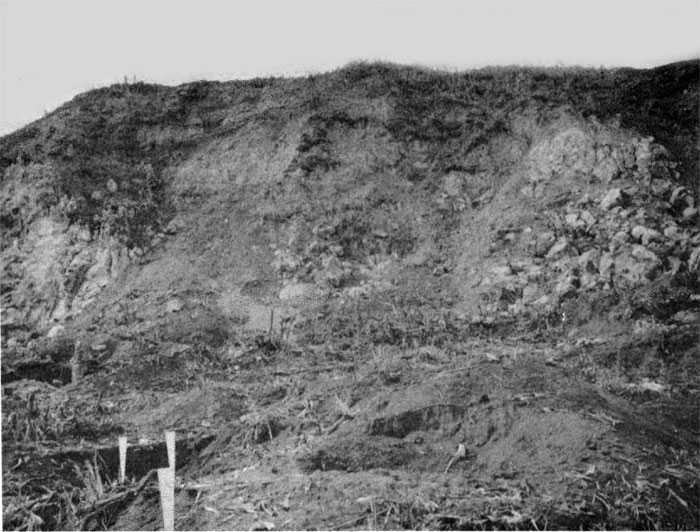
SURIBACHI AREA SHOWING SLIDES CAUSED BY NAVAL GUNFIRE (2).

SURIBACHI AREA SHOWING SLIDES CAUSED BY NAVAL GUNFIRE (3).
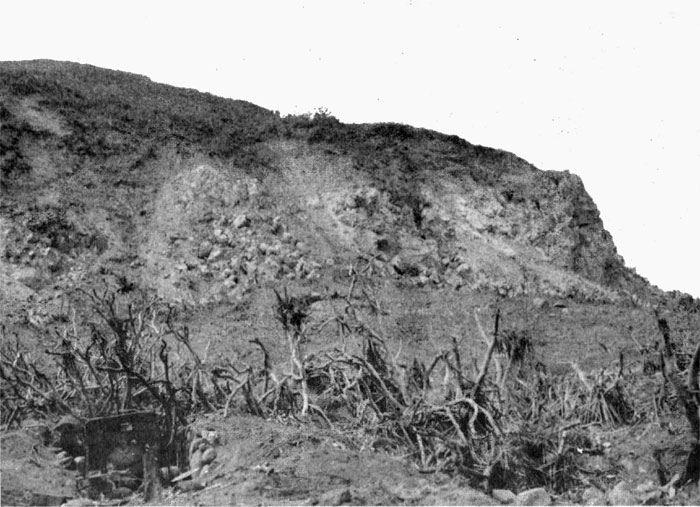
SURIBACHI AREA SHOWING SLIDES CAUSED BY NAVAL GUNFIRE (4).

SURIBACHI AREA SHOWING SLIDES CAUSED BY NAVAL GUNFIRE (5).

SURIBACHI AREA SHOWING SLIDES CAUSED BY NAVAL GUNFIRE (6).
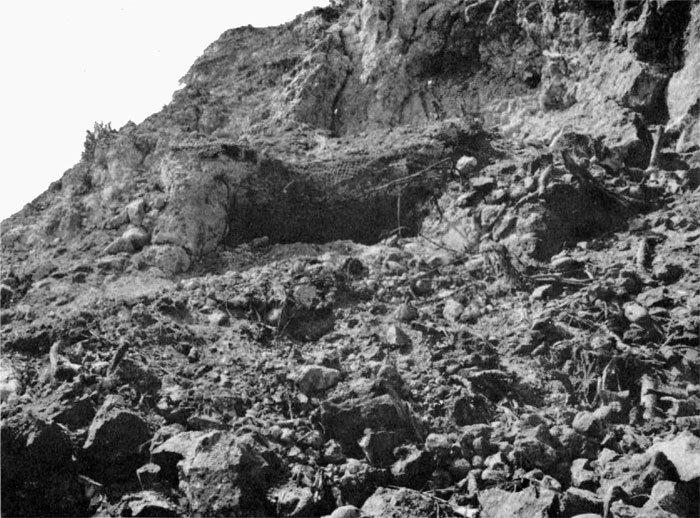
RUINS OF 4 - 120 MM COAST DEFENSE GUNS IN 132 K,L, DESTROYED BY TENNESSEE (1).

RUINS OF 4 - 120 MM COAST DEFENSE GUNS IN 132 K,L, DESTROYED BY TENNESSEE (2).
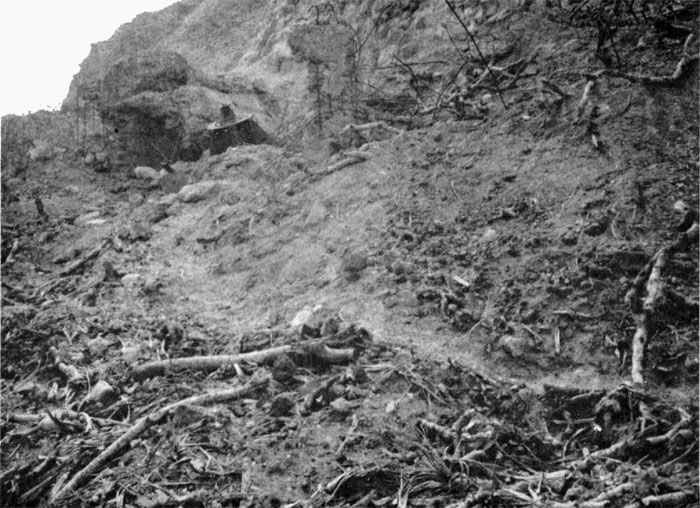
RUINS OF 4 - 120 MM COAST DEFENSE GUNS IN 132 K,L, DESTROYED BY TENNESSEE (3).

CLOSE UP OF THE BREACH OF C.D. GUN.
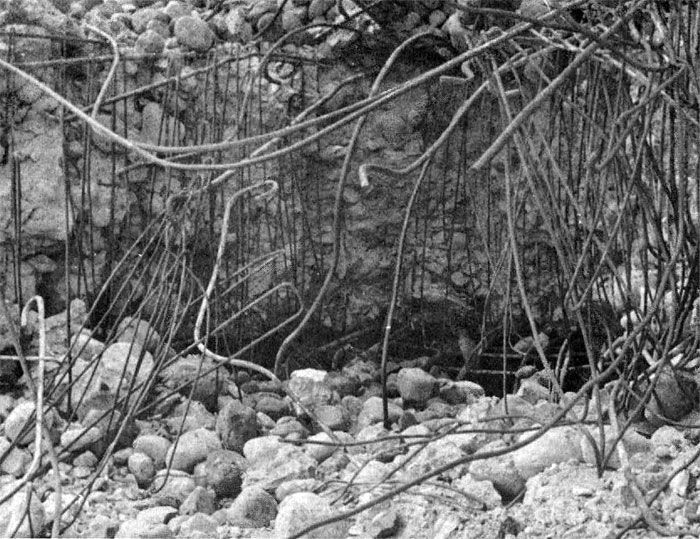
VIEWS OF DAMAGED EMPLACEMETs (1)
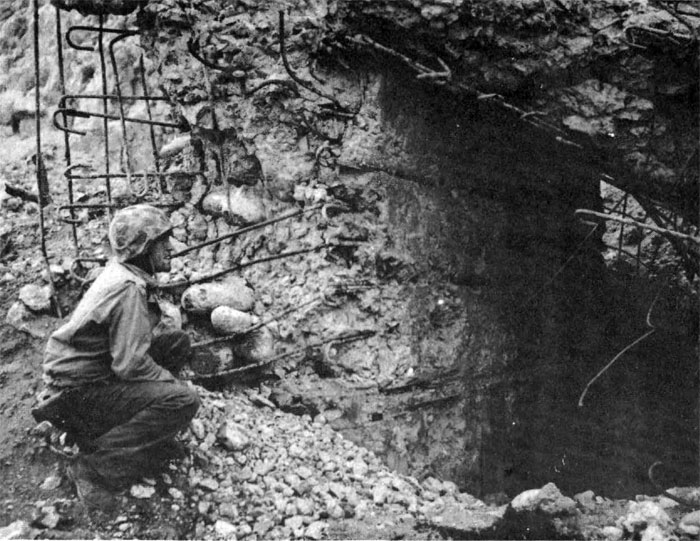
VIEWS OF DAMAGED EMPLACEMETS (2)
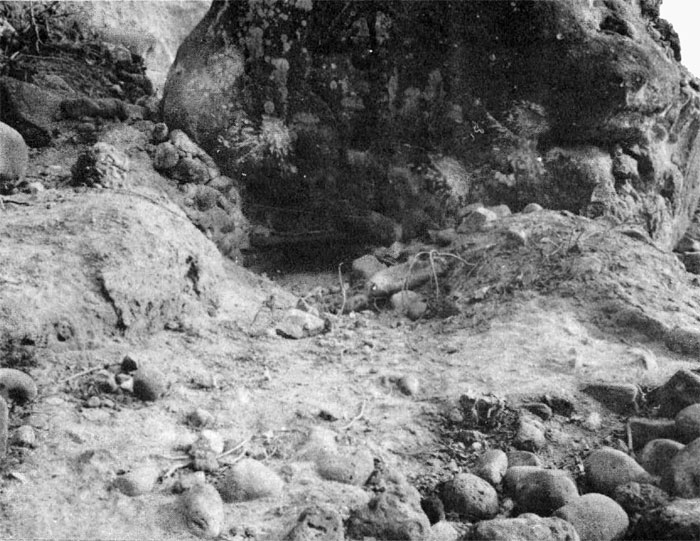
PILLBOX UNDER BOULDER IN 132 M. (1): FIRE PORT

PILLBOX UNDER BOULDER IN 132 M. (2): INTERIOR SHOWING 25 MM MACHINE GUN.
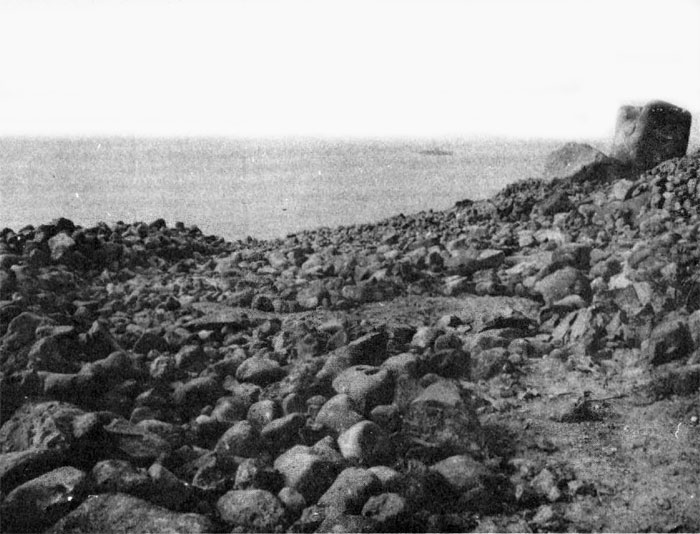
PILLBOX UNDER BOULDER IN 132 M. (3): FIELD OF FIRE

PILL BOX IN 132 Q - DESTROYED ON D+1 BY H.A. WILEY BY DIRECT HITS ON FIRE PORT WITH 5" AA COMMON AT A RANGE OF $)) YARDS (1): FIRE PORT
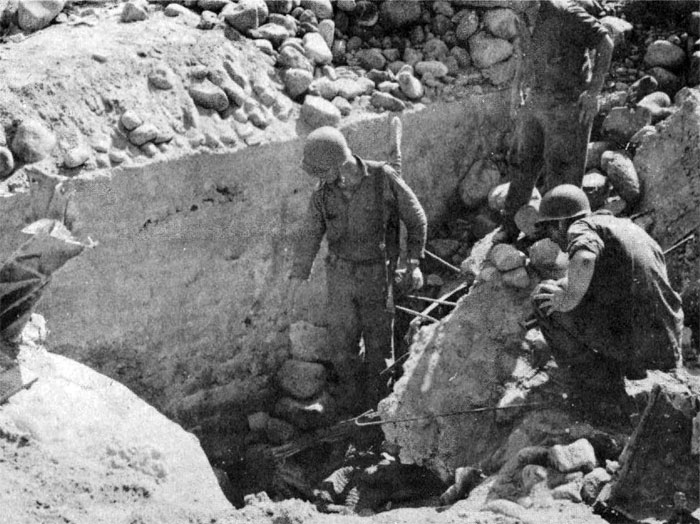
PILL BOX IN 132 Q - DESTROYED ON D+1 BY H.A. WILEY BY DIRECT HITS ON FIRE PORT WITH 5" AA COMMON AT A RANGE OF $)) YARDS (2): REAR VIEW
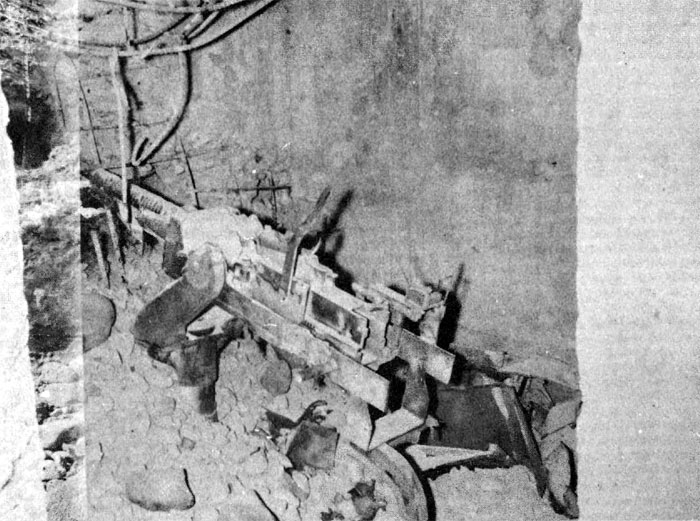
PILL BOX IN 132 Q - DESTROYED ON D+1 BY H.A. WILEY BY DIRECT HITS ON FIRE PORT WITH 5" AA COMMON AT A RANGE OF $)) YARDS (3): INTERIOR VIEW SHOWING 25 MM MACHINE GUN.
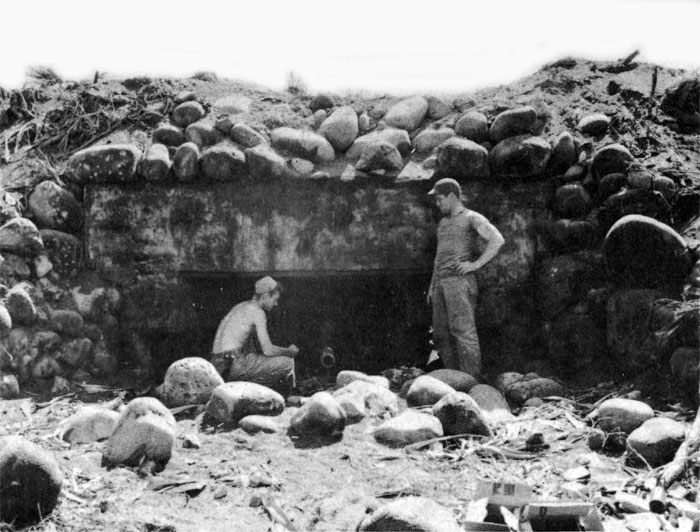
1 - 8 CM. COAST DEFENSE GUN IN TA 147 V - SLIGHTLY DAMAGED BY ARKANSAS (1):
FRONT VIEW OF FIRE PORT
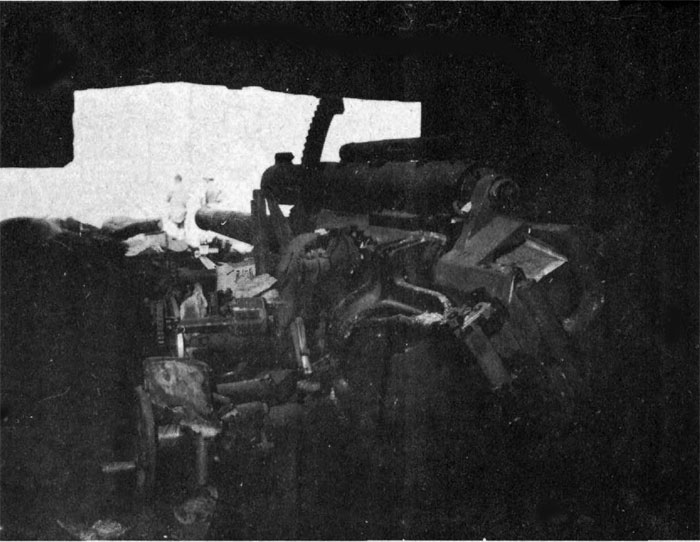
1 - 8 CM. COAST DEFENSE GUN IN TA 147 V - SLIGHTLY DAMAGED BY ARKANSAS (2): INTERIOR VIEW SHOWING GUN AND PORT
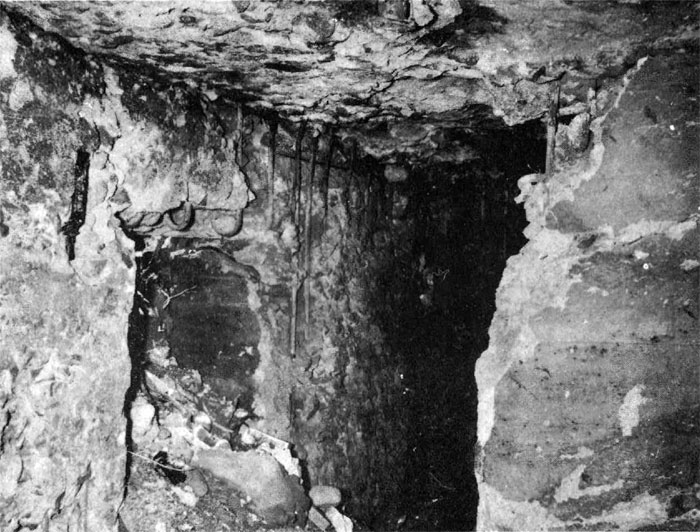
1 - 8 CM. COAST DEFENSE GUN IN TA 147 V - SLIGHTLY DAMAGED BY ARKANSAS (3): REAR ENTRANCE
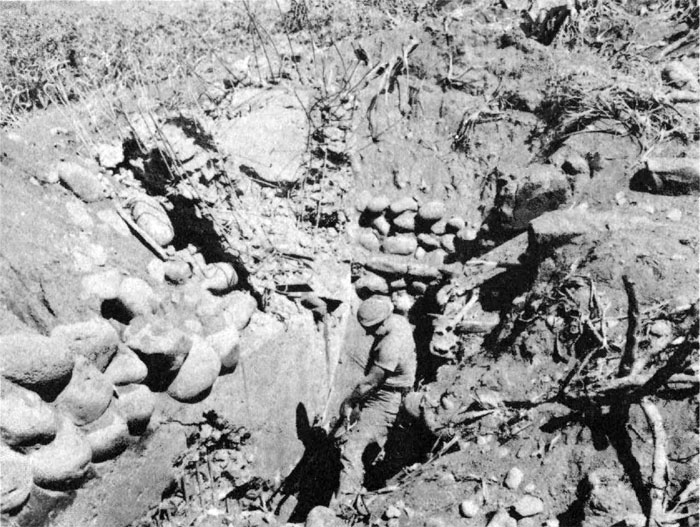
COVERED ARTILLERY EMPLACEMENT IN 147 V - DESTROYED BY ARKANSAS (1): ENTRANCE
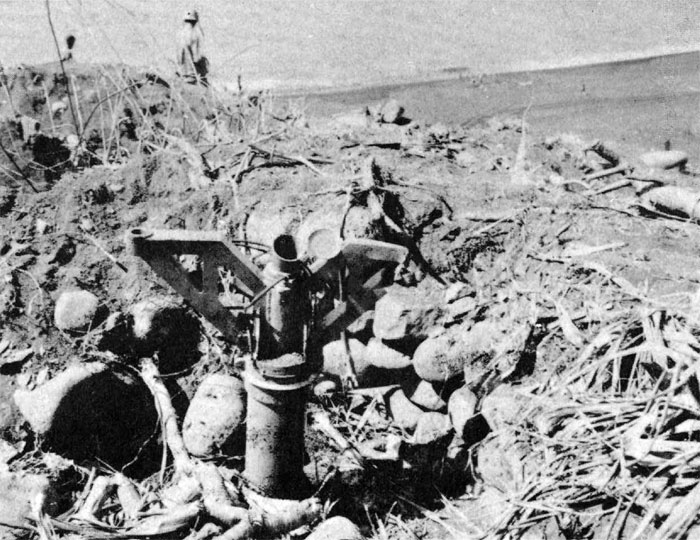
COVERED ARTILLERY EMPLACEMENT IN 147 V - DESTROYED BY ARKANSAS (2): RANGE FINDER MOUNT
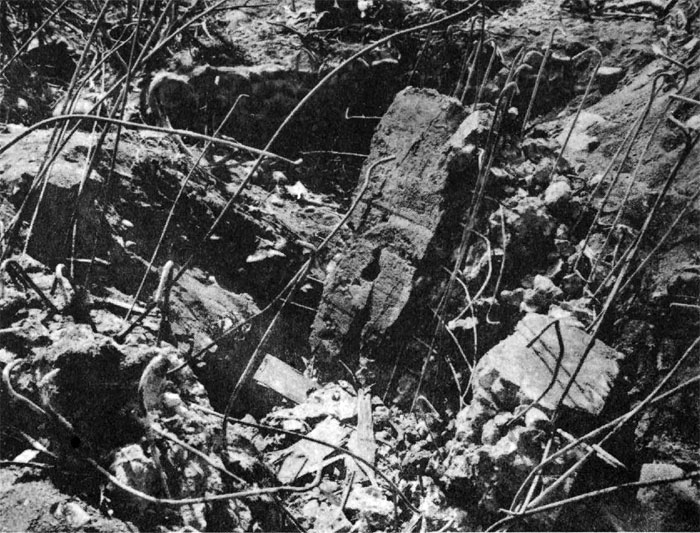
COVERED ARTILLERY EMPLACEMENT IN 147 V - DESTROYED BY ARKANSAS (3): DETAILS OF DESTRUCTION

FRONT VIEW OF PILLBOX IN 132 C FIRING PORT LOCATED TO DELIVER FLANKING FIRE ALONG LANDING BEACH-UNDAMAGED.
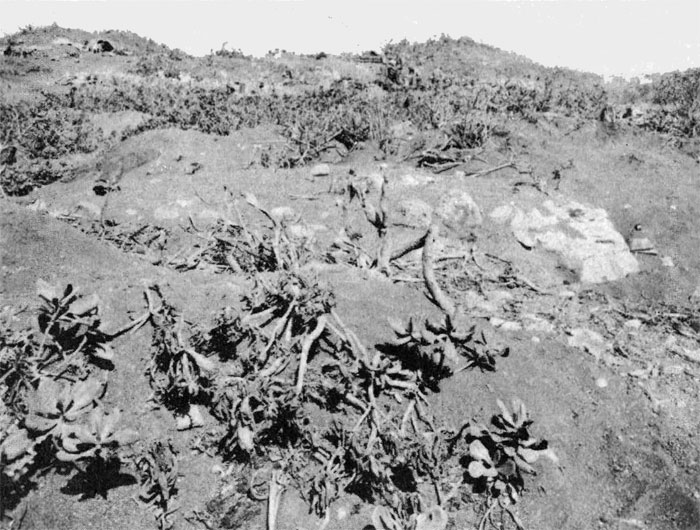
SEAWARD VIEW OF PILLBOX IN 132 C
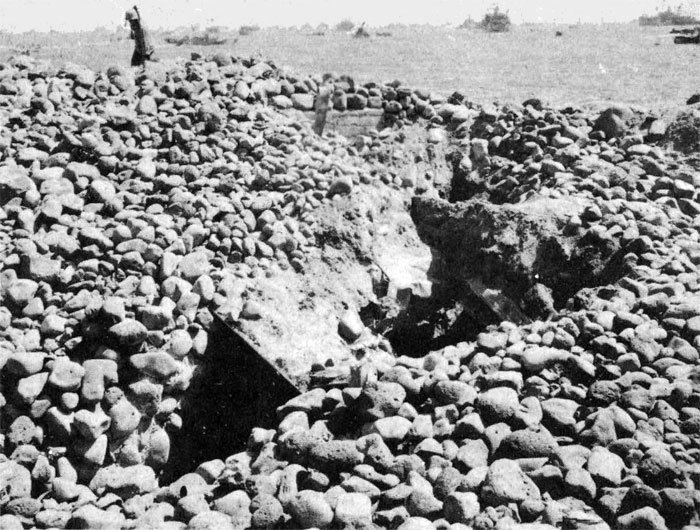
REAR VIEW OF BLOCKHOUSE IN 132 V NOTE FIELD OF FIRE.
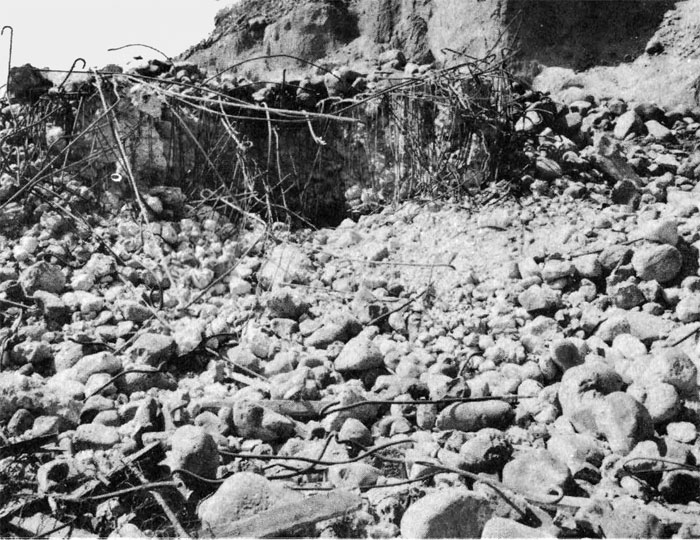
FRONT VIEW OF BLOCKHOUSE IN 132 V DESTROYED BY TENNESSEE.
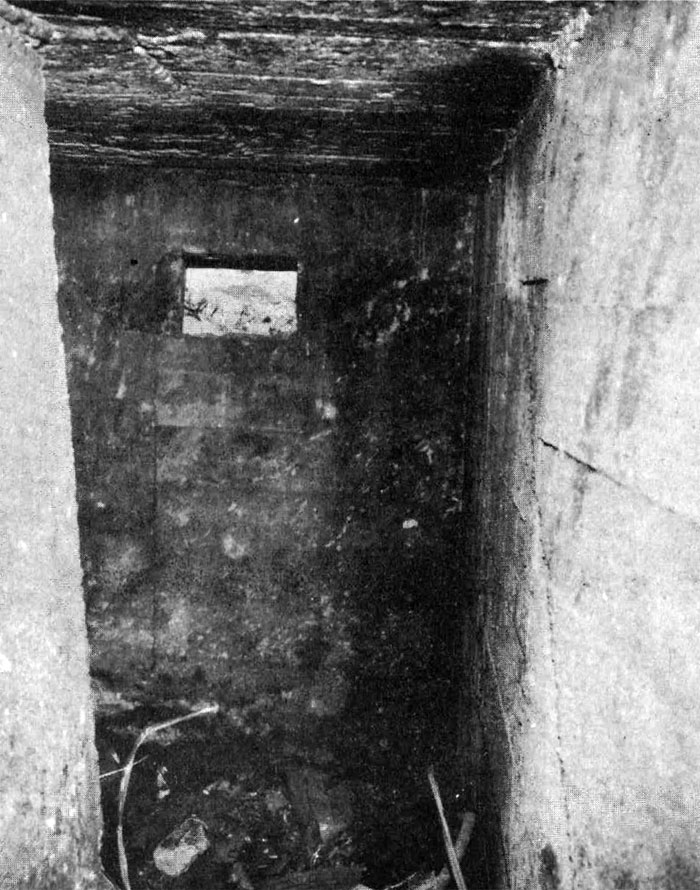
INTERIOR OF PILLBOX IN 132 C SHOWING FIRING PORT.
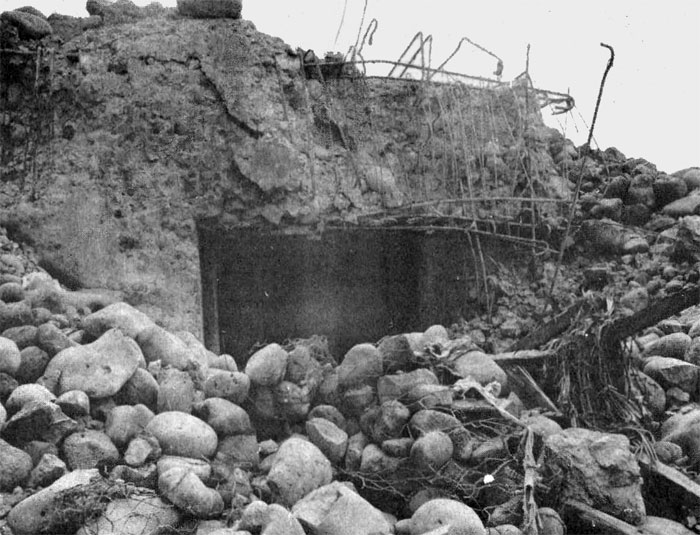
FRONT VIEW SHOWING FIRE PORT.
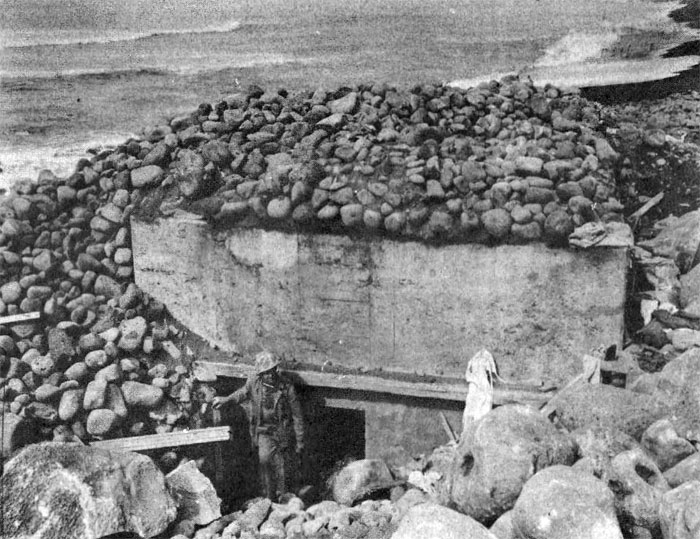
SIDE VIEW
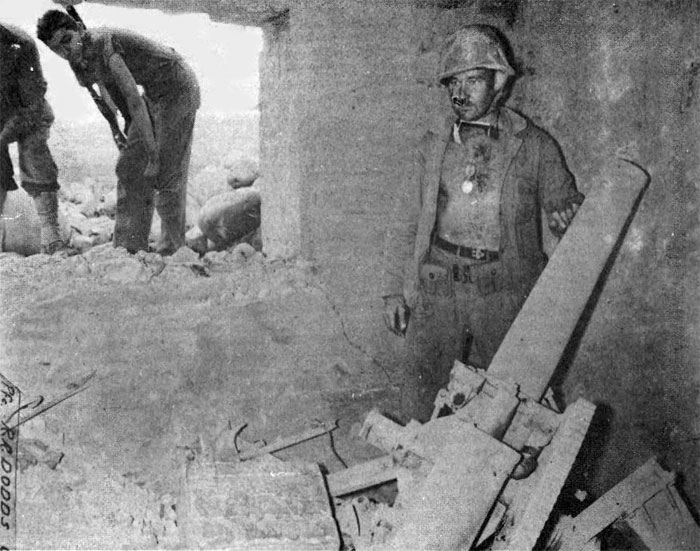
INTERIOR VIEW SHOWING DISMOUNTED 120 MM SHORT BARREL CANNON BLOCKHOUSE IN 146Y - DESTROYED BY ARKANSAS.

AMMUNITION STORAGE ROOM FOR 120 MM. SHORT BARREL CANNON.
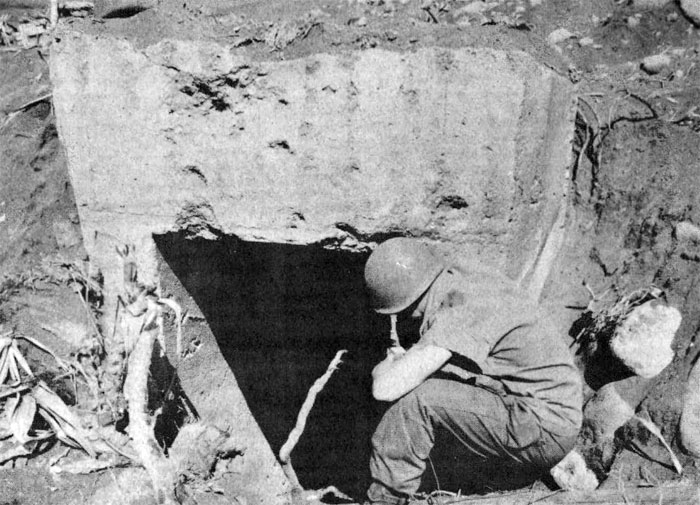
REAR VIEW OF PILL BOX CONTAINING 25 MM MACHINE GUN IN TA 146 Y DESTROYED BY ARKANSAS.
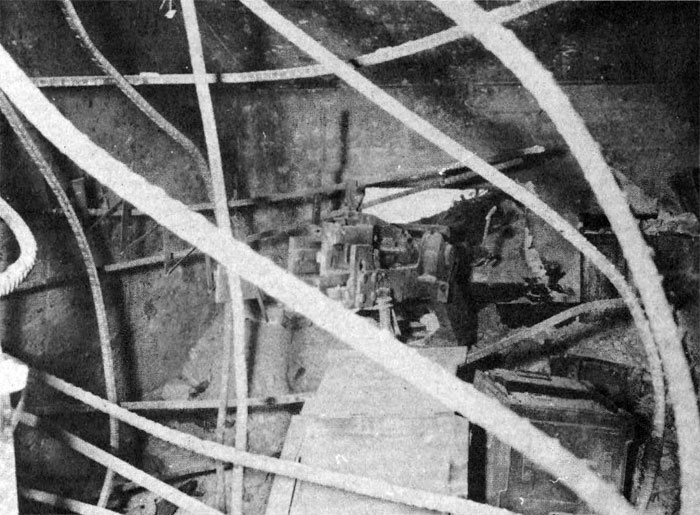
INTERIOR VIEW OF PILL BOX CONTAINING 25 MM MACHINE GUN IN TA 146 Y DESTROYED BY ARKANSAS.
The target areas assigned NEVADA for preliminary firee included enemy installations of all types. The excellent report which this ship submitted, together
with the fact that their assigned targets were so varied, makes possible a more
comprehensive analysis of preliminary fires than of the other ships so engaged.
For this reason NEVADA has been selected as being typical of the cepable ships now
engaged in supporting amphibious operations.
The photographs which follow have been selected as being indicative of the type of targets engaged by NEVADA.
For information and because it is felt that the statements indicate the opinions of most bombarding ships, extracts from NEVADA's action report are quoted below:
"Experience at IWO JIMA shows that firing against, the extremely heavy block houses, covered artillery emplacements, troops shelters, and pill boxes is ineffective at medium and long ranges, even when the spotting planes can see to spot. Only repeated direct hits will destrpy or seriously damage such Installations. The natural dispersion and normal percentage of hits to be expected even with a well aligned and controlled battery demands a large expenditure of ammunition to secure the hits necessary. The greatest amount of damage with the minimum ammunition expenditure is accomplished at ranges of 2000-4000 yards using pointer fire and ships' spots. It is estimated that this ship did over twice as much damage on D-l day at point blank ranges than she did on D-3 and D-E days combined when indirect fire at medium ranges was employed. It is recommended that the heavily armored and heavily armed bombarding ships(bombarding CAs and OBBs) close to short range at the earliest possible moment after known heavy coast defense installations have been neutralized or destroyed. These ships should close in even at the risk of being fired on by unknown and unsuspected camouflaged coast defense guns. They should remain at close range using pointer fire as long as possible or until all visible enemy iastalla-tions have been fired on.
"The danger involved in closing in to short ranges is not considered great, based on the enemy reaction at IWO JIMA. The JAPANESE seem very reluctant to open up and disclose well camouflaged guns. This was shown by the actions of the heavy unknown battery in 183 W which did not open up until the UDT operations took place on D-2 day. This battery had made no attempt to fire on any bombarding ships prior to its opening fire at that time. Another example was the action of the battery at 219 A. This ship was ordered to close in and destroy this battery. The NEVADA closed to within 3200 yards from the beach and opened fire at a range of 3900 yards from the target. During the approach neither gun of the battery fired a shot. While the first gun was being fired on and destroyed, the second gun remained silent even though the range was less than-4000 yards.
"The enemy installations on IWO JIMA were very well camouflaged and of very heavy construction. The large ones could be destroyed or severely damaged only by repeated hits with the main battery. At ranges from 1500 to 2500 yards these targets could be distinguished by ship's spotters and gun pointers and trainers. Pointer fire was most effective as the fall of shot and results could be clearly seen. Most of the damage done to enemy installations by NEVADA'S gunfire was accomplished at short ranges with pointer fire. The performance of 14"/45 H.C. projectiles was excellent. No duds were observed. H.C. projectiles with steel nose plugs were used exclusively against the heavy enemy installations. The H.C. projectiles with Mk. 29-3 fuses set on super-quick were not effective and their only effect was to blow away sand and dirt, with which the installations were covered, without penetrating. A few Av.P. projectiles were used and from the limited observation possible, it is believed that they are more effective against heavy installations than the H.C. with steel nose plugs. The 5B/38 fire was generally ineffective for destructive purposes at all ranges against the heavy enemy installations. Numerous installations were fired on by the 5"/38 battery and many direct hits made, but apparently little damage was done. The 5"/38 battery was used extensively to strip camouflage and to explore suspicious1 areas. This was very effective in determining real from apparent targets before the main battery opened fire on them and thereby contributed greatly to the conservation of main battery ammunition. The 5"/38 battery was also used to fire anti-personnel air bursts. There was no visible enemy activity in the NEVADA'S sector of responsibility and hence the effectiveness of the air bursts is not known. The air bursts were fired to cover the assigned areas. No difficulty was experienced in covering the areas nor in placing the air bursts at the correct altitude. The appearance of many small puffs of dust over a wide area beneath the bursts indicated that the fragmentation wae excellent.
"Several types of main battery fire control were used. For close range work, 2000-5000 yards, when the target could be clearly seen, pointer fire wae used. This wae most effective snd resulted in maximum damage with minimum ammunition expenditure. For medium ranges, director fire was used when a definite point of aim could be distinguished. In some cases a point of aim other than the target wae used and ballistic spots in range and deflection were applied to put fall of shot on the target which was not visible. Air spot was then used for final adjustment. For ranges outside of 8000 yards, indirect fire with the Mk. 1 Mod.. 23 rangekeeper in emergency wae used with air spot. For ranges under 8000 yards, indirect fire is N impossible when the ship is underway ss the minimum range of the Mk. 1 Mod. 23 rangekeeper is 8000 yards. Below this range, it is not possible to maintain a rangekeeper solution. This is a serious handicap for shore bombardment work at short ranges.
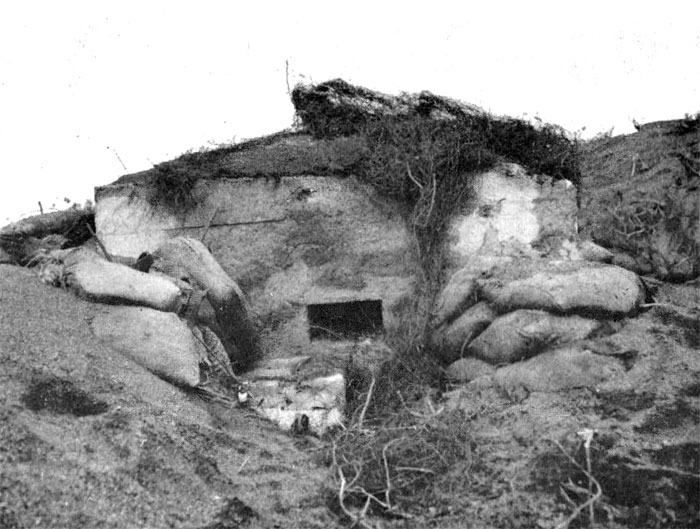
BLOCKHOUSE LOCATED IN TA 148 M DESTROYED BY NEVADA (1): FRONT PORT

BLOCKHOUSE LOCATED IN TA 148 M DESTROYED BY NEVADA (2): REAR

BLOCKHOUSE LOCATED IN TA 148 M DESTROYED BY NEVADA (3): SIDE
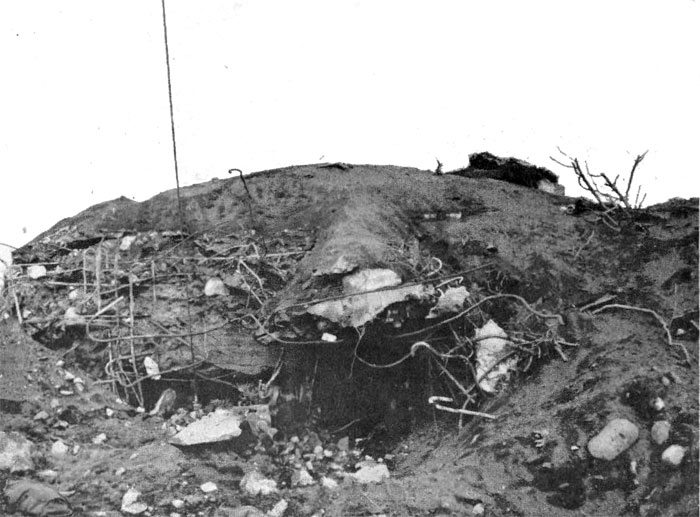
BLOCKHOUSE LOCATED IN TA 148 M DESTROYED BY NEVADA (4): FRONT -VIEW A

BLOCKHOUSE LOCATED IN TA 148 M DESTROYED BY NEVADA (5): FRONT - VIEW B

BLOCKHOUSE IN NORTHEAST SECTION OF TA 148 H BEFORE PRELIMINARY BOMBARDMENT.
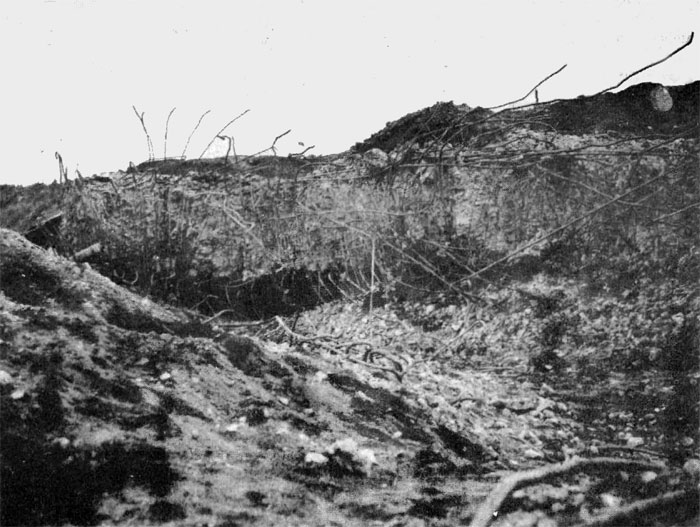
BLOCKHOUSE AFTER PRELIMINARY BOMBARDMENT IN NORTHEAST SECTION OF TA 148 H.(1)

BLOCKHOUSE AFTER PRELIMINARY BOMBARDMENT IN NORTHEAST SECTION OF TA 148 H.(2)
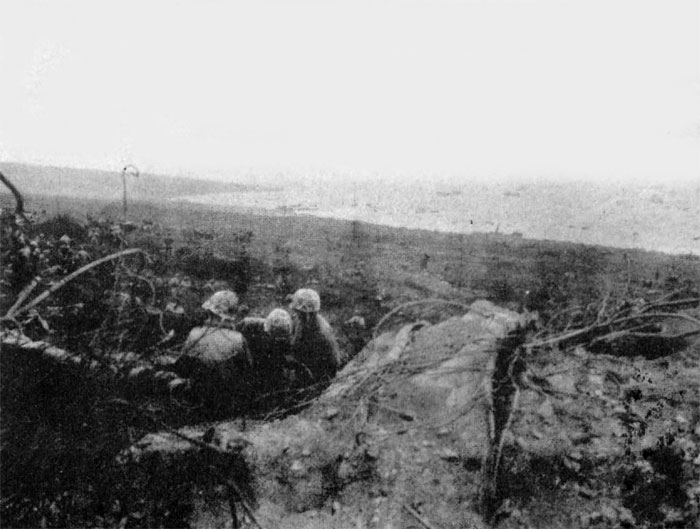
BLOCKHOUSE AFTER PRELIMINARY BOMBARDMENT IN NORTHEAST SECTION OF TA 148 H SHOWING-FIELD OF FIRE.
SHIP'Ss EVALUATION OF RESULTS OF FIRING; 40 ROUNDS 14" HC. - RANGE 8,050 YARDS. POSSIBLE DAMAGE TO SOUTHERN SIDE OF BLOCKHOUSE, NO DAMAGE TO STRUCTURE. 8 ROUNDS 14" HC. - RANGE 3,200 YARDS. FOUR DIRECT HITS, ONE OF WHICH STARTED FIRE. INSTALLATION SEVERELY DAMAGED. 5 ROUNDS 14" HC. FOUR HITS. BLOCKHOUSE SEVERLY DAMAGED.
API EVALUATION - NONE. JICPOA EVALUATION - DESTROYED, FINAL EVALUATION - DESTROYED.

BLOCKHOUSE IN CENTER OF TA 148 J BEFORE PRELIMINARY NAVAL BOMBARDMENT.
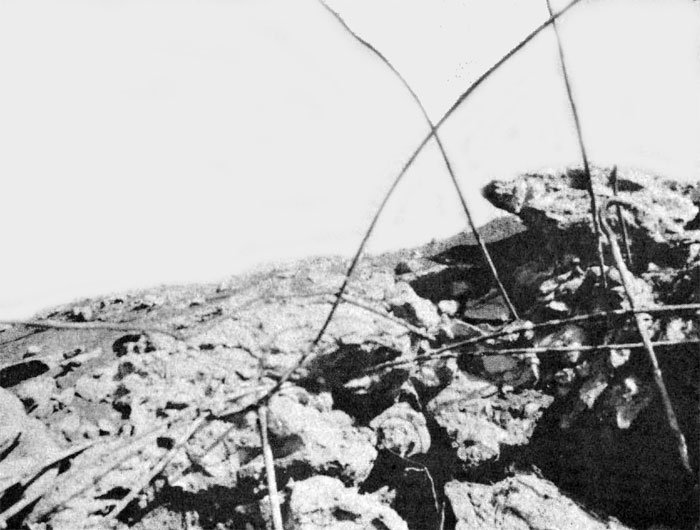
VIEWS OF SAME BLOCKHOUSE IN CENTER OF TA 148 J AFTER PRELIMINARY NAVAL BOMBARDMENT (1).

VIEWS OF SAME BLOCKHOUSE IN CENTER OF TA 148 J AFTER PRELIMINARY NAVAL BOMBARDMENT (2).
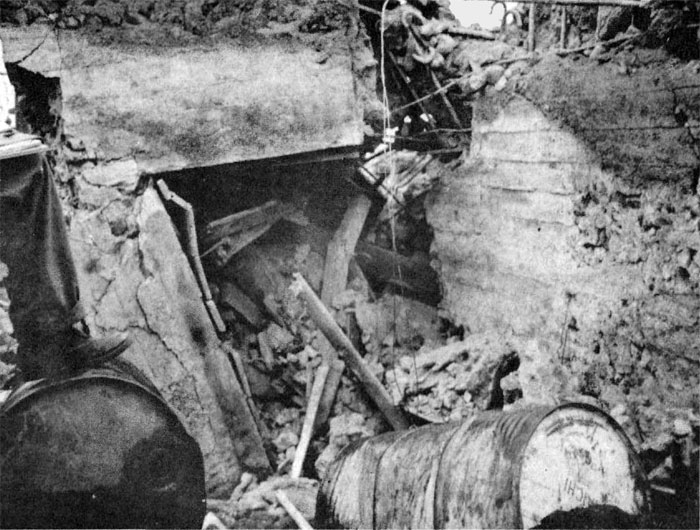
VIEWS OF SAME BLOCKHOUSE IN CENTER OF TA 148 J AFTER PRELIMINARY NAVAL BOMBARDMENT (3).
SHIP'S EVALUATION OF RESULTS OF FIRING: 12 ROUNDS 14" HC. RANGE - 11,600 YARDS. PLANE REPORTED HITS ON AND AROUND TARGET. 1 ROUND HC. RANGE - 3,100 YARDS. ONE HIT ON SOUTHERN END BLOCKING SOUTHERN ENTRANCE TO BLOCKHOUSE. 17 ROUNDS HC. RANGE - 3,075 YARDS. THREE DIRECT HITS. INSTALLATION COMPLETELY DESTROYED.
API EVALUATION - DESTROYED; JICPOA EVALUATION - DESTROYED; FINAL EVALUATION - DESTROYED.

BLOCKHOUSE IN SOUTHWEST CORNER OF TA 148 J BEFORE PRELIMINARY NAVAL BOMBARDMENT.
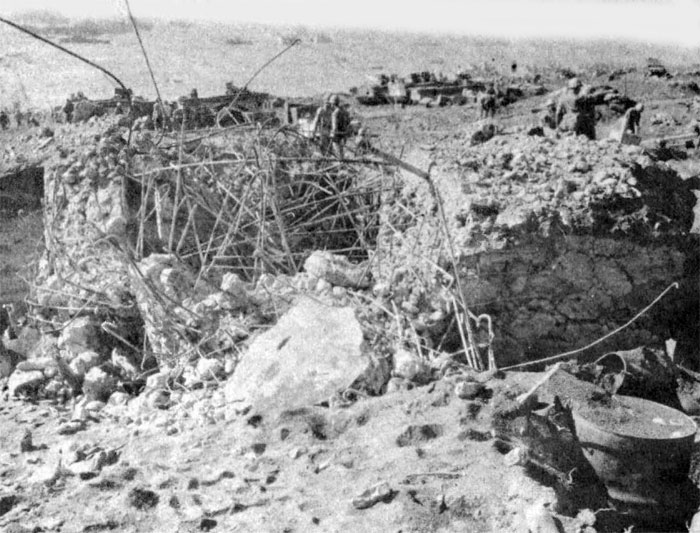
SAME BLOCKHOUSE IN SOUTHWEST CORNER OF TA 148 J AFTER PRELIMINARY NAVAL BOMBARDMENT (1).
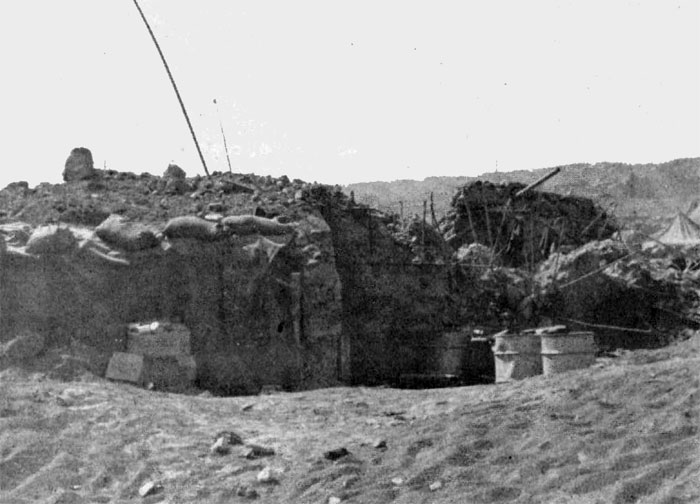
SAME BLOCKHOUSE IN SOUTHWEST CORNER OF TA 148 J AFTER PRELIMINARY NAVAL BOMBARDMENT (2).
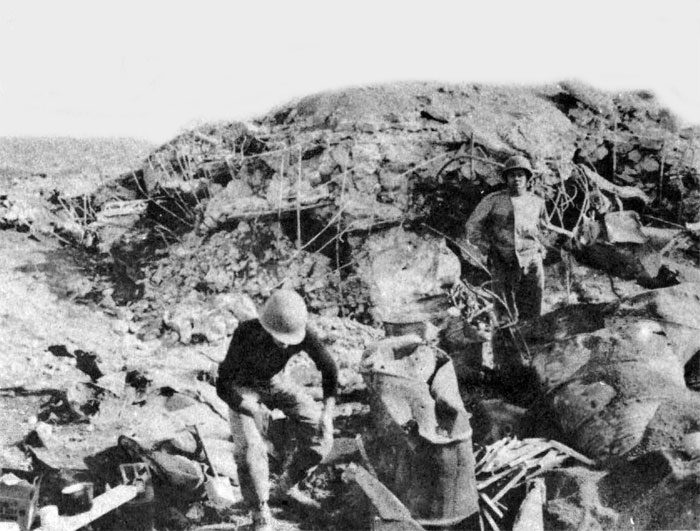
SAME BLOCKHOUSE IN SOUTHWEST CORNER OF TA 148 J AFTER PRELIMINARY NAVAL BOMBARDMENT (3).
SHIP'S EVALUATION OF RESULTS OF FIRING: 14 ROUNDS 14" HC - RANGE 11,600
YARDS. TWO NEAR MISSES. TWO HITS ON RAILROAD LEADING TO TARGET. 4 ROUNDS
14" HC - RANGE 3,100 YARDS. ONE DIRECT HIT ON NORTHERN END CAUSING GREAT
AMOUNT OF DAMAGE TO THIS PART OF BLOCKHOUSE.
API EVALUATION - DESTROYED; JICPOA EVALUATION - DESTROYED; FINAL EVALUATION - DESTROYED
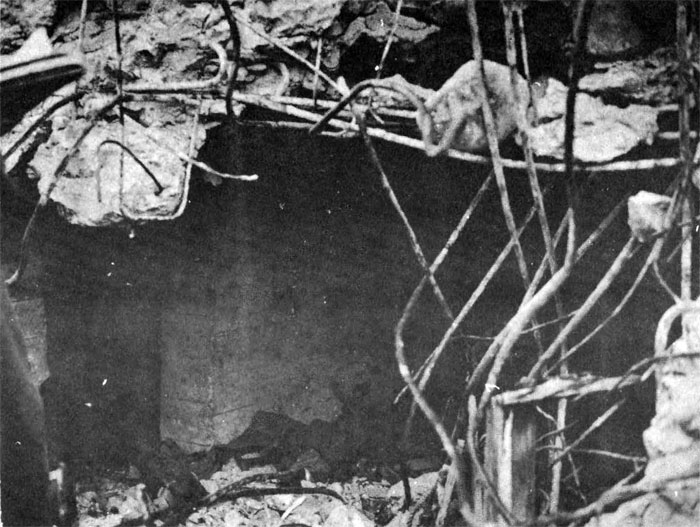
INTERIOR OF BLOCKHOUSE IN NORTH SECTION OF TA 148 N AFTER PRELIMINARY NAVAL BOMBARDMENT.
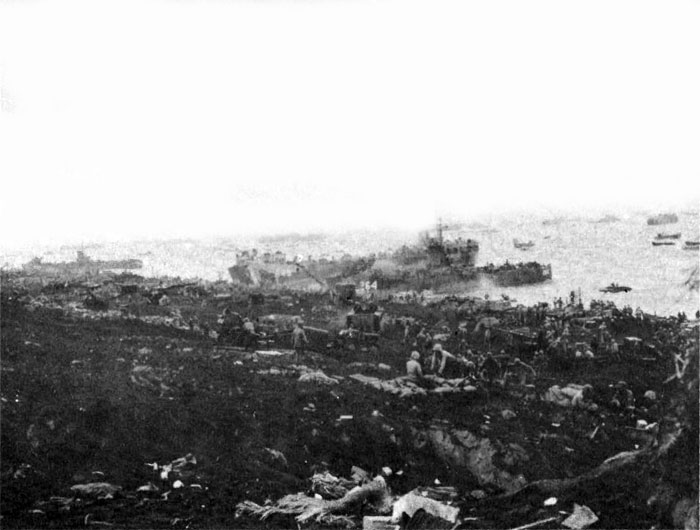
FIELD OF FIRE FROM BLOCKHOUSE IN NORTH SECTION1 OF TA 148 N AFTER PRELIMINARY NAVAL BOMBARDMENT.
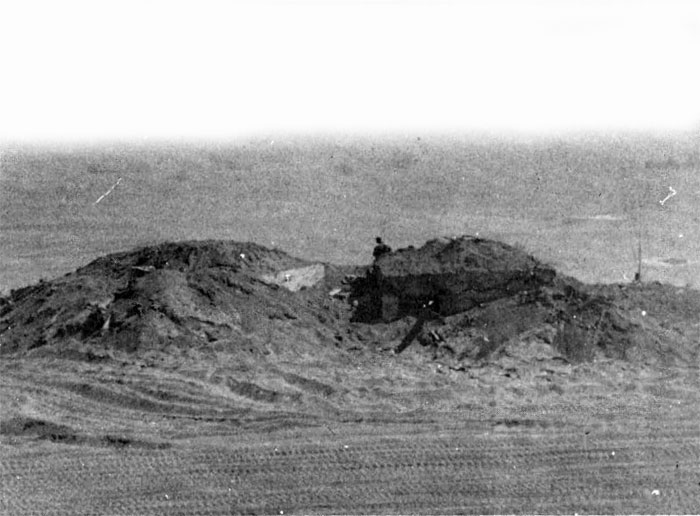
BLOCKHOUSE IN NORTH SECTION OF TA 148 N AFTER PRELIMINARY NAVAL BOMBARDMENT.

OPENING IN BLOCKHOUSE IN NORTH SECTION OF TA 148 N AFTER PRELIMINARY NAVAL BOMBARDMENT.
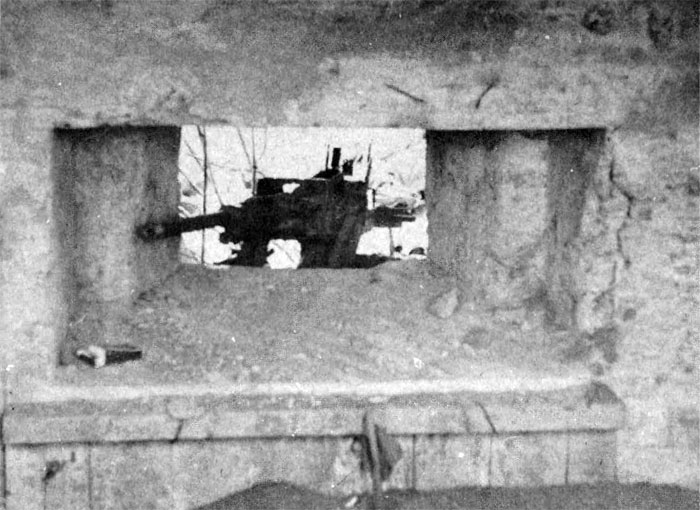
GUN PORT IN BLOCKHOUSE IN NORTH SECTION
OF TA 148 N AFTER PRELIMINARY
BOMBARDMENT.
SHIP'S EVALUATION OF RESULTS OF FIRING: 6 ROUNDS 14" HC. RANGE - 10,200 YARDS. SPOTTING PLANE REPORTED HITS ON INSTALLATION BUT NO APPARENT DAMAGE.
API EVALUATION - DESTROYED; JICPOA EVALUATION - DESTROYED; FINAL EVALUATION - DESTROYED
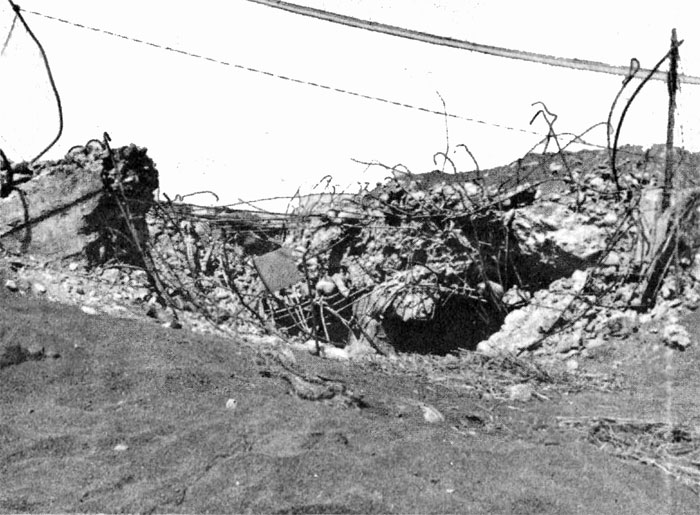
VIEW OF BLOCKHOUSE IN SOUTH SECTION OF TA 148 N AFTER PRELIMINARY NAVAL BOMBARDMENT (1).
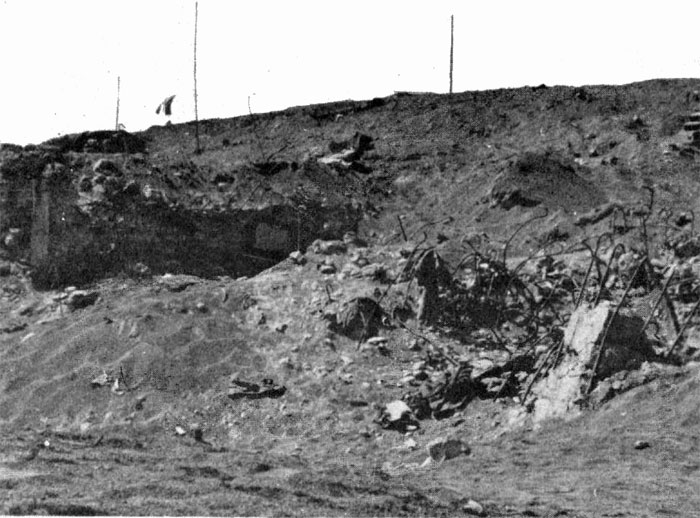
VIEW OF BLOCKHOUSE IN SOUTH SECTION OF TA 148 N AFTER PRELIMINARY NAVAL BOMBARDMENT (2).
SHIP'S EVALUATION OF RESULTS OF FIRING: 24 ROUNDS 14" HC. RANGE - 6000 YARDS. TWO HITS, ONE AT BASE IN FRONT AND ONE ON TOP. NO DAMAGE APPARENT. SPOTTING PLANE REPORTED LARGE EXPLOSION IN AREA OF TARGET. 3 ROUNDS 14" HC. RANGE -2,700 YARDS. ONE DIRECT HIT ON TOP WHICH APPARENTLY PENETRATED BLOWING LARGE HOLE IN STRUCTURE AND SCATTERING LARGE AMOUNT OF DEBRIS. ONE OTHER DIRECT HIT CAUSED SEVERE DAMAGE. INSTALLATION COMPLETELY DESTROYED.
API EVALUATION - DESTROYED; JICPOA EVALUATION - DESTROYED; FINAL EVALUATION - DESTROYED.

VIEW OF BLOCKHOUSE IN TA 148 ft BEFORE PRELIMINARY BOMBARDMENT.
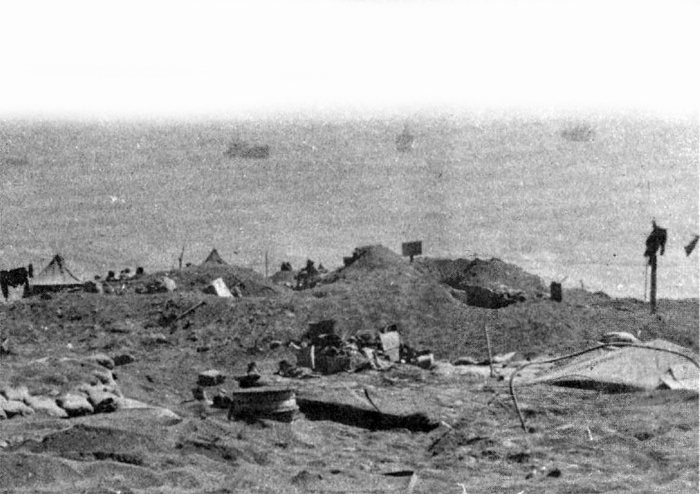
VIEW OF BLOCKHOUSE IN TA 148 Q, AFTER PRELIMINARY BOMBARDMENT (1).

VIEW OF BLOCKHOUSE IN TA 148 Q, AFTER PRELIMINARY BOMBARDMENT (2).
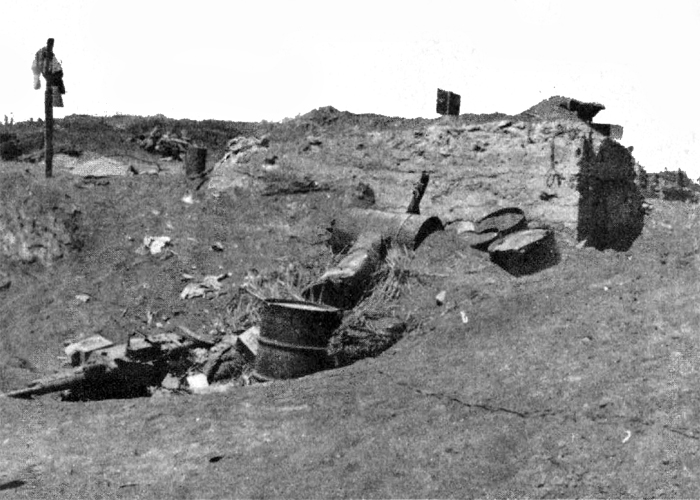
VIEW OF BLOCKHOUSE IN TA 148 Q, AFTER PRELIMINARY BOMBARDMENT (3).
SHIP'S EVALUATION OF RESULTS OF FIRING: 8 ROUNDS 14" HC. RANGE - 2,975 YARDS. TWO DIRECT HITS ON LEFT SIDE OF STRUCTURE. POSSIBLE DAMAGE; STRUCTURE EXPOSED. 12 ROUNDS 14" AP; 7 ROUNDS 14" HC. RANGE - 2600 YARDS. FOUR DIRECT HITS. TWO HITS WITH AP PROJECTILES APPEARED TO DO GREAT DAMAGE. TARGET COMPLETELY DESTROYED.
API EVALUATION - DESTROYED; JICPOA EVALUATION - DESTROYED; FINAL EVALUATION - DESTROYED.
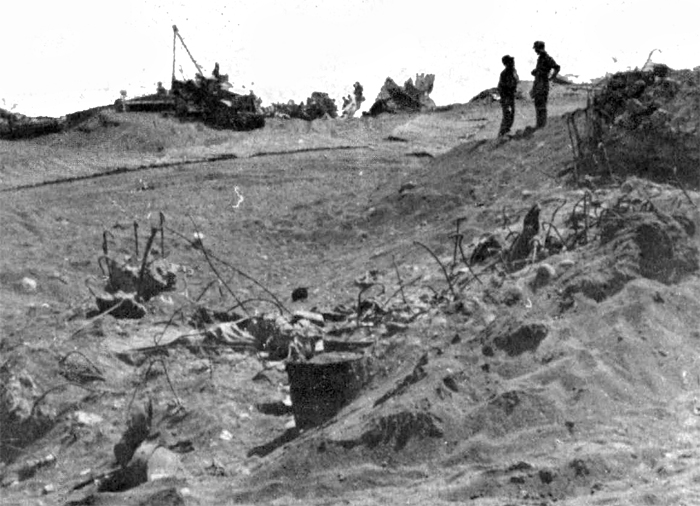
VIEW OF BLOCKHOUSE IN NORTH CENTER OP TA 148 S AFTER PRELIMINARY NAVAL BOMBARDMENT (1).
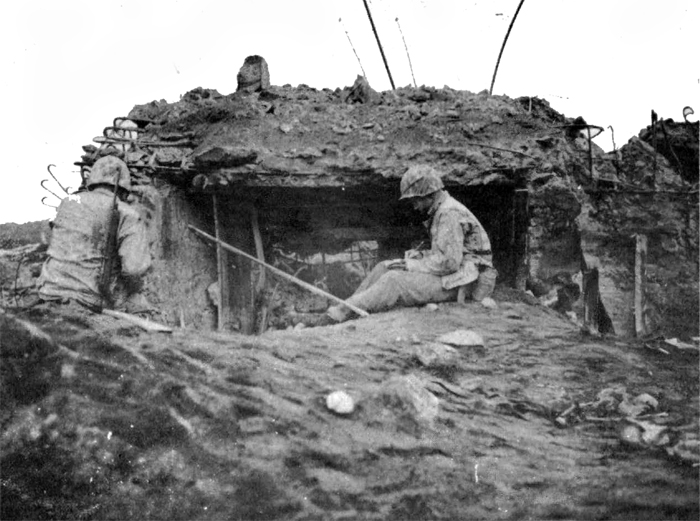
VIEW OF BLOCKHOUSE IN NORTH CENTER OP TA 148 S AFTER PRELIMINARY NAVAL BOMBARDMENT (2).
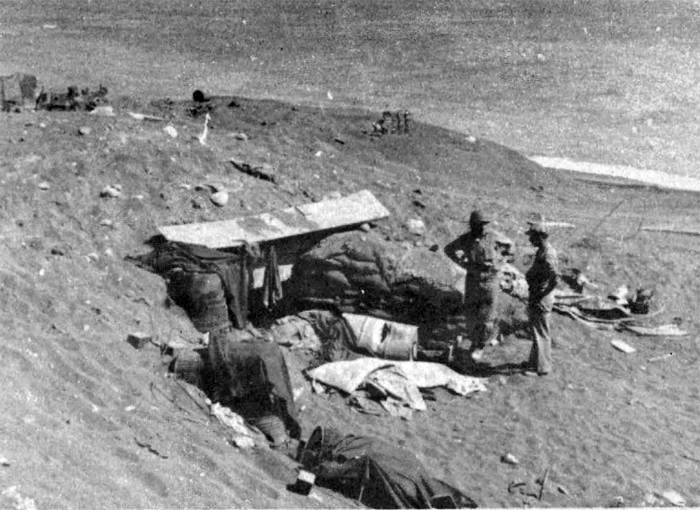
VIEW OF BLOCKHOUSE IN NORTH CENTER OP TA 148 S AFTER PRELIMINARY NAVAL BOMBARDMENT (3).
SHIP'S EVALUATION OF RESULTS OF FIRING: 5 ROUNDS 14" HC. RANGE - 2,700 YARDS. THREE DIRECT HITS. STRUCTURE CUT IN HALF AND INSTALLATION COMPLETELY DESTROYED.
API EVALUATION - DESTROYED; JICPOA EVALUATION - DESTROYED; FINAL EVALUATION - DESTROYED.

COVERED ARTILLERY EMPLACEMENT - 25 MM AND 47 MM GUNS IN WEST SECTION OF TA 149 A BEFORE PRELIMINARY BOMBARDMENT.
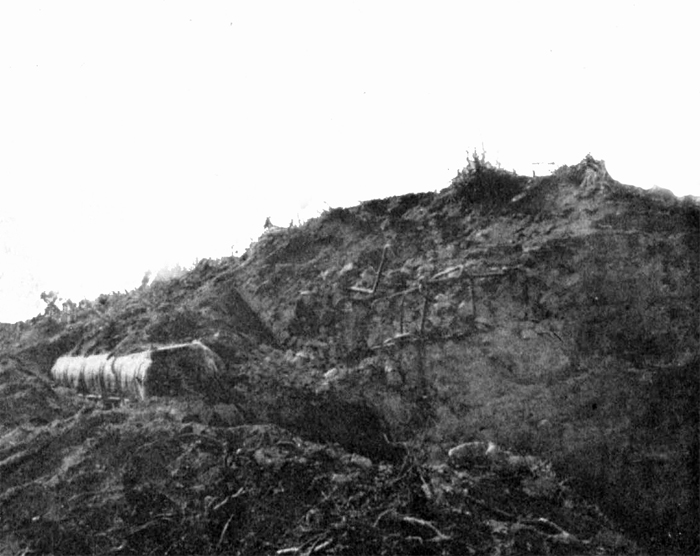
COVERED ARTILLERY EMPLACEMENT - 25 MM AND 47 MM GUNS IN WEST SECTION OF TA 149 A AFTER PRELIMINARY NAVAL BOMBARDMENT.
SHIP'S EVALUATION OF RESULTS OF FIRING: 3 ROUNDS 14" HC. RANGE - 9,500 YARDS. API EVALUATION - NONE; JICPOA EVALUATION - DAMAGED; FINAL EVALUATION - DAMAGED.
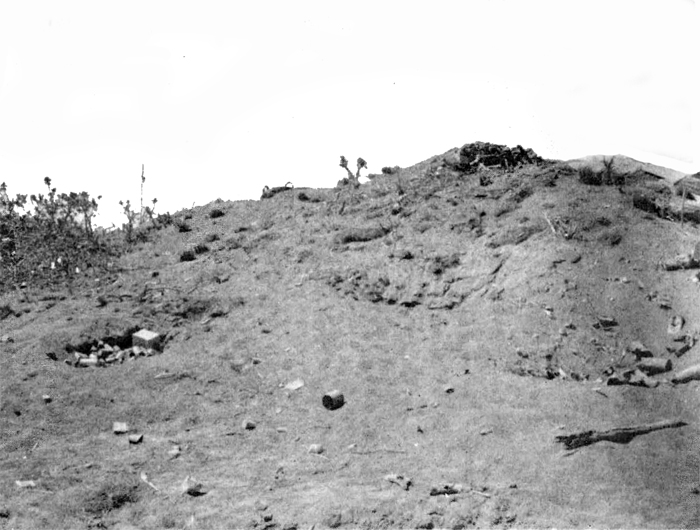
VIEW OF EMPLACEMENT FROM SEAWARD

FIRING PORT OF EMPLACEMENT
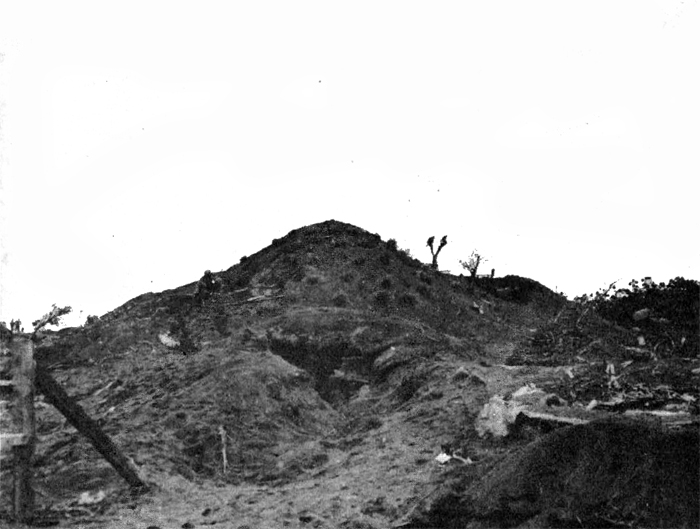
VIEW OF EMPLACEMENT

RANGE FINDER BRACKET

CLOSE UP OF FIRING PORT AND CANNON

INTERIOR OF EMPLACEMTNT SHOWING PORT AND CANNON
COVERED ARTILLERY EMPLACEMENT CONTAINING 120 MM SHORT BARREL CANNON - UNDAMAGED. FIRED ON BY NEVADA ON D-1 WITH 37 ROUNDS OF 14 INCH NO DAMAGE CLAIMED. KNOCKED OUT ON D-DAY BY TROOPS EMPLOYING FLAME THROWERS LOCATED IN TA 148 L.
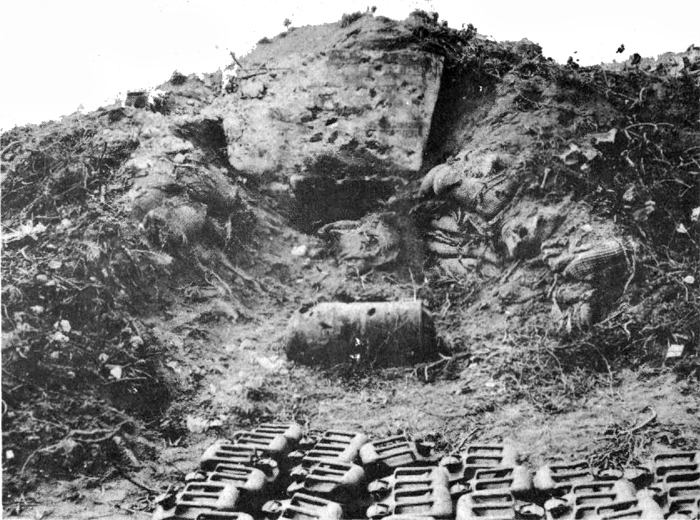
BLOCKHOUSE IN 165 V DAMAGED BY NEW YORK (1):
FIRE PORT
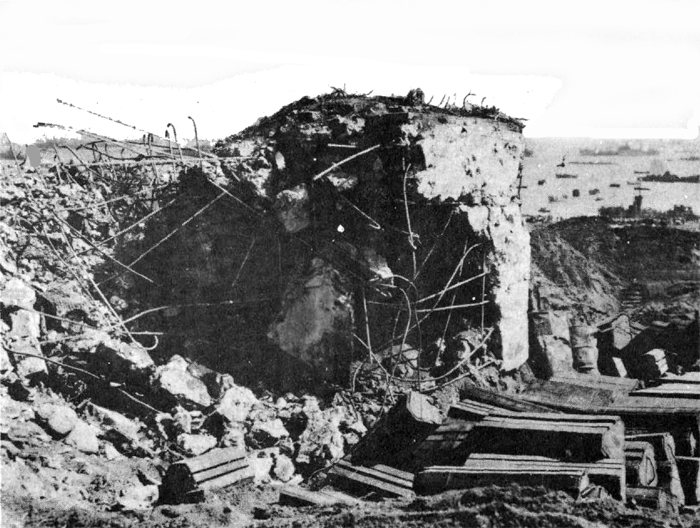
BLOCKHOUSE IN 165 V DAMAGED BY NEW YORK (2): DAMAGE

BLOCKHOUSE IN 165 X SLIGHTLY DAMAGED BY NEW YORK.
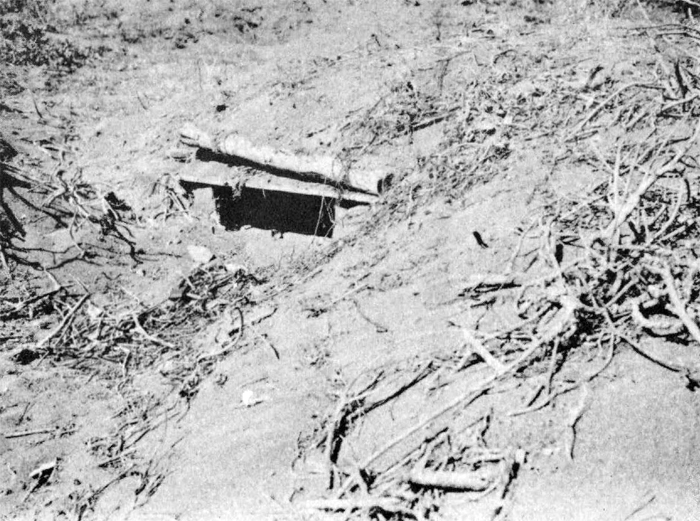
FIRE PORT OF UNDAMAGED PILLBOX IN 165 Q
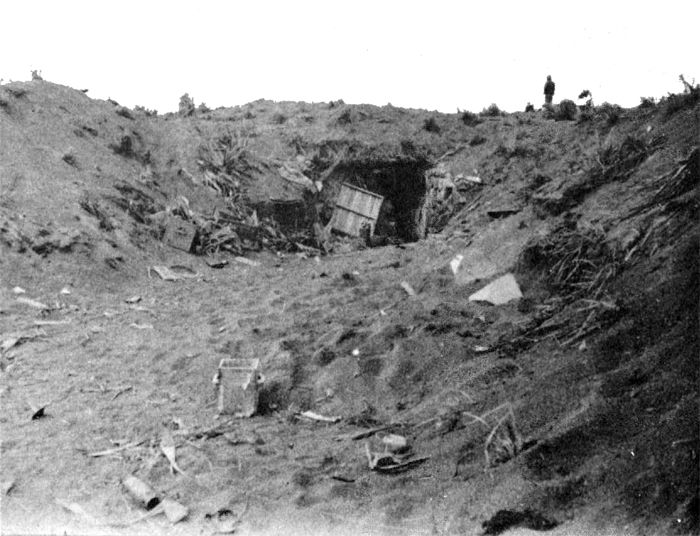
FIRE PORT OF UNDAMAGED 47 MM A.T. GUN IN 165 E
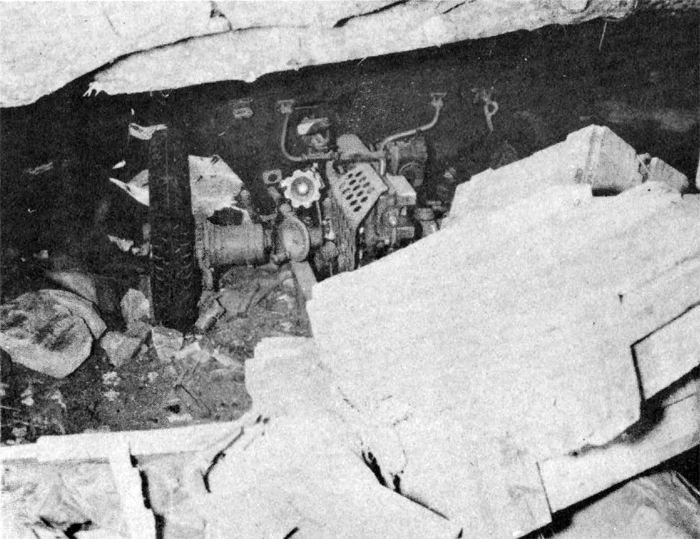
REAR VIEW OF 47 MM A.T. GUN TA 165E
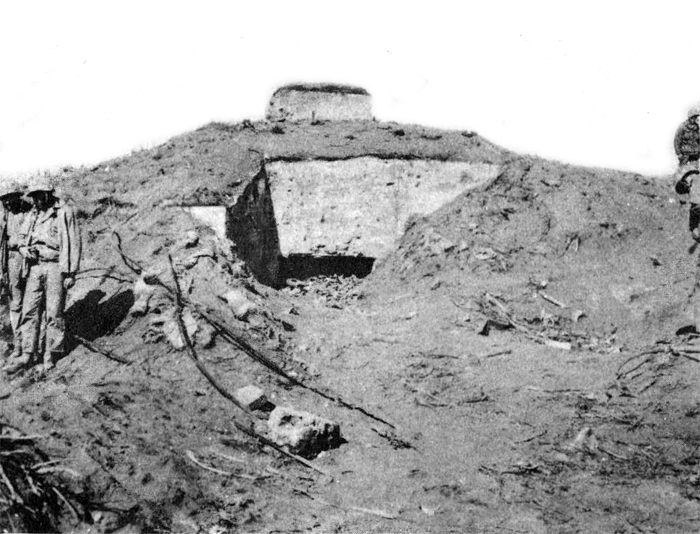
BLOCKHOUSE CONTAINING 25MM MACHINE GUNS IN TA 165 N SLIGHTLY DAMAGED BY NEW YORK (1): FIRE PORT

BLOCKHOUSE CONTAINING 25MM MACHINE GUNS IN TA 165 N SLIGHTLY DAMAGED BY NEW YORK (2): CLOSE UP OF FIRE PORT

BLOCKHOUSE CONTAINING 25MM MACHINE GUNS IN TA 165 N SLIGHTLY DAMAGED BY NEW YORK (3): REAR ENTRANCE
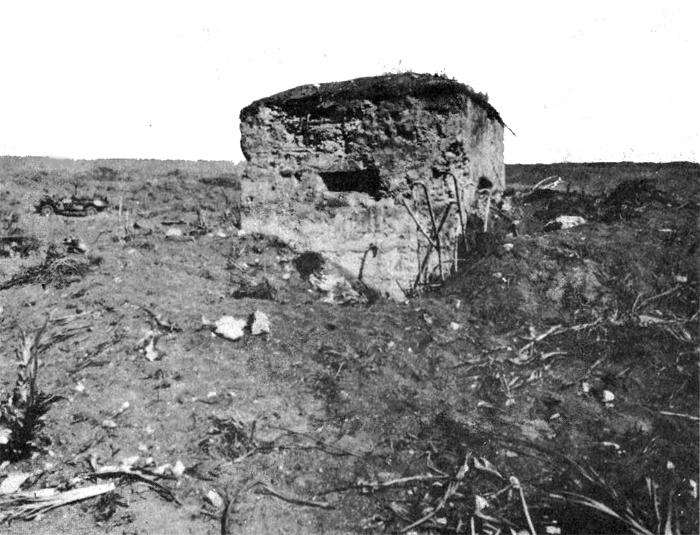
BLOCKHOUSE CONTAINING 25MM MACHINE GUNS IN TA 165 N SLIGHTLY DAMAGED BY NEW YORK (4): LOOKOUT TOWER
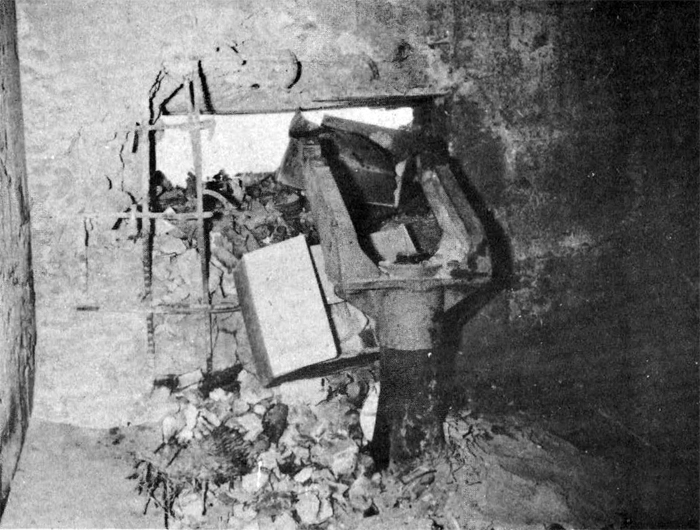
BLOCKHOUSE CONTAINING 25MM MACHINE GUNS IN TA 165 N SLIGHTLY DAMAGED BY NEW YORK (5): INTERIOR OF LOOKOUT TOWER
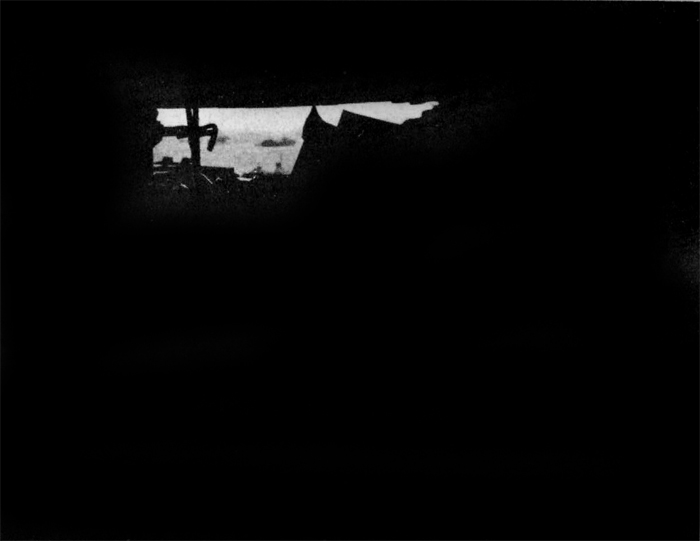
BLOCKHOUSE CONTAINING 25MM MACHINE GUNS IN TA 165 N SLIGHTLY DAMAGED BY NEW YORK (6): FIELD OF FIRE AND VIEW FROM LOOKOUT TOWER.
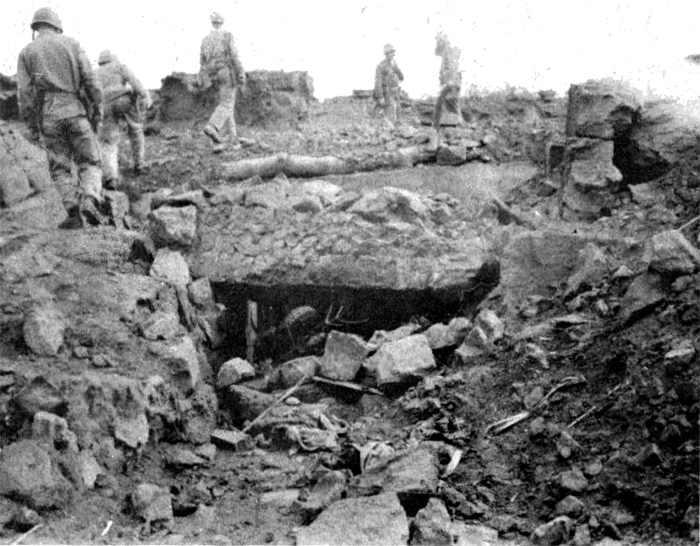
47MM A.T. GUN EMPLACEMENT IN TA 166 D DESTROYED BY IDAHO
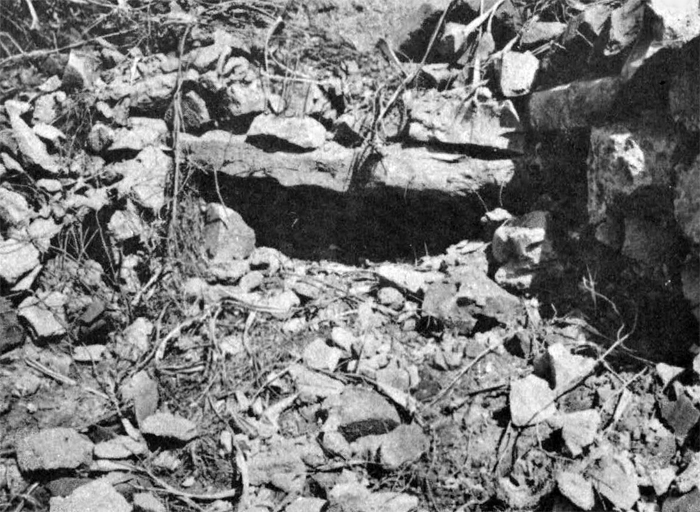
PILLBOX CONTAINING 25MM GUN IN TA 166 D - UNDAMAGED
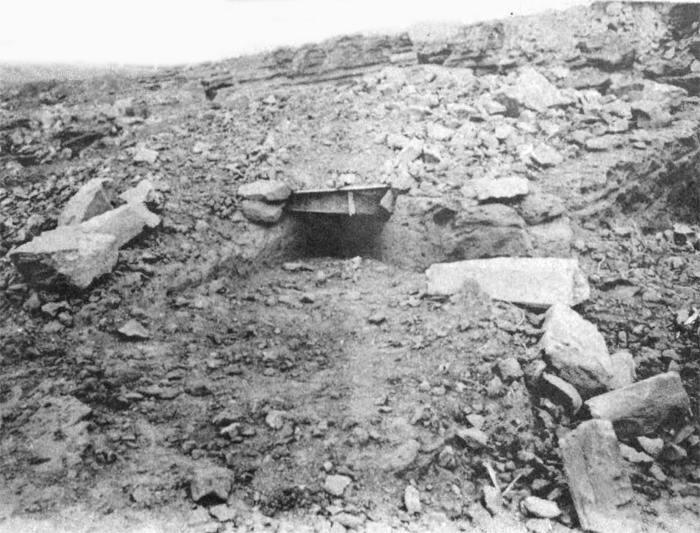
PILLBOX IN TA 166 E - UNDAMAGED
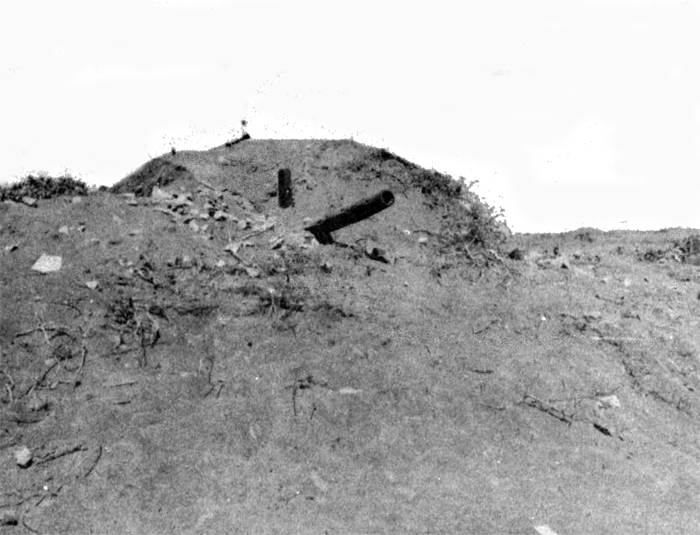
DUMMY EMPLACEMENT IN TA 166 A

FIELD OF FIRE FROM PILLBOX TA 166 D (SEE ABOVE)
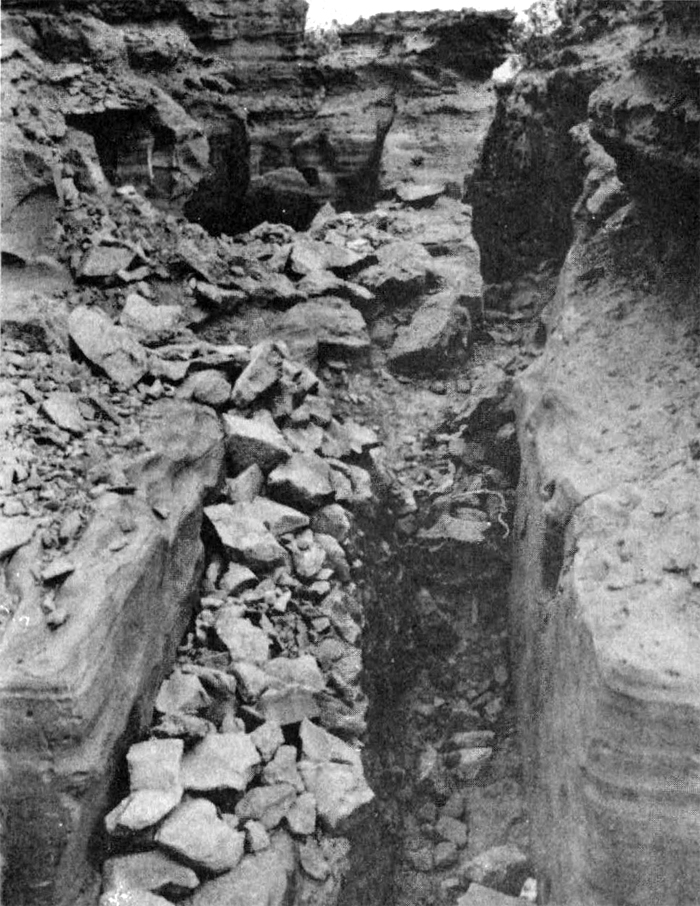
TRENCH FOR ENTRANCE INTO REAR OF PILLBOX IN TA 166 E
(SEE ABOVE)
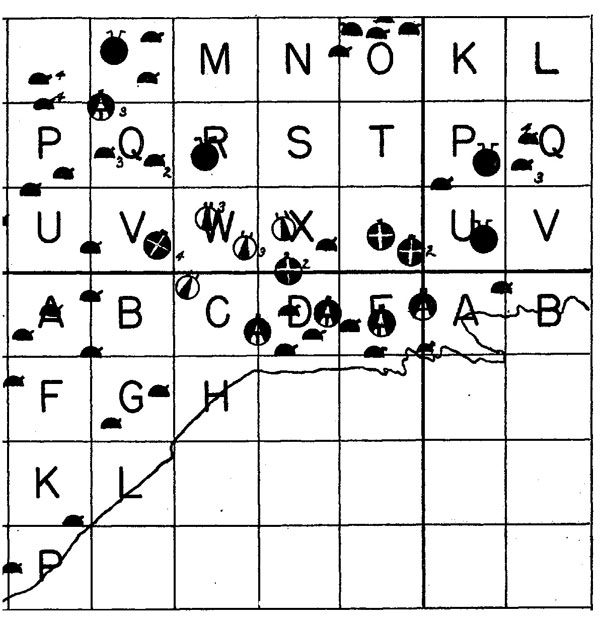

PORTION OF 166, 167, 187 & 184

CD. EMPLACEMENTS
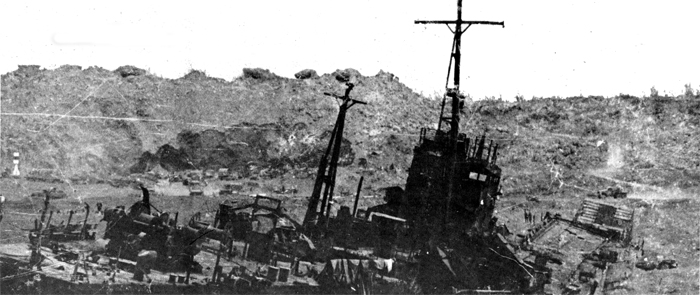
THIS PICTURE OF THE TERRAIN (TA 183
U V W) - (166 B C D) ON THE RIGHT
FLANK OF THE LANDING BEACHES SHOWS
THE EFFECT OF THE TREMENDOUS AMOUNT
OF PRELIMINARY NAVAL GUNFIRE AND
BOMBING ON THE TERRAIN. THE UPPER
VIEW WAS TAKEN PRIOR TO THE PRELIMINARY BOMBARDMENT WHILE THE LOWER
VIEW WAS TAKEN AFTER THE LANDING.
COMPARE THE EMPLACEMENTS OF THE
COAST DEFENSE BATTERY LOCATED ON
THE RIM OF THE QUARRY BEFORE, AND
AFTER THE BOMBARDMENT.
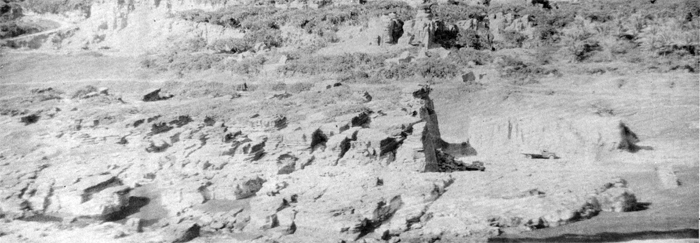
TA 183 X Y
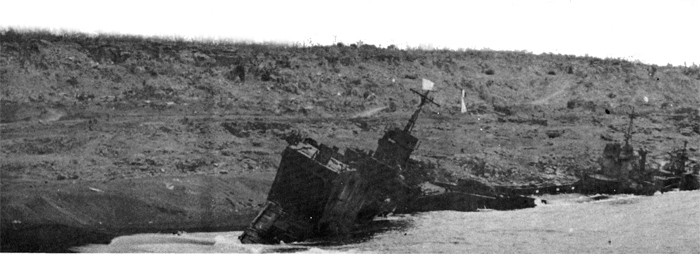
166 D E
THESE PICTURES OF TA 183 X Y, 166 D E ILLUSTRATE THE EFFECT OF THE PRELIMINARY NAVAL GUNFIRE ON THE TERRAIN ON THE RIGHT FLANK OF THE LANDING BEACH. THE UPPER VIEW WAS TAKEN PRIOR TO THE PRELIMINARY BOMBARDMENT WHILE THE LOWER VIEW WAS TAKEN AFTER THE PRELIMINARY BOMBARDMENT.

FIELD OF FIRE FROM TOP OF QUARRY TA 183 V, W.
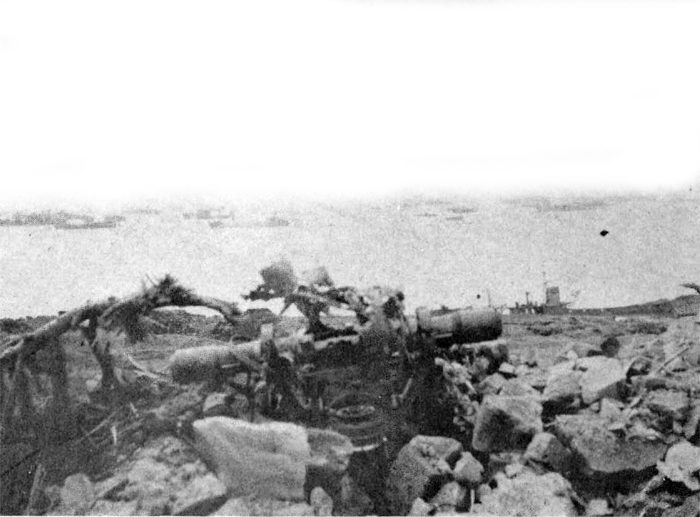
RANGE FINDER AND FIELD OF FIRE OF BATTERY

VIEW OF EMPLACEMENTS ON TOP OF QUARRY AFTER BOMBARDMENT.

CLOSE UPS OF THE WEST GUN OF THE BATTERY (1) (NOTE THICKNESS OF CONCRETE)
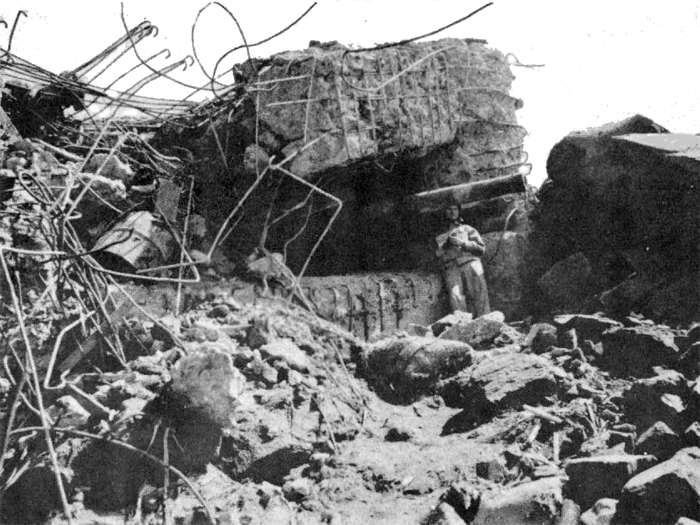
CLOSE UPS OF THE WEST GUN OF THE BATTERY (2)

CLOSE UPS OF THE WEST GUN OF THE BATTERY (3)
VIEWS OF THE 4 - GUN, 120MM COAST DEFENSE BATTERY LOCATED ON TOP OF THE QUARRY ON THE RIGHT FLANK OF THE LANDING BEACH (TA 183'V,W.) DESTROYED BY IDAHO.
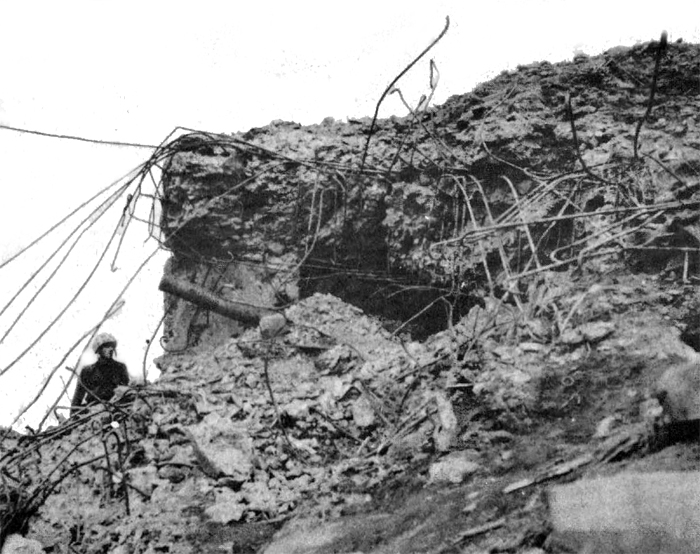
120 MM C.D. GUN EMPLACEMENTS ON TOP OF QUARRY (1).
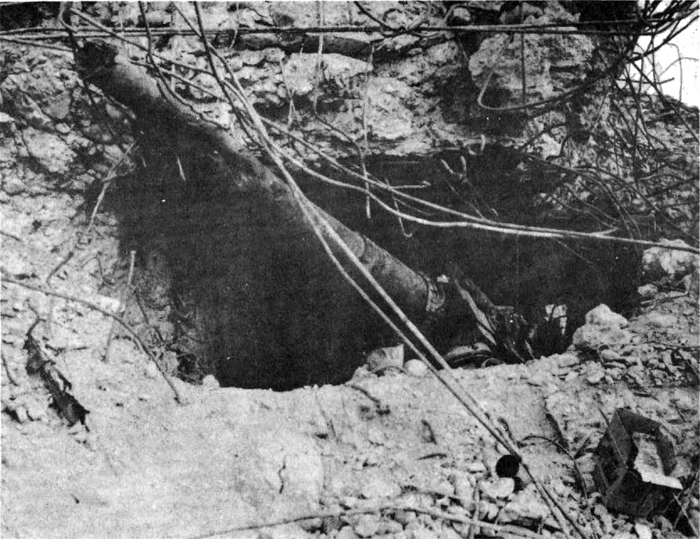
120 MM C.D. GUN EMPLACEMENTS ON TOP OF QUARRY (2).
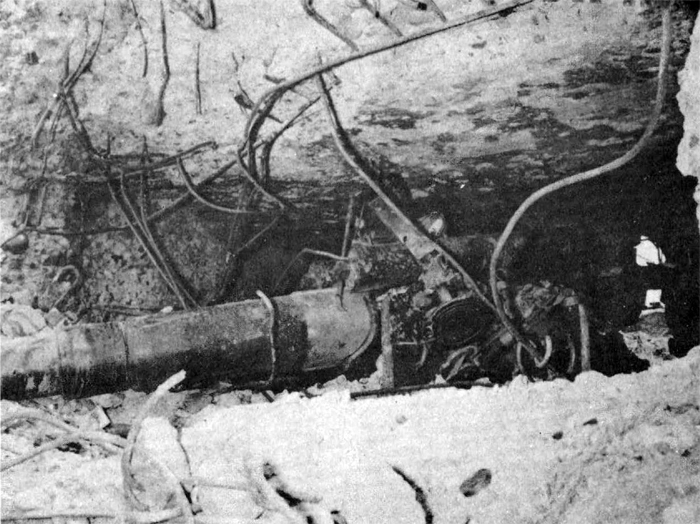
120 MM C.D. GUN EMPLACEMENTS ON TOP OF QUARRY (3).

120 MM C.D. EMPLACEMENT ON TOP OF QUARRY.

VIEW OP THE TWO - 120 MM SHORT BARREL WEAPON EMPLACEMENTS IN TA 183 X
DESTROYED BY IDAHO (1).
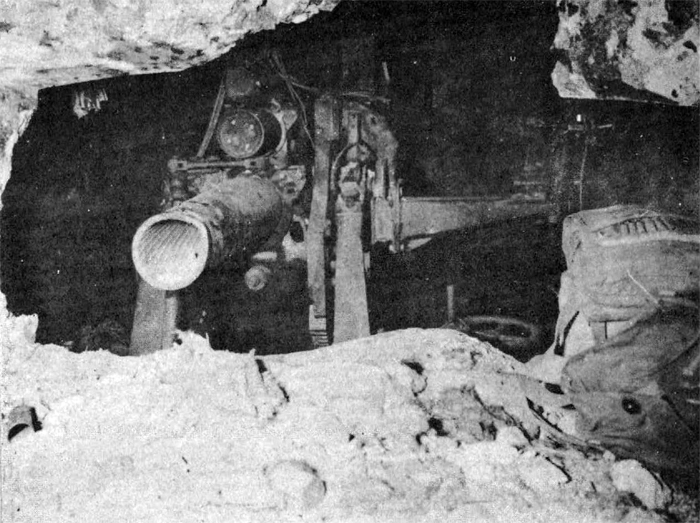
VIEW OP THE TWO - 120 MM SHORT BARREL WEAPON EMPLACEMENTS IN TA 183 X DESTROYED BY IDAHO (2).
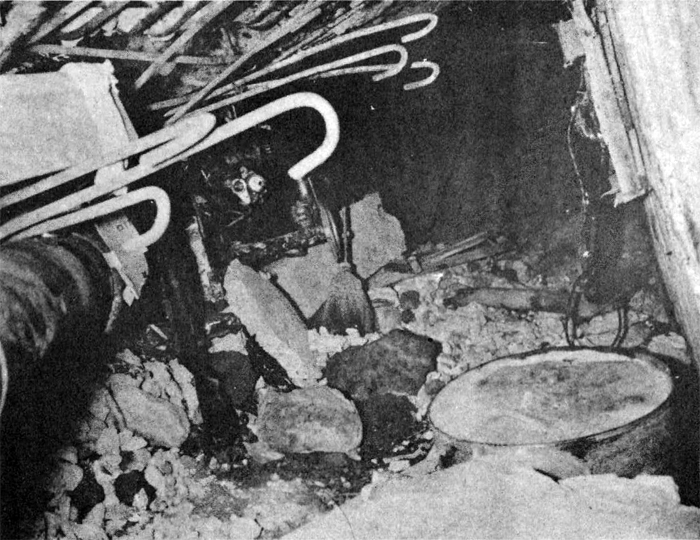
2 - 120 MM C.D. GUNS IN 183 Y - DESTROYED BY IDAHO (1).
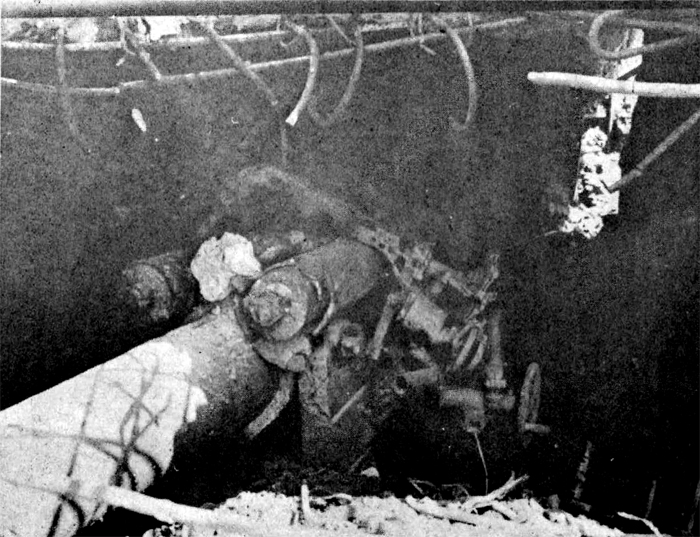
2 - 120 MM C.D. GUNS IN 183 Y - DESTROYED BY IDAHO (2).

2 - 120 MM C.D. GUNS IN 183 Y - DESTROYED BY IDAHO (3).

75 MM A.T. GUN - TA 167 A DESTROYED
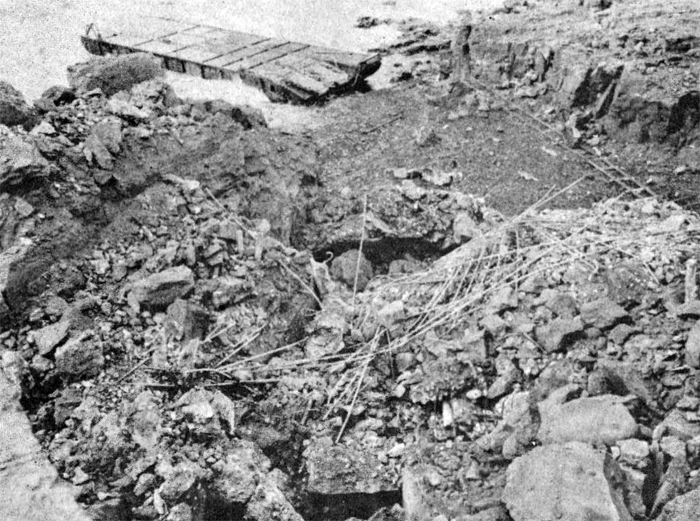
PILLBOX CONTAINING 47 MM A.T. GUNS IN TA 166 D - DESTROYED (1).
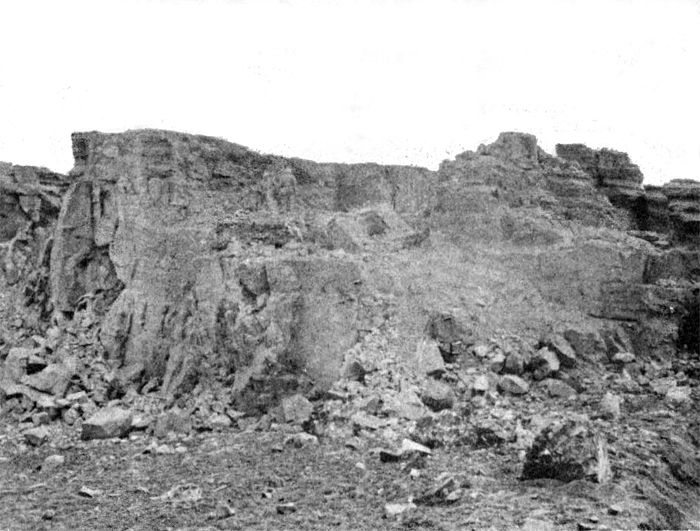
PILLBOX CONTAINING 47 MM A.T. GUNS IN TA 166 D - DESTROYED (2).
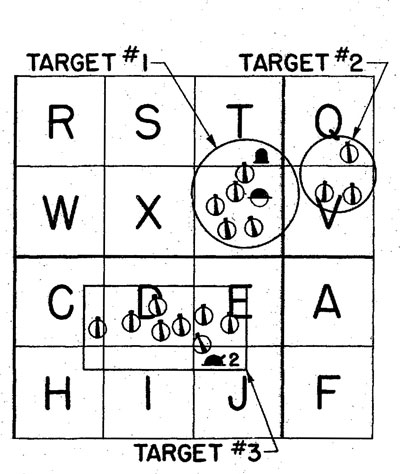
PORTION OF 200, 201, 183, 184
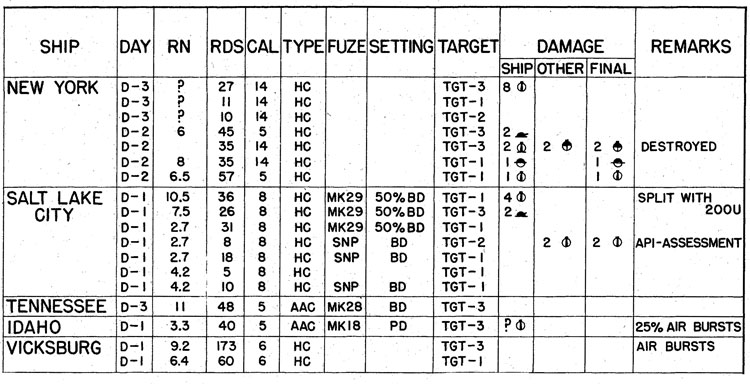
This study of special targets shows the effect of NGF on AA Installations. In addition to Ammunition located below, additional NGF Artillery and Bombing were fired on these targets, showing large amounts of Ammunition, necessary for destruction.
TOTALS: 118 RDS 14" - 134 RDS 8" - 233 RDS 6" - 190 RDS 5"

75 MM AA BATTERY IN TA 183 C.D.E. (TARGET NO. 3) (1)

75 MM AA BATTERY IN TA 183 C.D.E. (2)
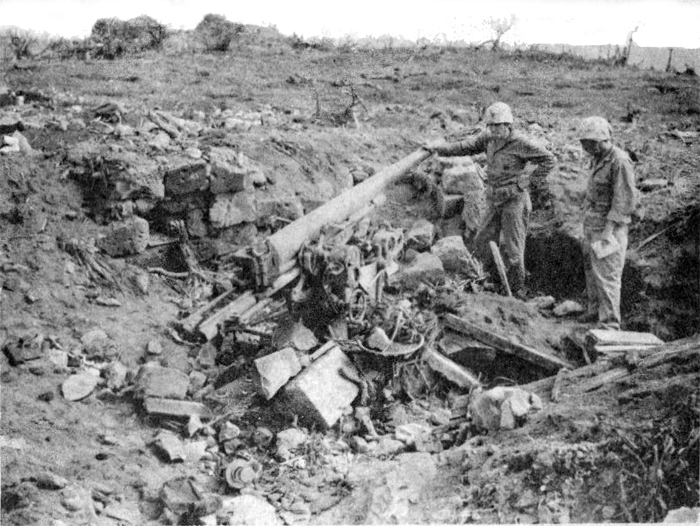
75 MM AA BATTERY IN TA 183 C.D.E. (3)
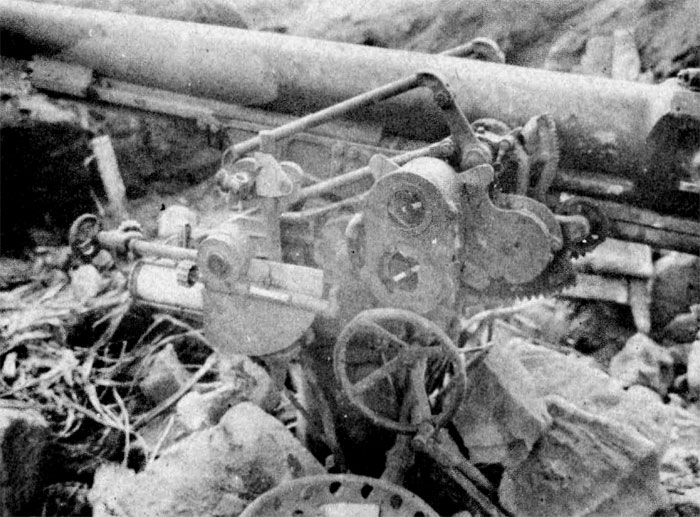
75 MM AA BATTERY IN TA 183 C.D.E. (4)
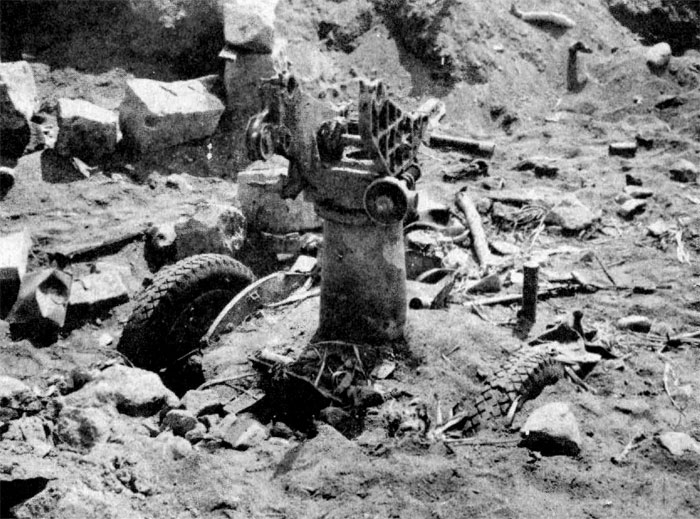
75 MM AA BATTERY IN TA 183 C.D.E. (5)

75 MM AA BATTERY IN TA 183 C.D.E. (6)

VIEWS OF POSITIONS LOCATED IN TARGET #1 (1): RADAR ANTENNA LOCATED IN TA 200 Y DESTROYED BY NEW YORK.

VIEWS OF POSITIONS LOCATED IN TARGET #1 (2): VIEW OF RADAR HILL 382
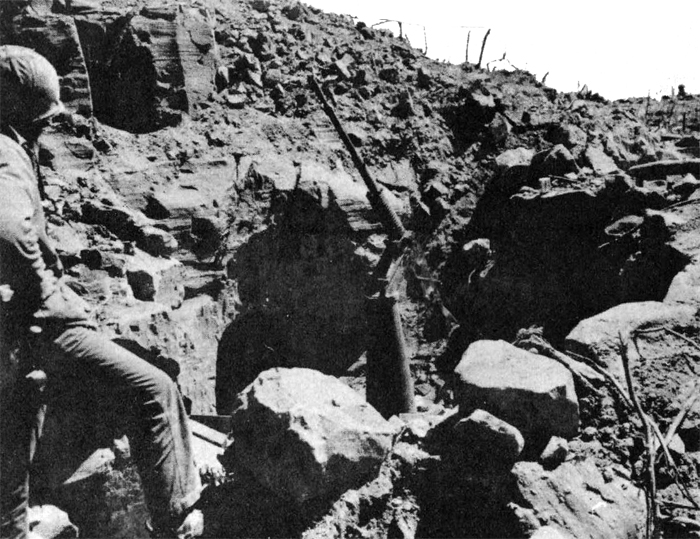
VIEWS OF POSITIONS LOCATED IN TARGET #1 (3): 13 MM POSITION IN TA 183 C.- NOTE CAVE ENTRANCE LEADING OUT OP POSITION.

VIEWS OF POSITIONS LOCATED IN TARGET #1 (4): ALTERNATE POSITION FOR 47 MM A.T. GUN IN TA 183 C.

VIEWS OF POSITIONS LOCATED IN TARGET #1 (5): 13 MM POSITION IN TA 183 C.

VIEWS OF POSITIONS LOCATED IN TARGET #1 (6): 25 MM POSITION IN TA 200 Y.
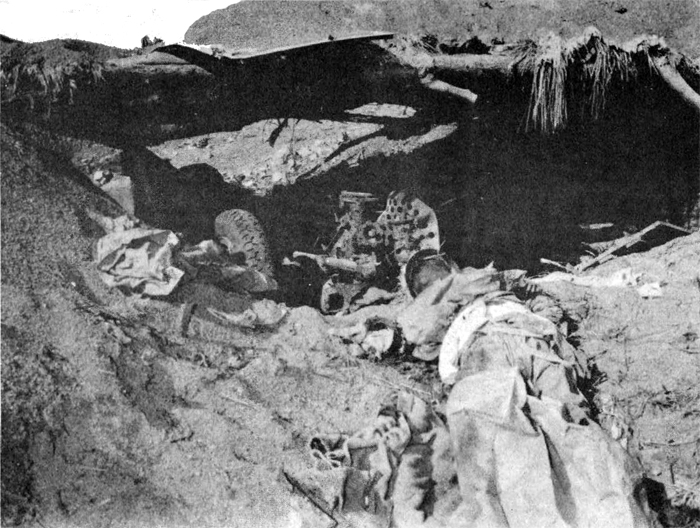
REAR VIEW OF 47 MM A.T. GUN SIGHTED DOWN RUNWAY OF NO 1 AIRFIELD ( TA 182 X) UNDAMAGED
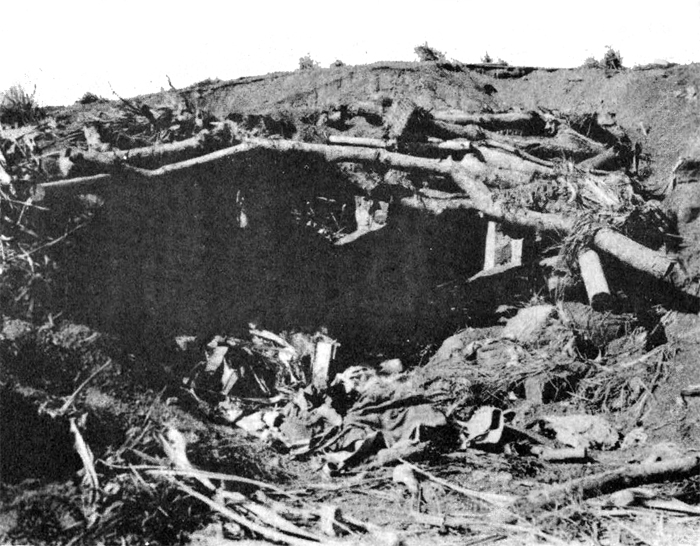
FRONT.VIEW OF 47 MM A. T. GUN
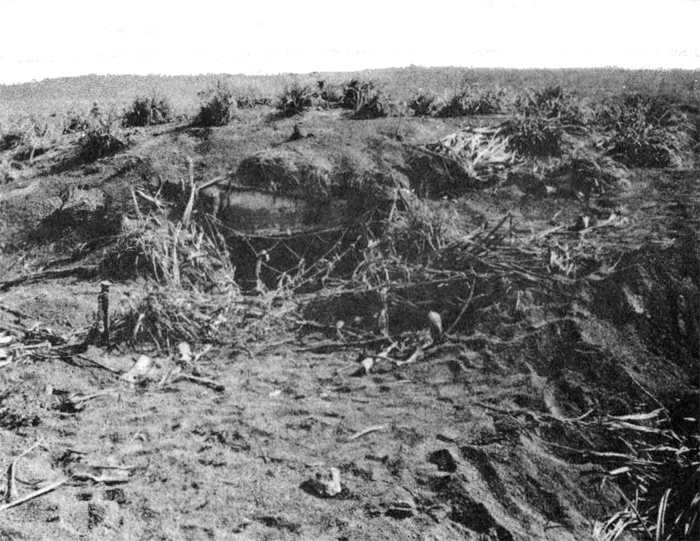
PILLBOX SIGHTED DOWN RUNWAY OF NO 1 AIRFIELD ( TA 182 X ) UNDAMAGED
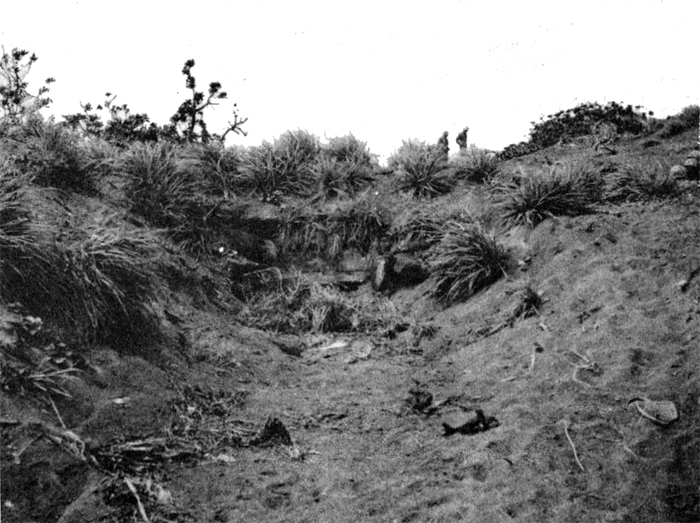
FRONT VIEW OF PILLBOX IN TA 185 U SHOWING FIRE LANE -POSITION UNDAMAGED
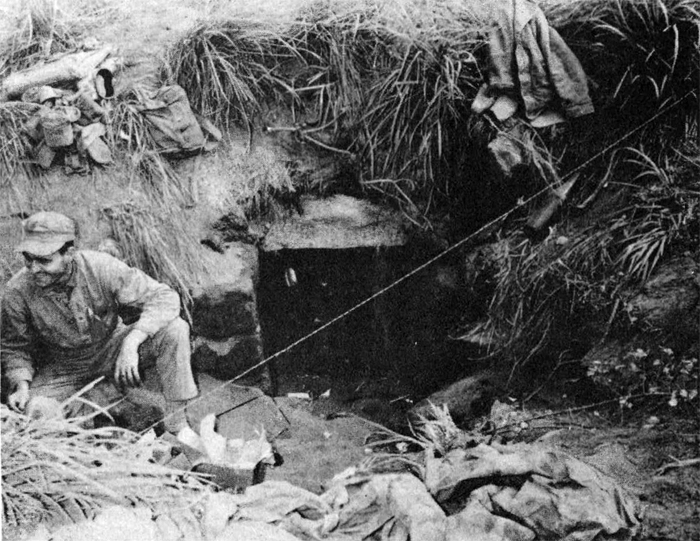
REAR ENTRANCE TO PILLBOX IN TA 183 U
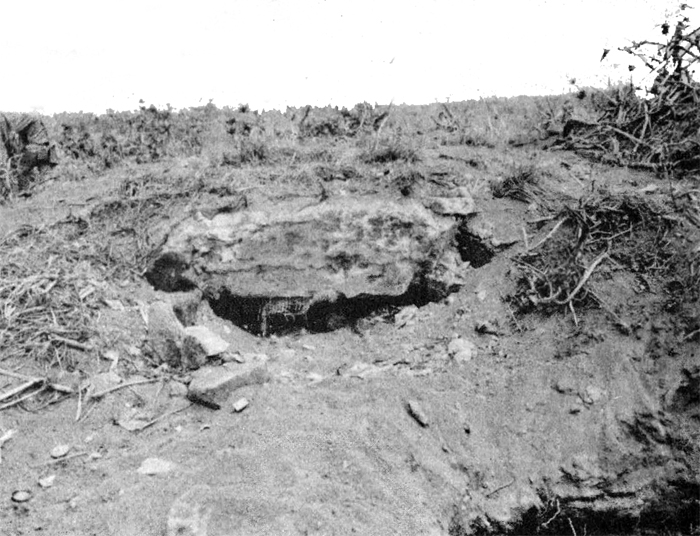
FRONT OF PILLBOX IN 183 Q. NOTE DAMAGE TO FIRE PORT.
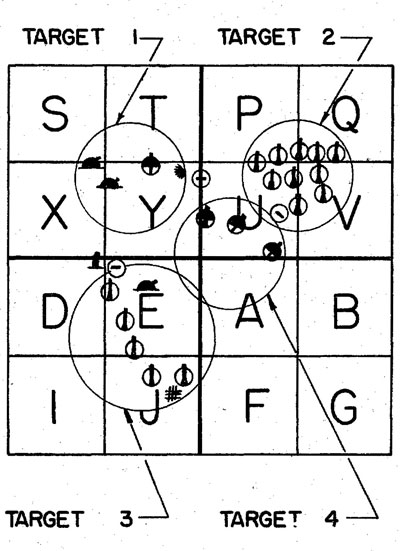
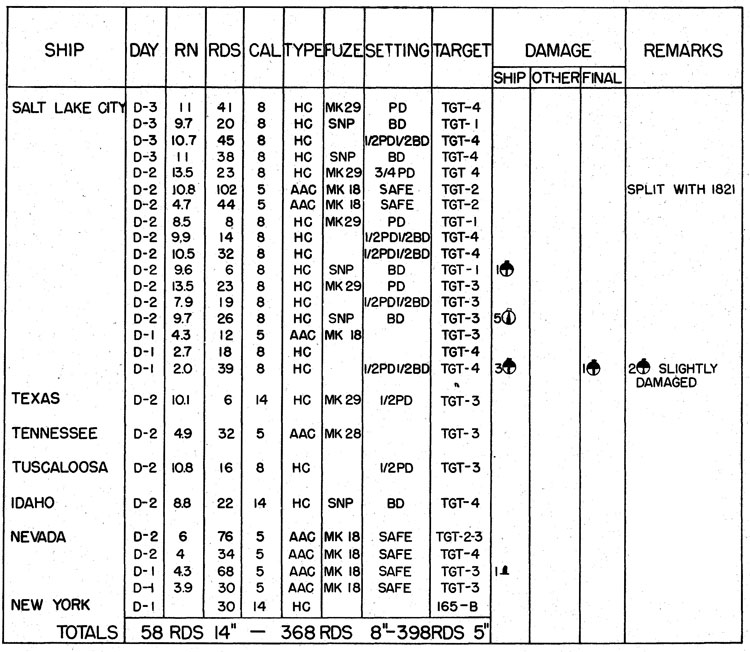

4 - 120 MM D.P. BATTERY IN TA. 182 U (1).
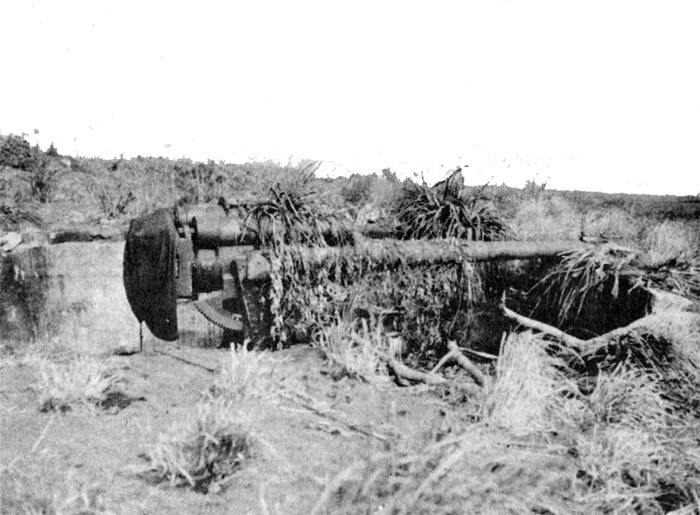
4 - 120 MM D.P. BATTERY IN TA. 182 U (2).
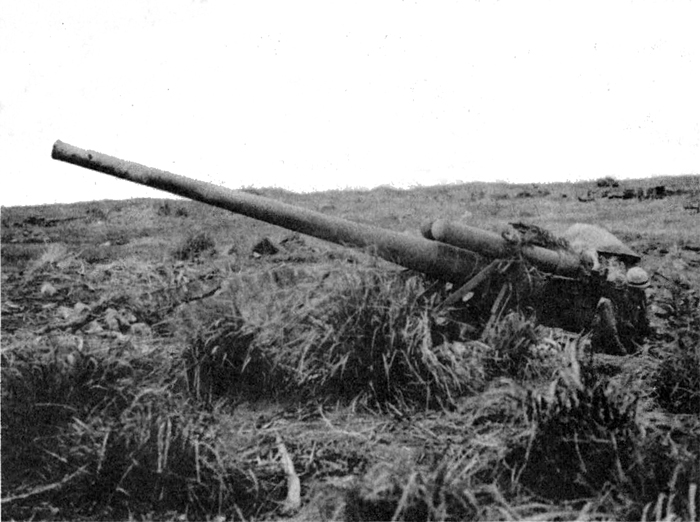
4 - 120 MM D.P. BATTERY IN TA. 182 U (3).
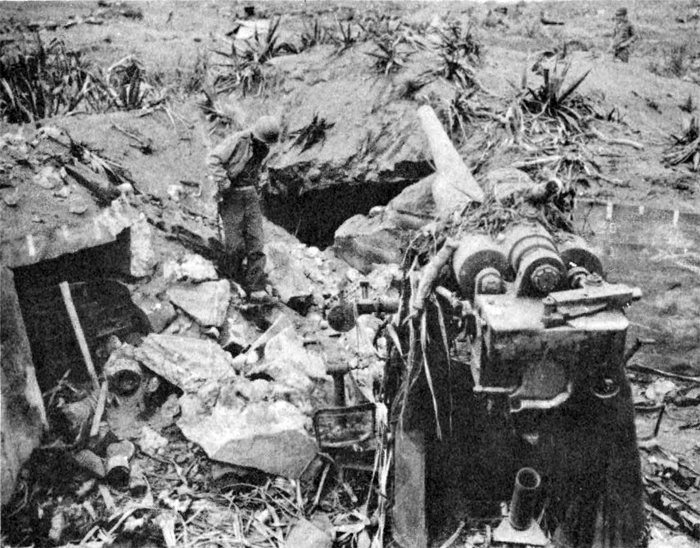
4 - 120 MM D.P. BATTERY IN TA. 182 U (4).
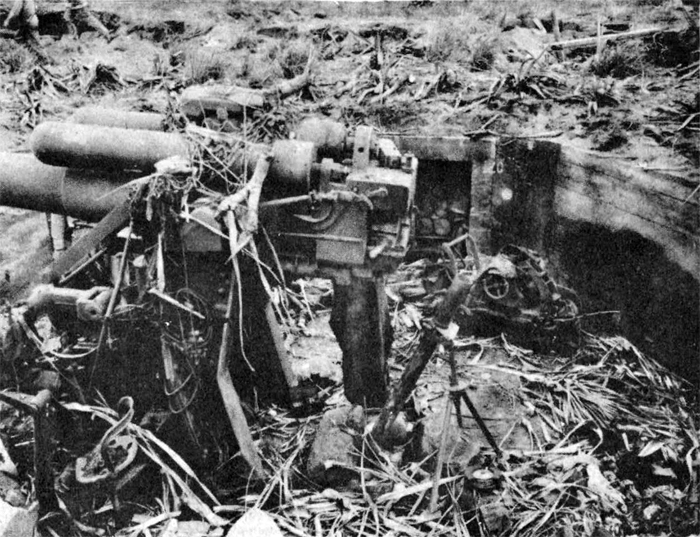
4 - 120 MM D.P. BATTERY IN TA. 182 U (5).
284 ROUNDS 8 INCH FIRED AT THIS BATTERY DURING
PRELIMINARY BOMBARDMENT. RESULTS - 1 GUN DAMAGED; DATA TRANSMISSION SYSTEMS INOPERATIVE; BATTERY INOPERATIVE FOR A.A. BUT CAPABLE OF LOCAL CONTROL FIRING. IT IS BELIEVED THAT THE PERSONNEL WERE PREVENTED FROM USING THIS BATTERY IN LOCAL CONTROL DUE
TO HEAVY NEUTRALIZATION FIRE ON D-DAY.

PORTION OF TA 199 & 200. This 120-mm D.P. battery was not captured until about D+9. A considerable amount of additional gunfire as well as artillery and bombing was delivered on this battery.

5 GUN - 120 MM D.P. BATTERY LOCATED IN 199 0 (1).
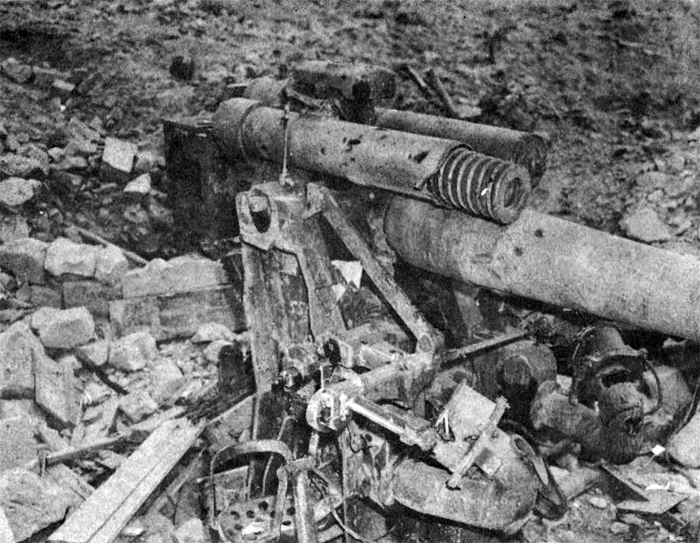
5 GUN - 120 MM D.P. BATTERY LOCATED IN 199 0 (2).
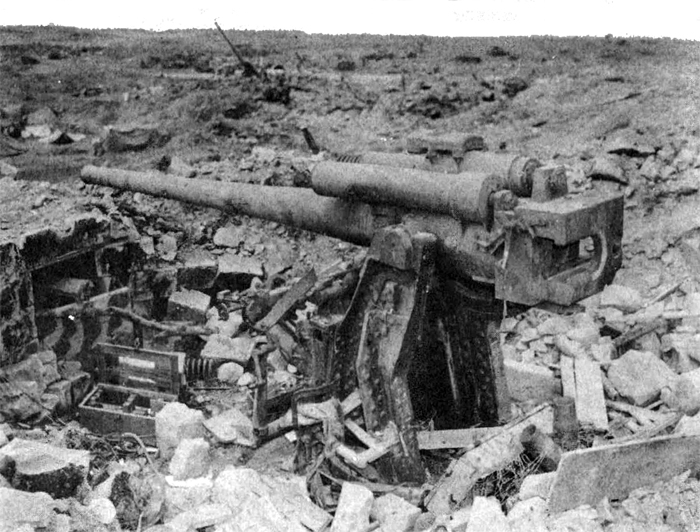
5 GUN - 120 MM D.P. BATTERY LOCATED IN 199 0 (3).

5 GUN - 120 MM D.P. BATTERY LOCATED IN 199 0 (4).
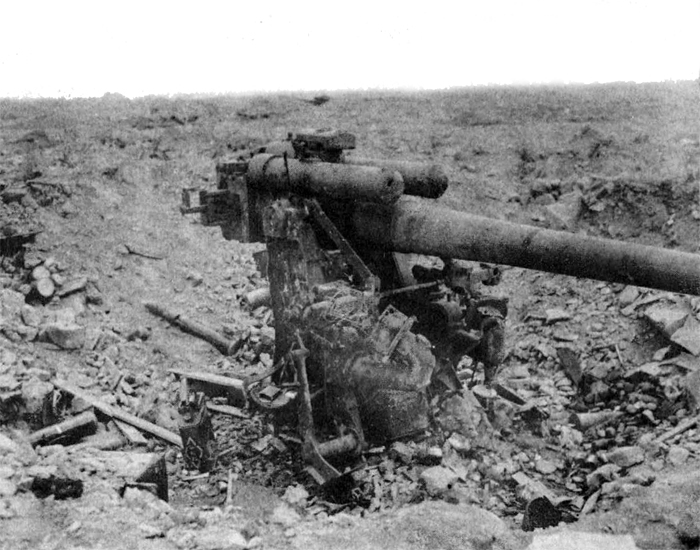
5 GUN - 120 MM D.P. BATTERY LOCATED IN 199 0 (5).
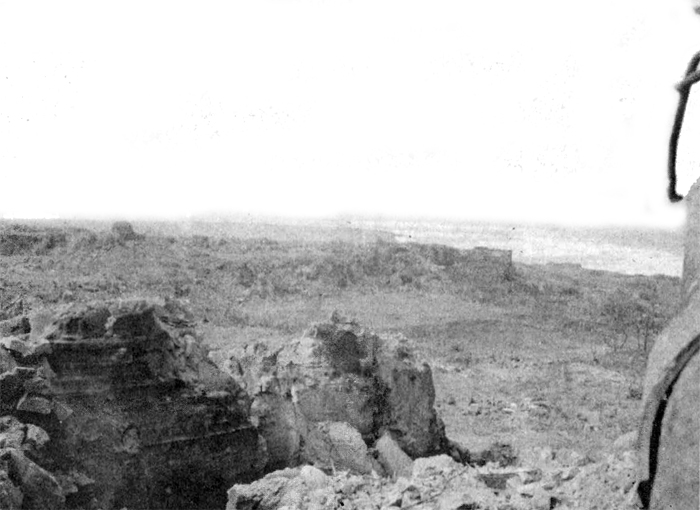
6" COAST DEFENSE GUNS LOCATED IN TA 216 D (1): FIELD OF FIRE FROM GUN POSITION. NOTE HOW THE POSITION COMMANDS WESTERN BEACHES.

6" COAST DEFENSE GUNS LOCATED IN TA 216 D (2): REAR VIEW OF EMPLACEMENT.
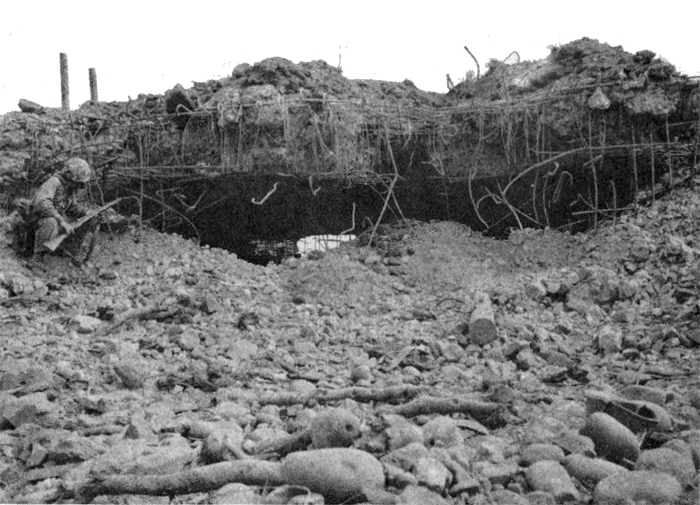
6" COAST DEFENSE GUNS LOCATED IN TA 216 D (3): SECOND GUN OF BATTERY.
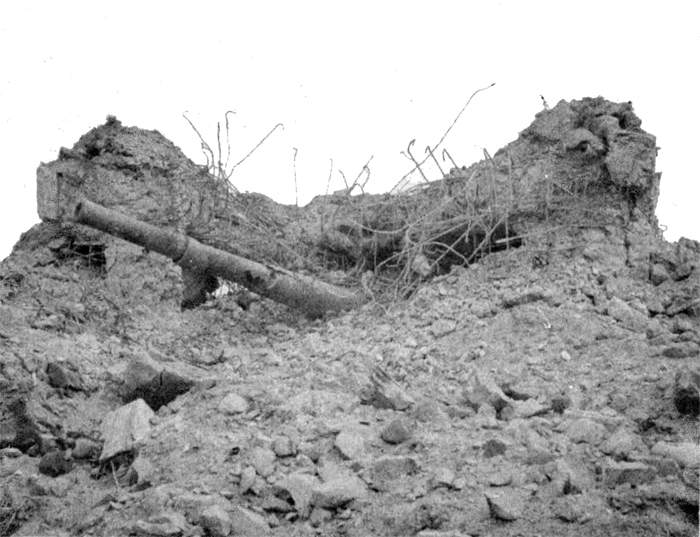
6" COAST DEFENSE GUNS LOCATED IN TA 216 D (4): FRONTAL VIEW OF GUN.
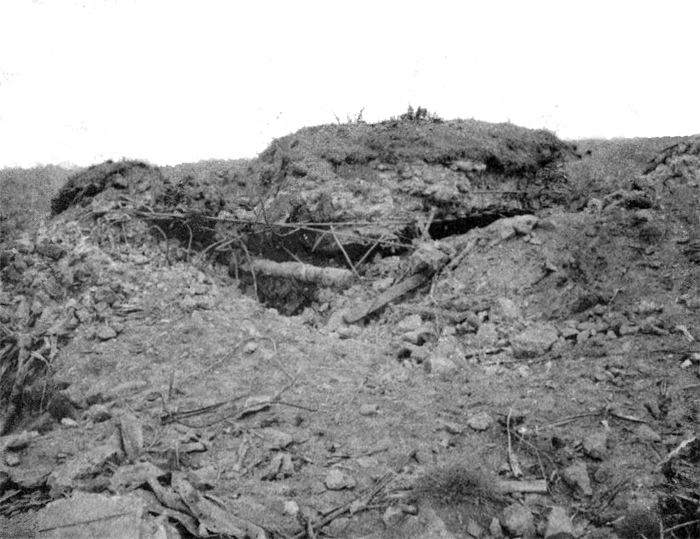
6" COAST DEFENSE GUNS LOCATED IN TA 216 D (5): RANGE FINDER AND FIRE CONTROL EQUIPMENT OF BATTERY.
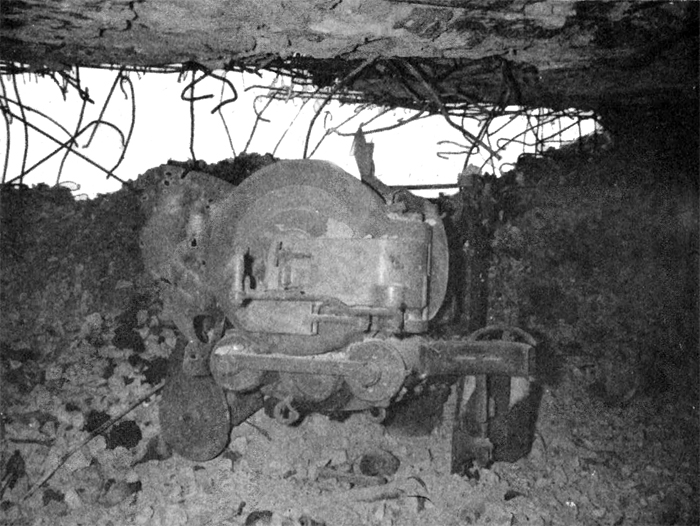
6" COAST DEFENSE GUNS LOCATED IN TA 216 D (61): VIEW OF THE INTERIOR OF ABOVE
EMPLACEMENT
THE BATTERY WAS NOT FIRED UPON UNTIL DOG-DAY. ARTILLERY, AIR AND NAVAL GUNFIRE WERE EMPLOYED TO DESTROY THIS POSITION.
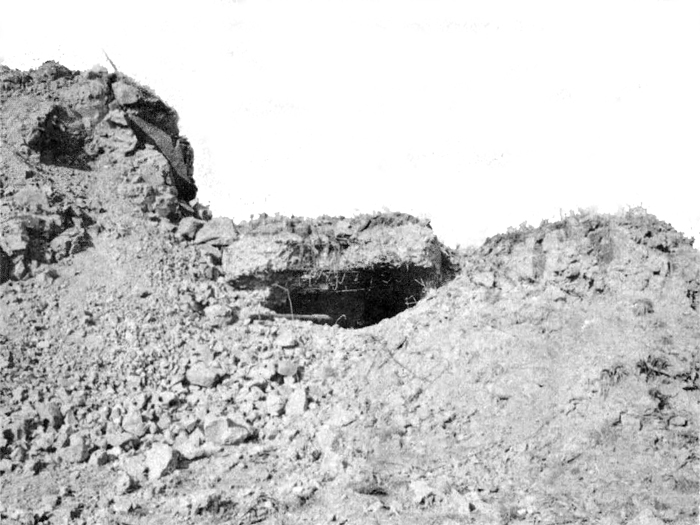
VIEWS OF 120MM POSITIONS LOCATED IN TA 216 G (1): VIEW OF CASEMATED POSITION

VIEWS OF 120MM POSITIONS LOCATED IN TA 216 G (2): OPEN MOUNT POSITION - NOTE FRAGMENTATION DAMAGE TO BARREL.

VIEWS OF 120MM POSITIONS LOCATED IN TA 216 G (3): TUNNEL LEADING PROM CASEMATED POSITION INTO AMMUNITION STORAGE ROOMS AND CREWS LIVING QUARTERS.

VIEWS OF 120MM POSITIONS LOCATED IN TA 216 G (4): SIDE VIEW OF CASEMATED POSITION

VIEWS OF 120MM POSITIONS LOCATED IN TA 216 G (5): INTERIOR VIEW OF CASEMATED GUN POSITION.
THIS BATTERY WAS FIRED ON BY THE TUSCALOOSA ON D - 1 and D - 2. THE BATTERY WAS STILL OPERATIVE AFTER THE LANDING AND WAS DESTROYED BY A COMBINATION OF ARTILLERY AND NAVAL GUNFIRE.


These AA Batteries located in the northern portion of the island were fired on areas indicated during the preliminary bombardment. TOTALS: 17 RDS 14" - 299 RDS 8" - 525 RDS 6" - 511 RDS 5"
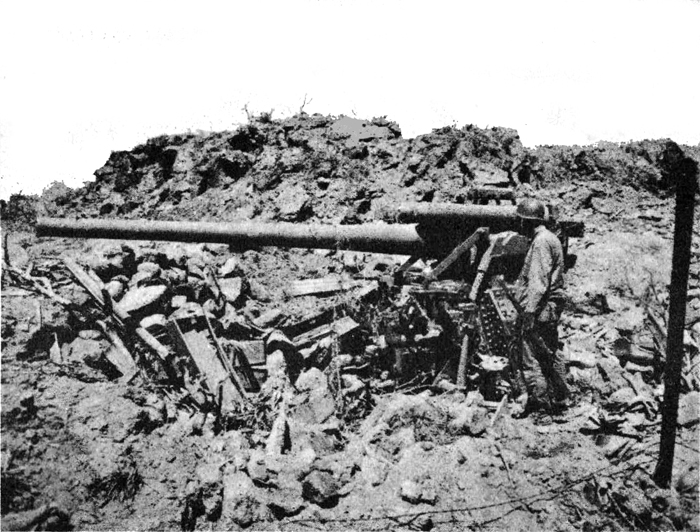
6 GUN - 120MM D.P., BATTERY IN TA 235 (1) - (NOTE VULNERABILITY OF COUNTER RECOIL SYSTEM)
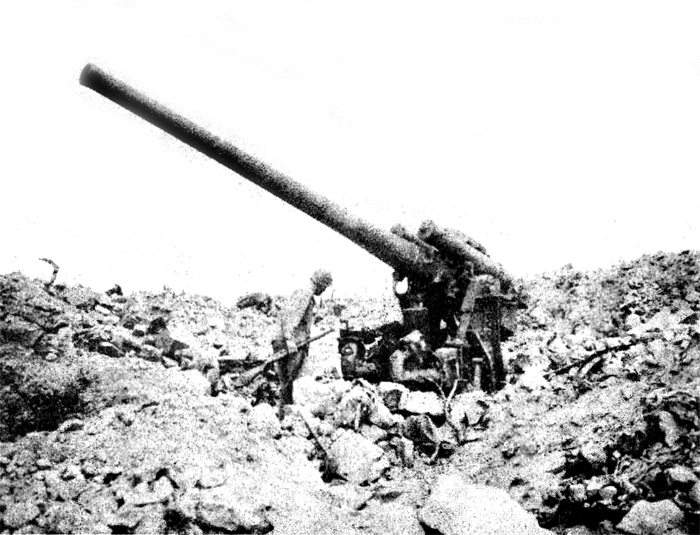
6 GUN - 120MM D.P., BATTERY IN TA 235 (2)
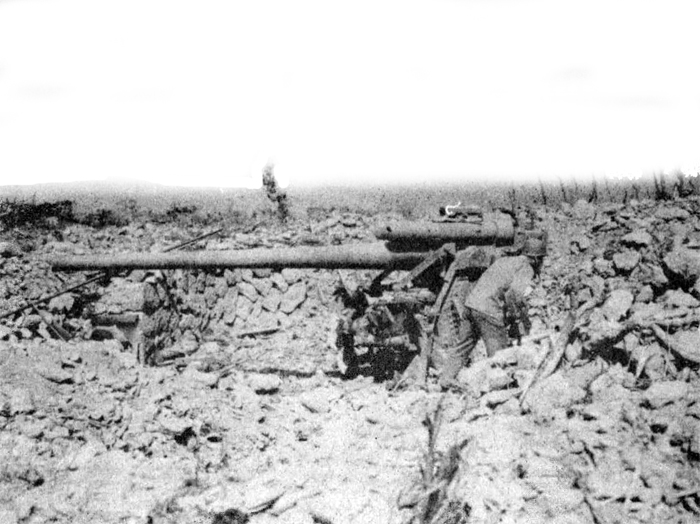
6 GUN - 120MM D.P., BATTERY IN TA 235 (3)

6 GUN - 120MM D.P., BATTERY IN TA 235 (4)
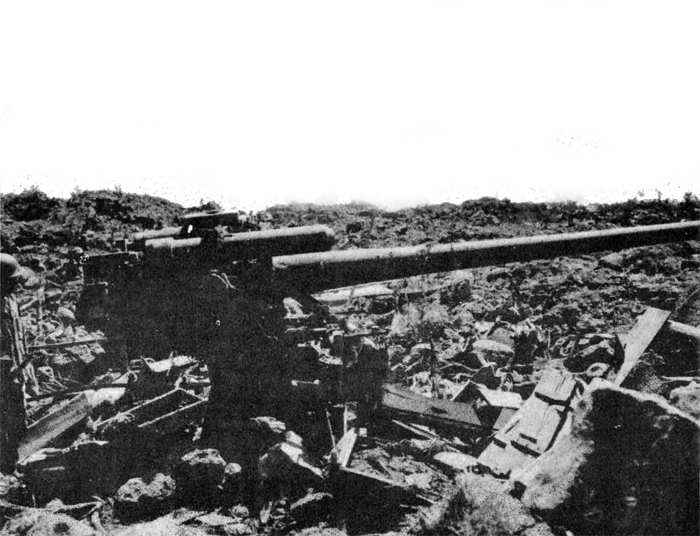
6 GUN - 120MM D.P., BATTERY IN TA 235 (5)
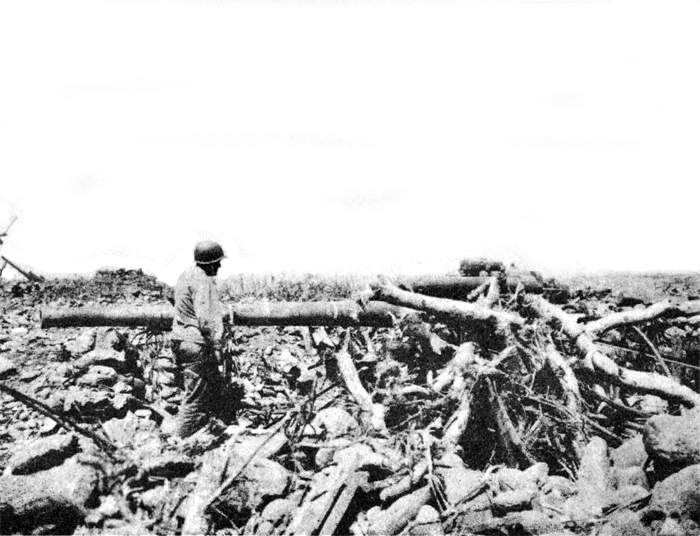
6 GUN - 120MM D.P., BATTERY IN TA 235 (6)
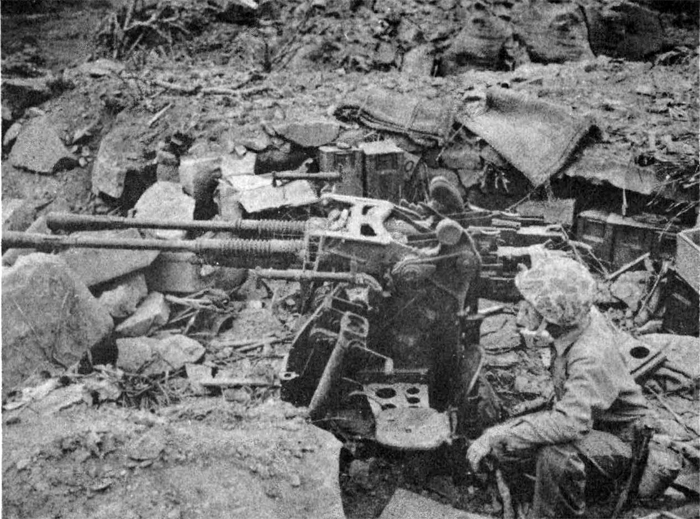
PORTION OF 25MM. TWIN AND SINGLE MOUNTS PROTECTING 12OMM. D.P. AND 75MM. AA BATTERIES IN TA. 235 (1).
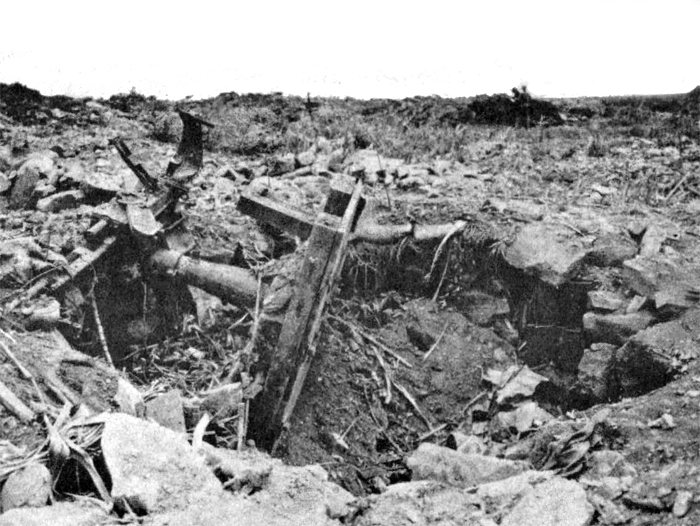
PORTION OF 25MM. TWIN AND SINGLE MOUNTS PROTECTING 12OMM. D.P. AND 75MM. AA BATTERIES IN TA. 235 (2).
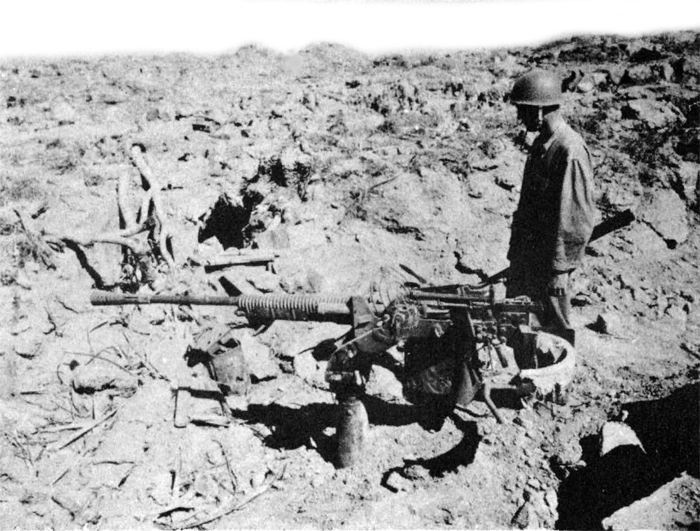
PORTION OF 25MM. TWIN AND SINGLE MOUNTS PROTECTING 12OMM. D.P. AND 75MM. AA BATTERIES IN TA. 235 (3).

PORTION OF 25MM. TWIN AND SINGLE MOUNTS PROTECTING 12OMM. D.P. AND 75MM. AA BATTERIES IN TA. 235 (4).
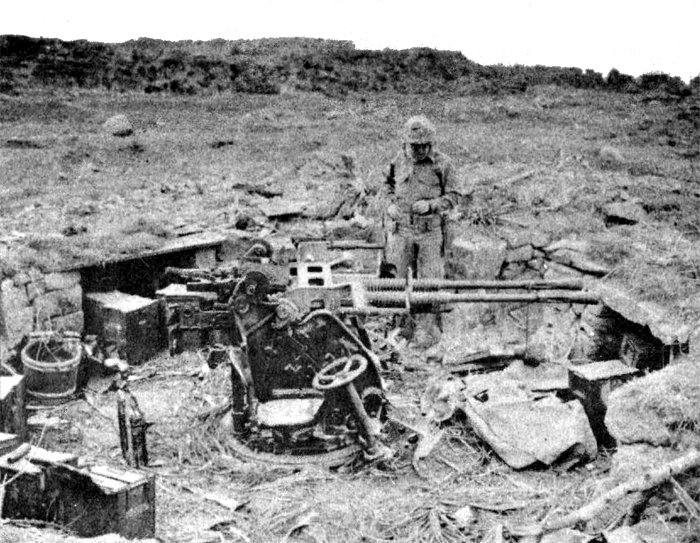
PORTION OF 25MM. TWIN AND SINGLE MOUNTS PROTECTING 12OMM. D.P. AND 75MM. AA BATTERIES IN TA. 235 (5).
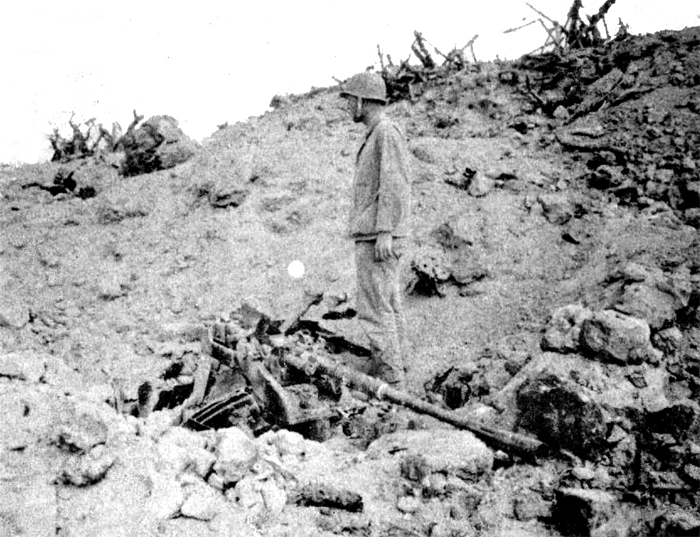
PORTION OF 25MM. TWIN AND SINGLE MOUNTS PROTECTING 12OMM. D.P. AND 75MM. AA BATTERIES IN TA. 235 (6).
IN SPITE OF TREMENDOUS AMOUNT OF ALL TYPES OF BOMBARDMENT, NOTE RELATIVELY UNDAMAGED CONDITION OF SOME WEAPONS. SEE PAGE 36 FOR DETAILS OF AMMUNITION EXPENDITURE.
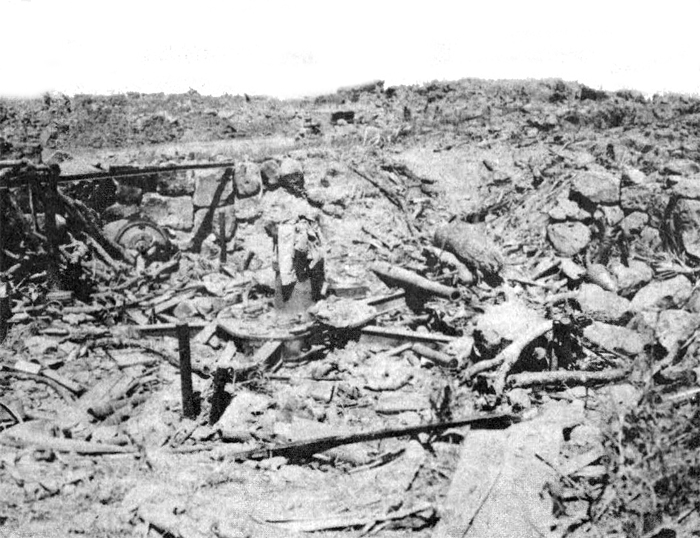
6 GUN - 75MM. AA. BATTERY IN TARGET AREA 235 (1).

6 GUN - 75MM. AA. BATTERY IN TARGET AREA 235 (2).
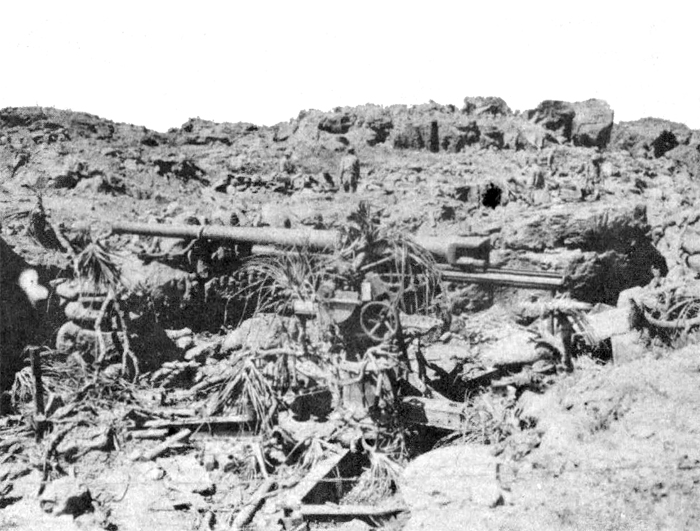
6 GUN - 75MM. AA. BATTERY IN TARGET AREA 235 (3).
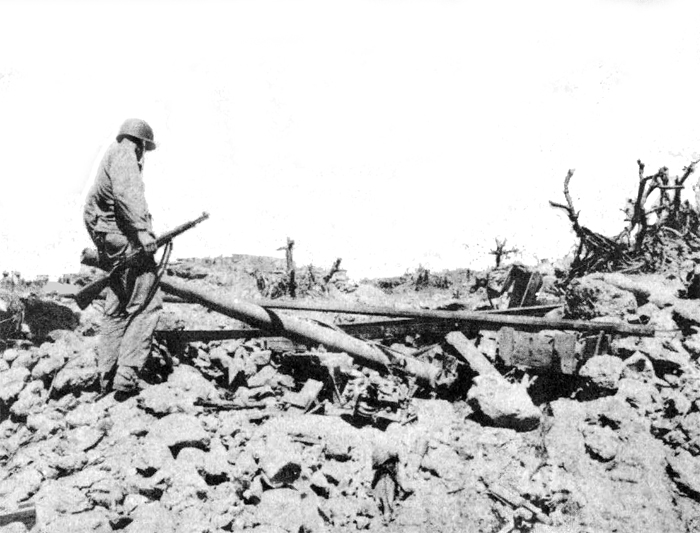
6 GUN - 75MM. AA. BATTERY IN TARGET AREA 235 (4).
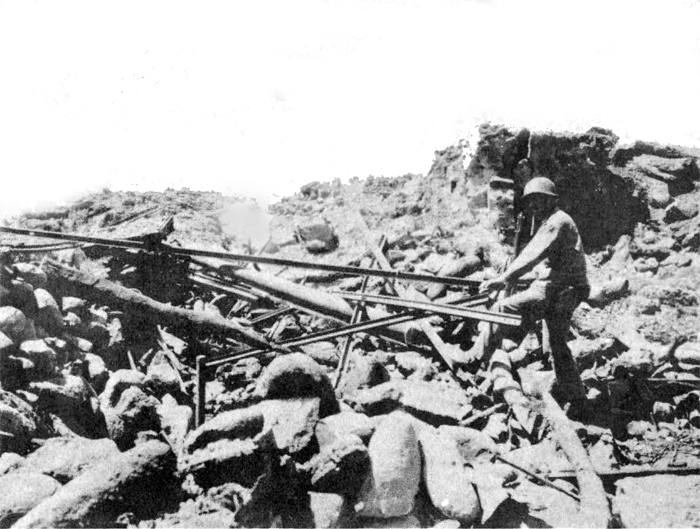
6 GUN - 75MM. AA. BATTERY IN TARGET AREA 235 (5).
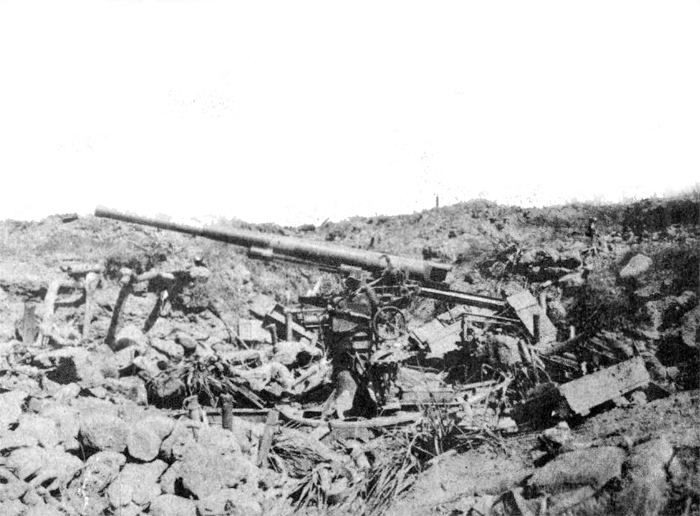
6 GUN - 75MM. AA. BATTERY IN TARGET AREA 235 (6).
